
Admin
-
Posts
7,448 -
Joined
-
Last visited
Content Type
Profiles
Forums
Events
Store
Gallery
Community Map
Posts posted by Admin
-
-
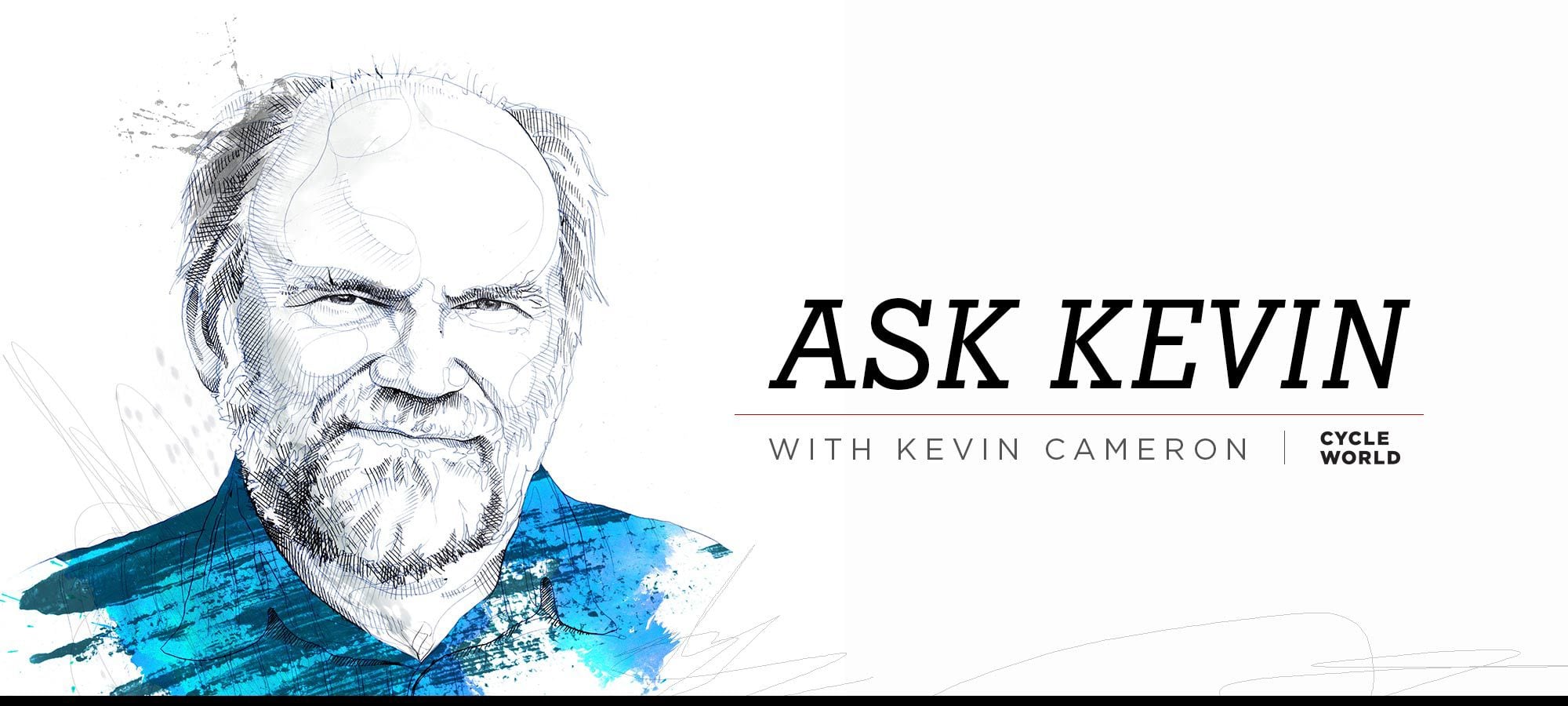
Kevin Cameron has been writing about motorcycles for nearly 50 years, first for <em>Cycle magazine</em> and, since 1992, for <em>Cycle World</em>. (Robert Martin/)Mike Baldwin once said, “I see a lot of riders crash and then act like they’re unconscious. When you crash, you’ve still got a lot of riding to do! Like fending off the bike so it can’t be the hammer that drives you into the bales.”
Another TZ750 rider from the 1970s, Miles Baldwin (no relation) described a fall this way: “There I am sliding and I notice parts of me are getting really hot. So I rolled over as I slid. That way, when I finally stopped, I was done to a turn.” Always a lover of words, he grinned in appreciation of the pun.
Gary Fisher, talented son of 1950s AMA racer Ed Fisher, found himself sliding up the Pocono straight in a crowd of fast-moving bikes. He said, “I rolled up in a ball for two reasons. First was to make myself a smaller target. Second was so I wouldn’t slow down so quickly, so if I did get hit, it wouldn’t be so hard.
There’s plenty of riding left to be done as crashes happen.
MotoGP rider Marc Márquez used to crash often enough in practice to make me wonder if he’d made crashing into a learning tool. Then a slo-mo video of one of his crashes offered a possible new perspective. There is the bike, sliding on its side, Márquez still aboard with his hands on the bars. Does he really “un-crash” the bike? Is it pure accident? The front end turns, putting the tire back in contact with the pavement—forcibly enough that the machine flips back upright with a hard shake that fails to unseat the rider. And he rides on.
At the 1990 USGP at Laguna Seca, when Eddie Lawson realized his front brake pads had fallen out, he put his bike on the ground instantly to scrub off as much velocity as possible before hitting the wall. A foot injury was the only result. A mechanic had failed to secure the pad retention pins.
Many a non-racing motorcyclist can tell similar stories illustrating the value of continuing to think and act in a crisis.
An example from aviation dates to World War II, as a TB-29 climbed through 8,800 feet on a US training flight. A scanner aft reported an engine fire, with flames streaming back nearly to the tail. All knew it would shortly heat the wing’s aluminum main spar enough to weaken and collapse it. Carbox bottles were useless against a big engine fire.
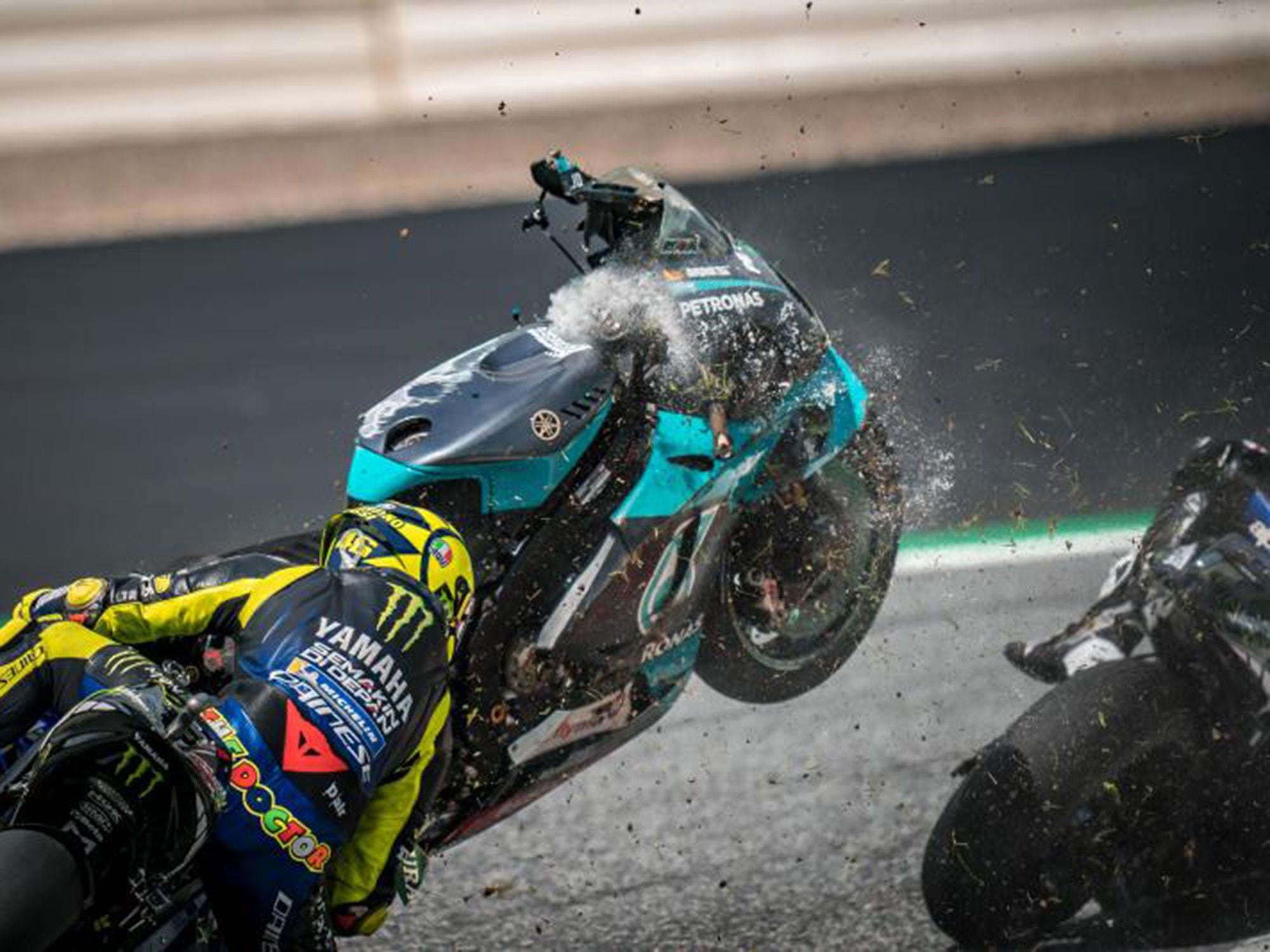
There’s plenty of riding left to be done as crashes happen. (MotoGP /)No action from the cockpit. The flight engineer (FE), who faces aft in that aircraft, jumped up to investigate. The pilot was capering around the flight deck, hysterically shouting for his parachute. The co-pilot gripped his yoke, rigid with fear. The bombardier was struggling up out of his position in the nose. The FE calmed the pilot: “Sir, you are wearing your parachute.”
Next he suggested the pilot might ring the bail-out bell, depressurize the aircraft, and drop the nosewheel, so the cockpit escape hatch (through the nosewheel retraction bay) could be opened. Next, he sent the bombardier back to his position for his parachute. The two of them detached the co-pilot’s fingers from the yoke, one by one. The bomb bay doors were opened: the aft crew’s escape route. The FE was out last and descended safely with others onto Kansas farmland.
When a crisis develops, retain and use whatever control of events you still have. Don’t give up.
-
 2
2
-
-
Triumph’s Street Triple 765 R is a Cycle World favorite and multitime Ten Best winner. Originally designed with a 675cc engine (Street Triple 675) derived from the Daytona 675, the Street Triple’s engine later grew into a 765cc inline-three. As the sole engine supplier in the Moto2 class, Triumph has a lot of R&D in its inline-three platform. The 2024 Triumph Street Triple 765 R features a liquid-cooled DOHC 12-valve inline three-cylinder engine with a six-speed transmission and a slipper/assist clutch.
For 2024, the Street Triple 765 lineup (R, RS, and Moto2 Edition) received a slew of engine updates including billet pistons, stronger connecting rods, new camshafts, and an increased compression ratio of 13.3:1. All three Street Triple models use the same engine and internals. The difference in power output between the base model (R) and the up-spec models (RS and Moto2) is achieved solely through ECU mapping.
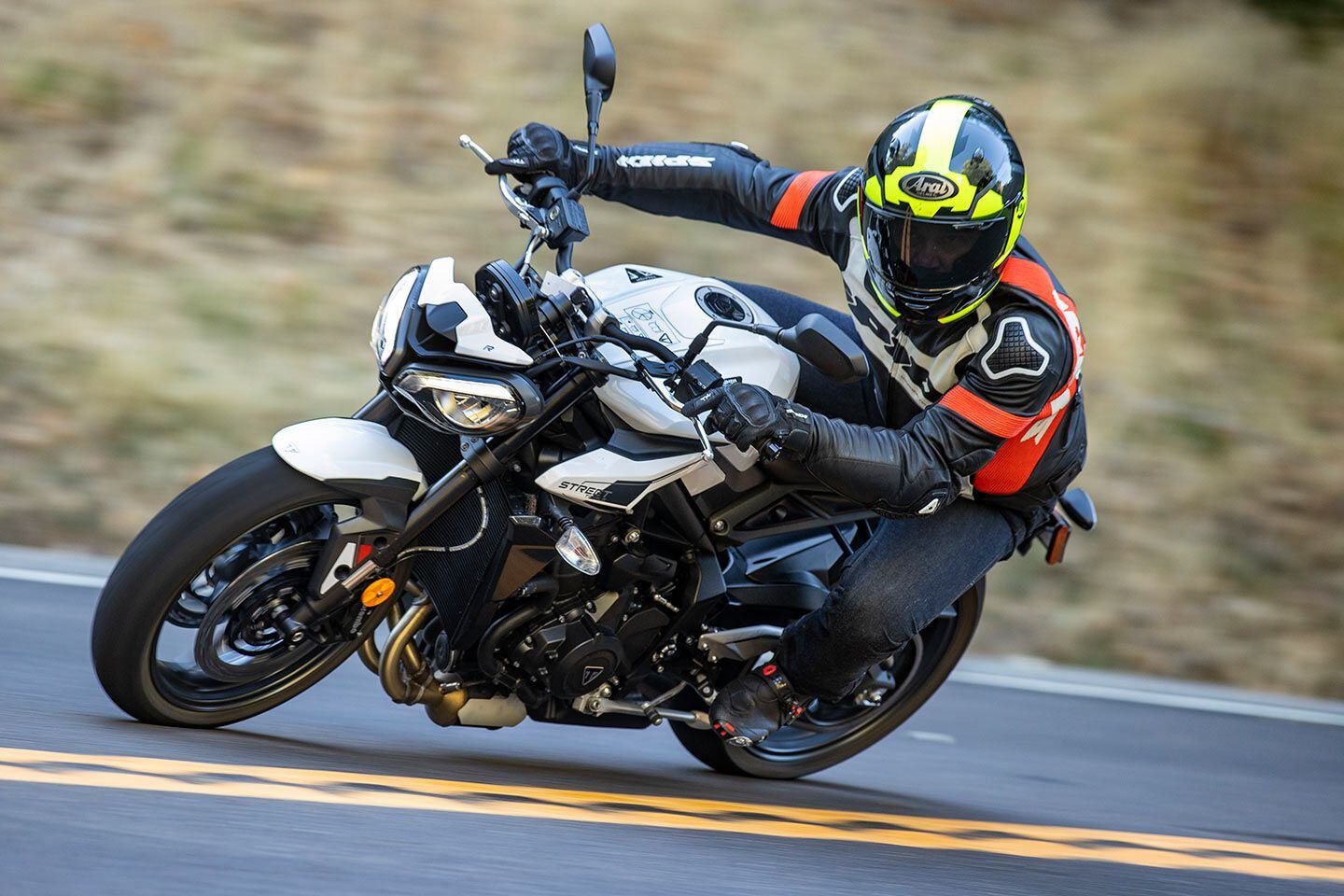
The 2024 Triumph Street Triple 765 R comes equipped with Continental ContiRoad tires. (Jeff Allen/)Its rider-aid package was also updated for the 2024 model year. A six-axis IMU provides Optimized Cornering ABS, Switchable Cornering Traction Control, wheelie control, and four ride modes. Road, Rain, and Sport have integrated TC and ABS parameters, but Rider mode is fully customizable. Four levels of traction control are available as well as “off.” Wheelie control is integrated into the traction control and cannot be disabled independently. The Street Triple 765 R’s chassis is comprised of an aluminum twin-spar frame, a fully adjustable 41mm Showa Separate Function Big Piston fork, fully adjustable Showa shock, Brembo M4.32 four-piston radial-mount Monoblock calipers, and 17-inch wheels.
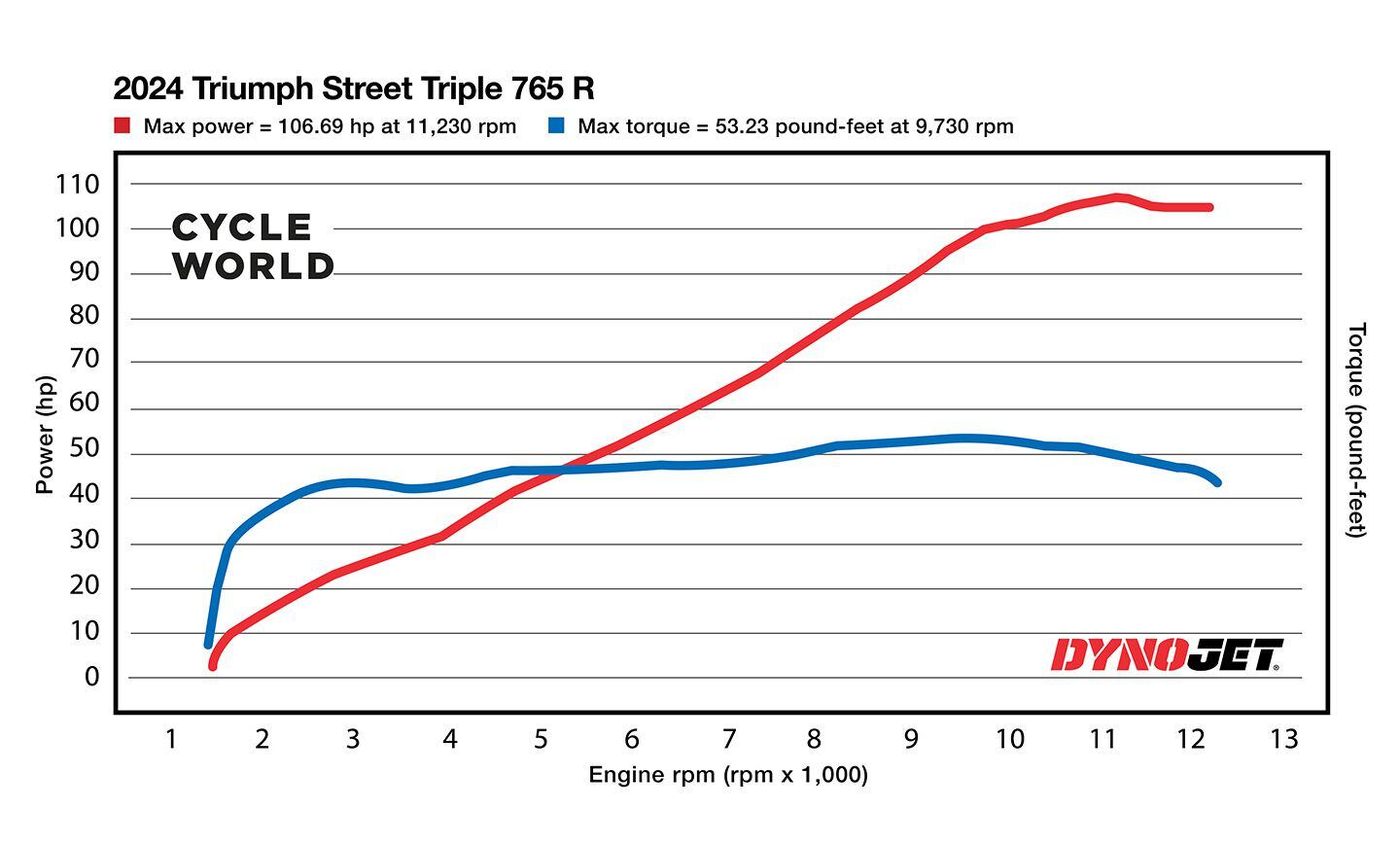
2024 Triumph Street Triple 765 R Dyno Chart. (Robert Martin/)Before hitting our in-house Dynojet 250i dynamometer, the 2024 Triumph Street Triple 765 R weighed 419 pounds on our automotive scales. On the Cycle World dyno, the roadster produced 106.7 hp at 11,230 rpm and 53.2 lb.-ft. of torque at 9,730 rpm. Looking at the picturesque power and torque curves, what more can be said? The engine’s extremely linear power delivery and flat torque curve give the Street Triple flexibility at any rpm.
-
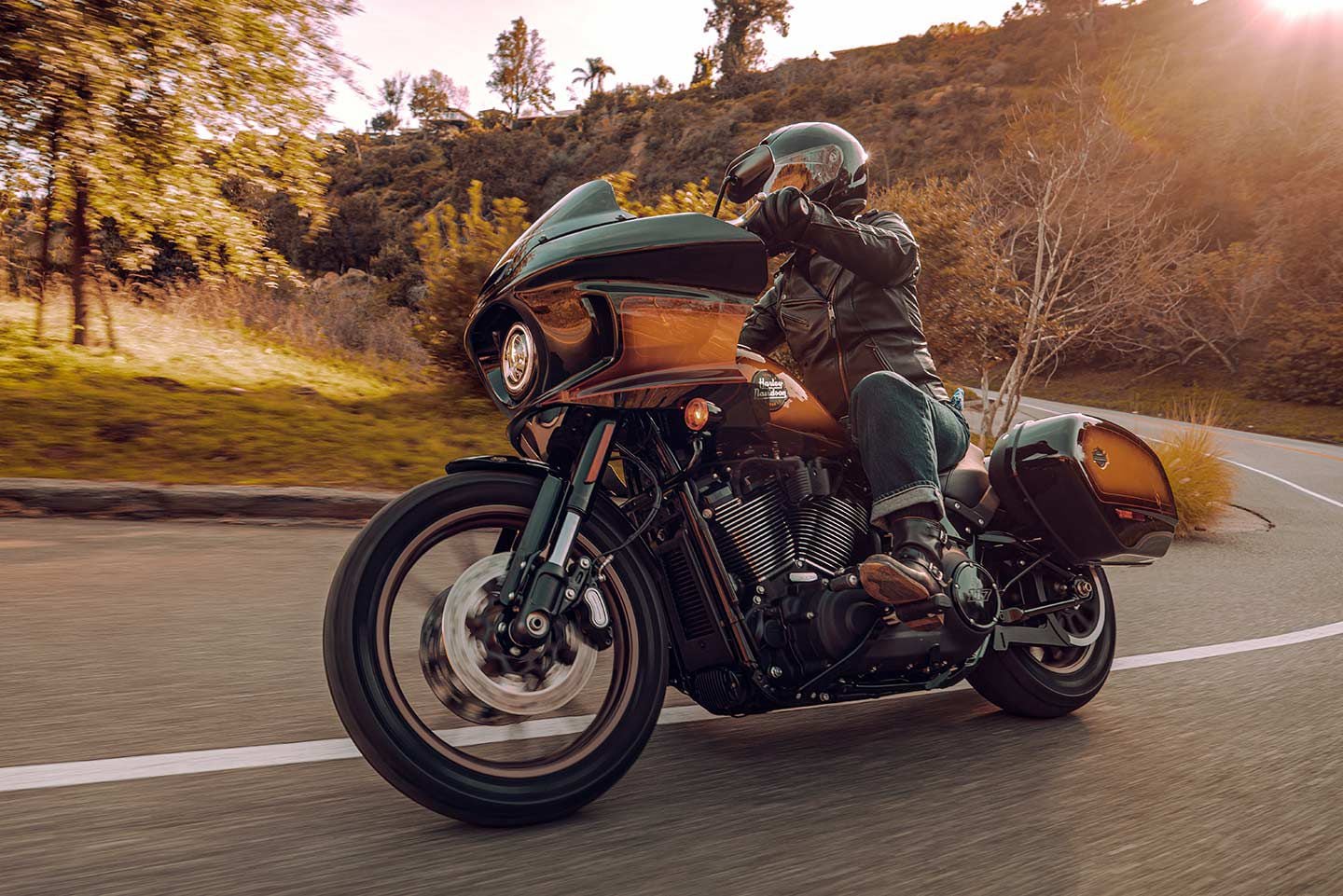
Harley-Davidson has taken the wraps off the 2024 Tobacco Fade Enthusiast Motorcycle Collection, a limited run of special-edition models, including the Low Rider ST. (Harley-Davidson/)Whether you see limited-edition bikes as a route to giving fans something exclusive or as a creative marketing exercise, there’s no question it’s a successful formula and Harley-Davidson is a master of the art. For 2024, the company adds three more limited-run machines to its portfolio in the form of the Tobacco Fade Enthusiast Motorcycle Collection—and just like their predecessors they’re sure to sell fast.
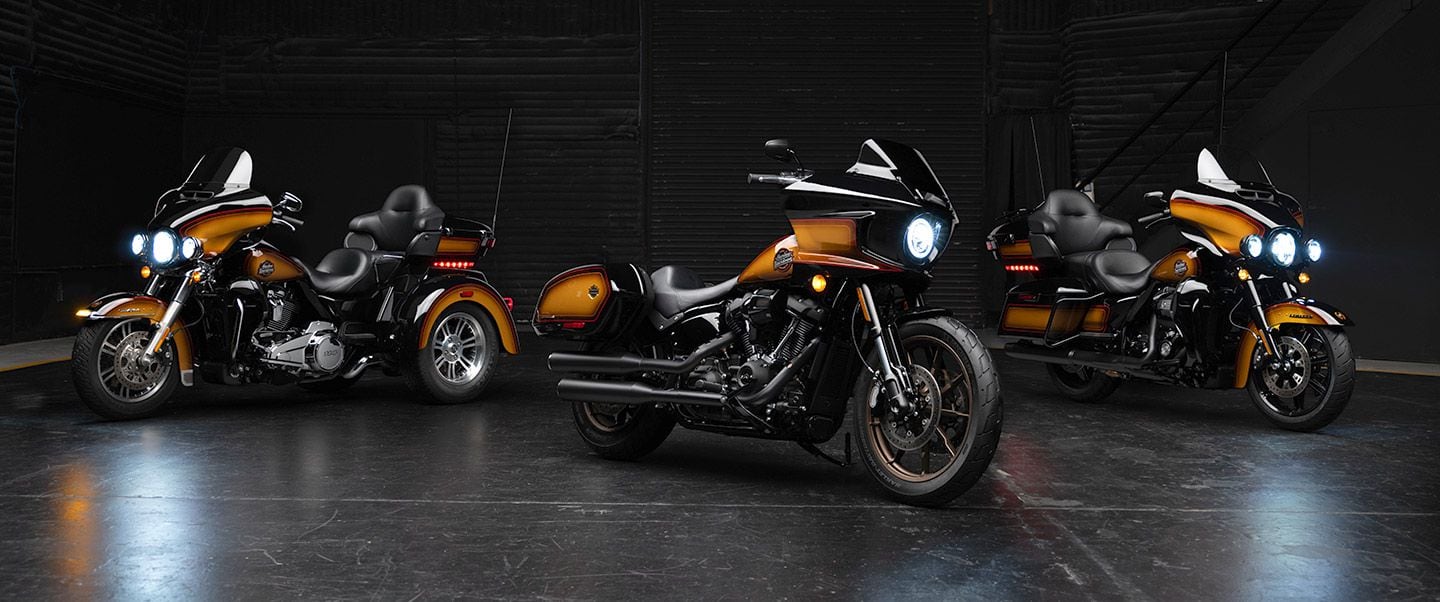
There are three models in the Tobacco Fade Enthusiast Motorcycle Collection, including the Tri Glide Ultra, Low Rider ST, and Ultra Limited. (Harley-Davidson/)If you’re a guitarist, that “tobacco fade” term is probably already familiar. Tobacco fade or “tobacco burst” is a color scheme that’s been featured on instruments like the Gibson Les Paul for decades in the form of a toned-down version of the classic “sunburst” pattern, and that’s precisely the look Harley is going for with the new limited-edition machines.
Like the 120th Anniversary limited-edition models from 2023, the new bikes use fade paintwork where the main color is blended into a darker edge, just like a sunburst finish on a guitar. On the Tobacco Fade machines, Harley has gone for a metallic gold with a sunburst fade on each panel, the fade area edged by a caramel-colored pinstripe. Each bike also gets a fuel-tank medallion designed to look like a vinyl record and a guitar pick graphic on the front fender, as well as an Enthusiast Collection logo on the rear.
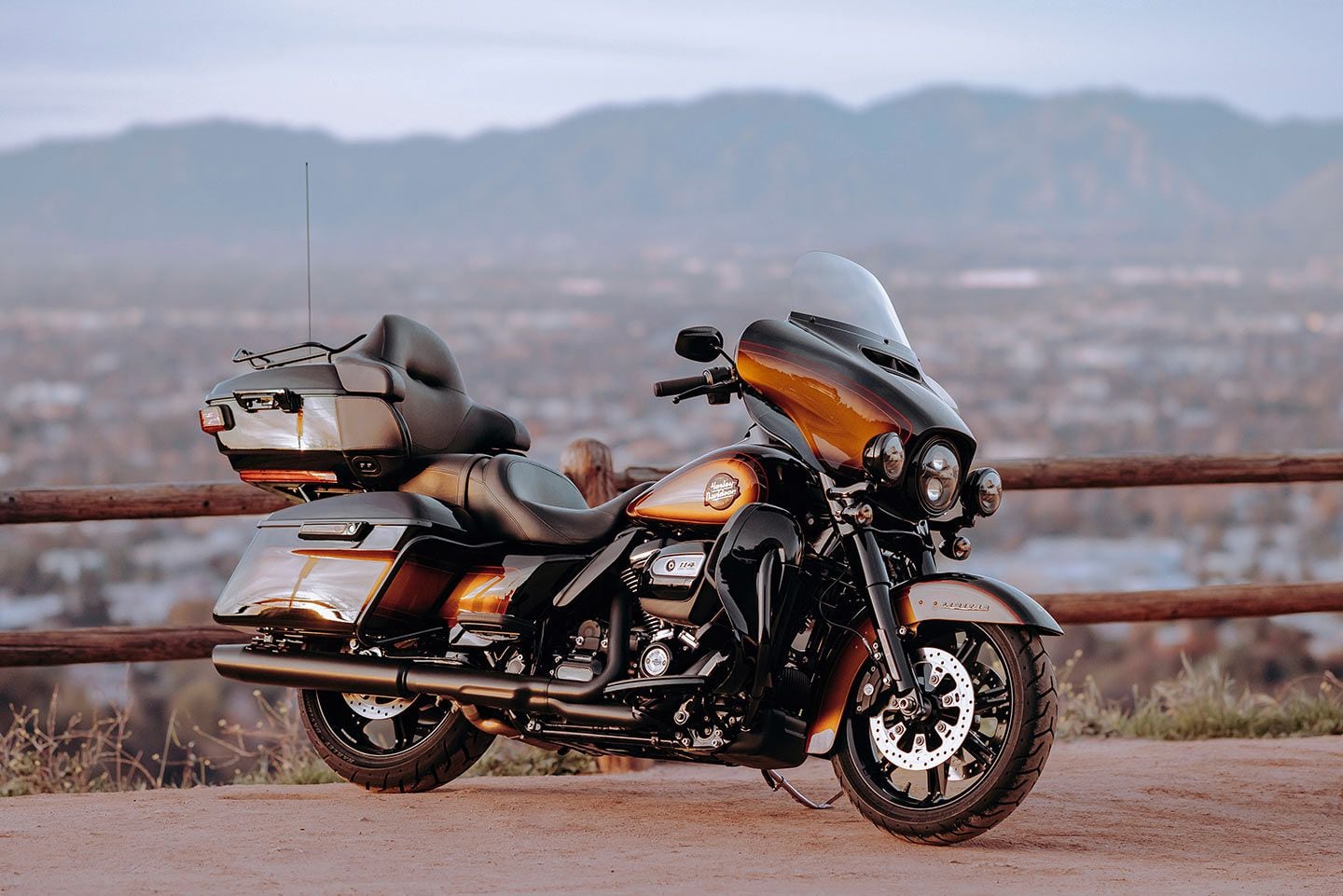
The 2024 Harley-Davidson Tobacco Fade Enthusiast Motorcycle Collection Ultra Limited. (Harley-Davidson/)The three bikes in the collection are all faired models, giving more bodywork space for the special paint. They start with the $25,899 Low Rider ST, with the same 117ci Milwaukee-Eight V-twin as the standard model. Then there’s the $35,399 Ultra Limited, complete with the usual batwing fairing, 114 Milwaukee-Eight, and full luggage, and finally Harley gives the Tobacco Fade treatment to the $41,999 Tri Glide Ultra, again with the 114ci engine. The updates on all three machines are purely cosmetic, with no changes to the mechanical components or equipment levels.
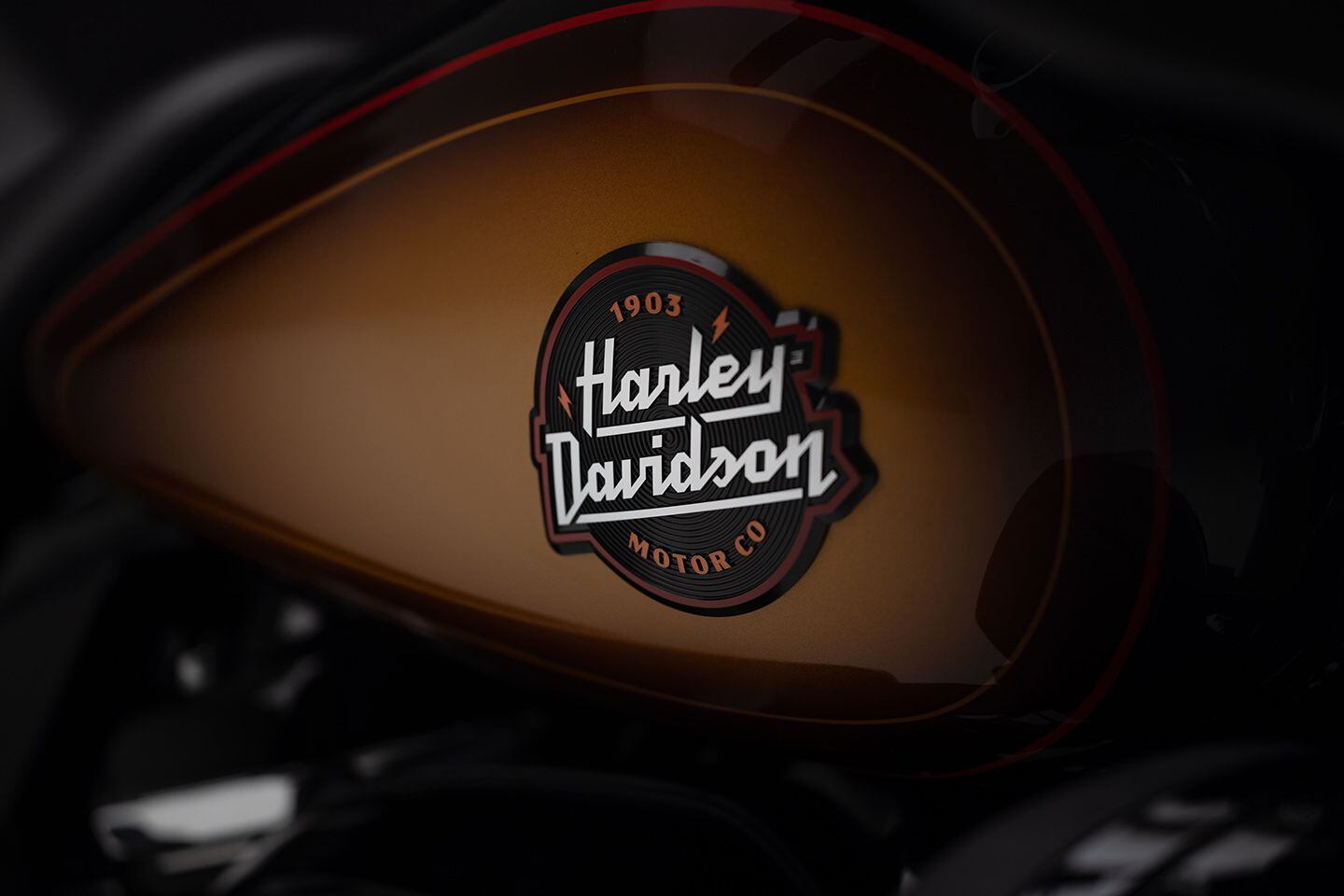
The tank emblem resembles a vinyl record. (Harley-Davidson/)Each Tobacco Fade model will be made in a limited run of 2,000 examples and continues the Enthusiast Motorcycle Collection theme that last year featured the Fast Johnnie versions of the Street Glide ST, Road Glide ST, and Low Rider ST. It’s an ongoing series, so we can expect further Enthusiast Motorcycle Collection limited editions in years to come, each with their own theme.
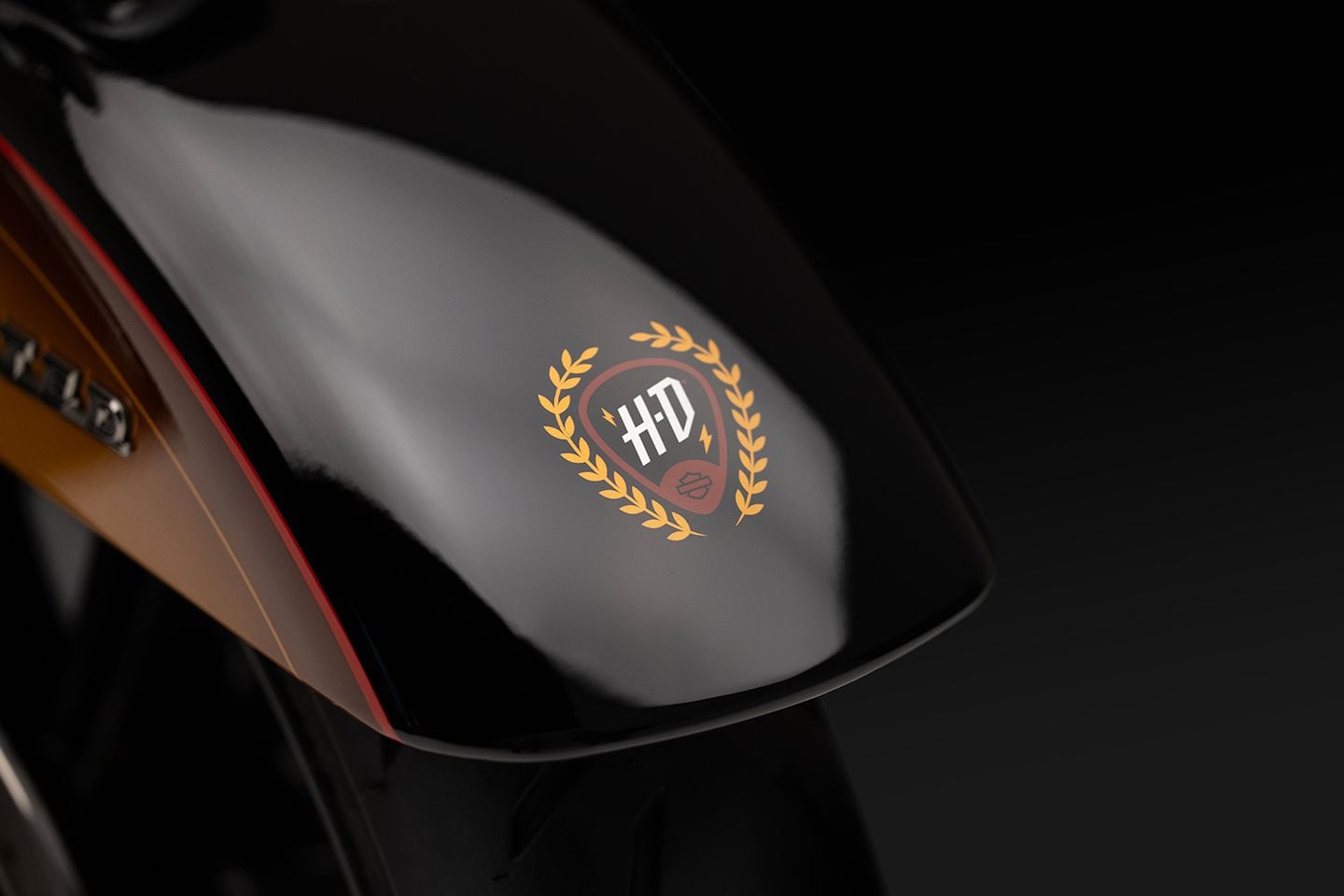
The logo on the front fenders resembles a guitar pick. (Harley-Davidson/) -
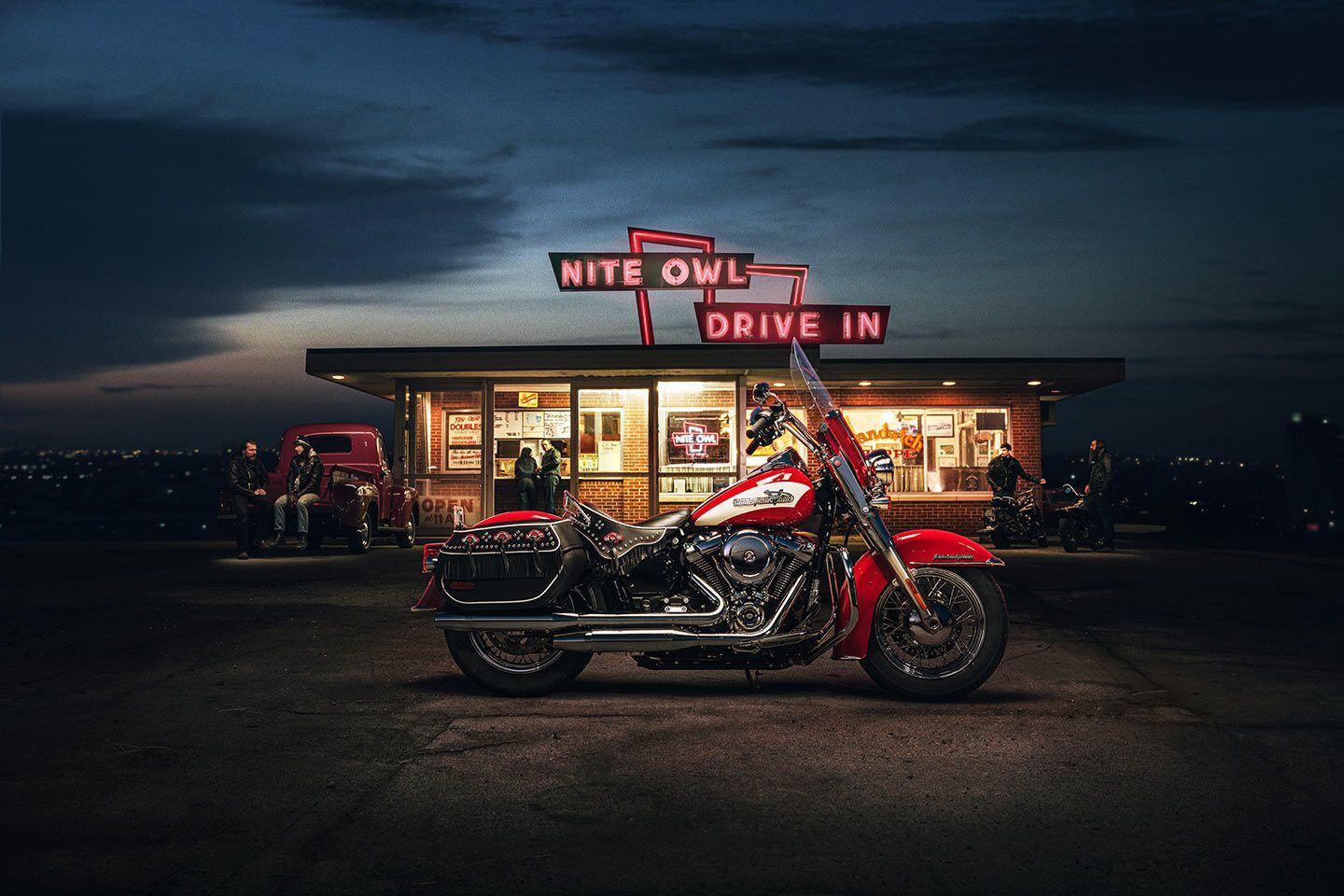
The 2024 Icons Collection is a resurrection of sorts in the Hydra-Glide Revival, inspired by the 1949 version of that motorcycle. (Harley-Davidson/)With 121 years of heritage to draw upon Harley-Davidson isn’t short of landmark models in its back catalog, but the 1949 Hydra-Glide marked a significant turning point by adopting a hydraulic telescopic fork. For 2024, its 75th anniversary is being marked with the limited-edition Hydra-Glide Revival.
The new machine is the fourth in the Icons Motorcycle Collection, a series of limited-run models that debuted in 2021 with the Electra Glide Revival, which was followed by the 2022 Low Rider El Diablo and 2023 Electra Glide Highway King. Each was made in small numbers: 1,500 examples for each of the first two offerings, 1,750 of the Highway King in 2023. The new Hydra-Glide Revival will also be restricted to a run of 1,750 for the entire world.
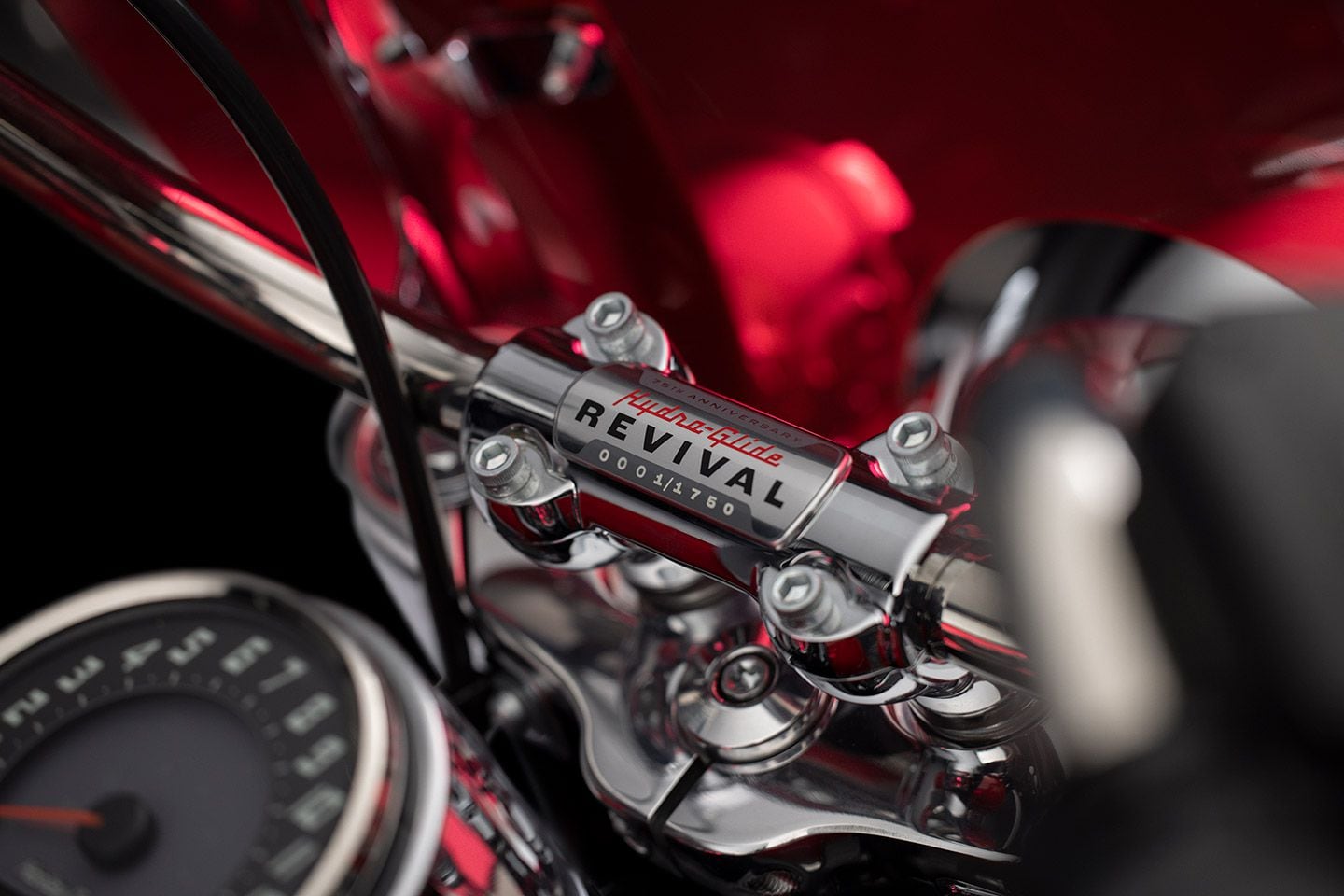
The 2024 Icons Collection Hydra-Glide Revival will be limited to a run of 1,750 machines worldwide. (Harley-Davidson/)Although the Hydra-Glide name isn’t one that’s been regularly reused, the original 1949 machine was the first to use the sort of hydraulic telescopic fork that’s ubiquitous on modern Harleys, replacing the girders of earlier machines. It also featured the then-new Panhead engine with hydraulic lifters—which had been introduced a year earlier (but still lacked any rear suspension). While not named as such, the original Fat Boy of 1990 took its proportions and styling cues from the Hydra-Glide and has remained a key model since.
The Hydra-Glide Revival is based on the current Heritage Classic but with additional retro touches to evoke the Hydra-Glide’s heyday in the 1950s. It specifically borrows from the 1956 version of the Hydra-Glide, adopting the 1956 paint scheme and the stylized “‘V” tank badges that were used in 1955 and ‘56. On board, the speedometer’s graphics are inspired by the earlier 1954–55 version and there’s an insert on the bar risers including the Hydra-Glide logo and each bike’s limited-edition serial number.
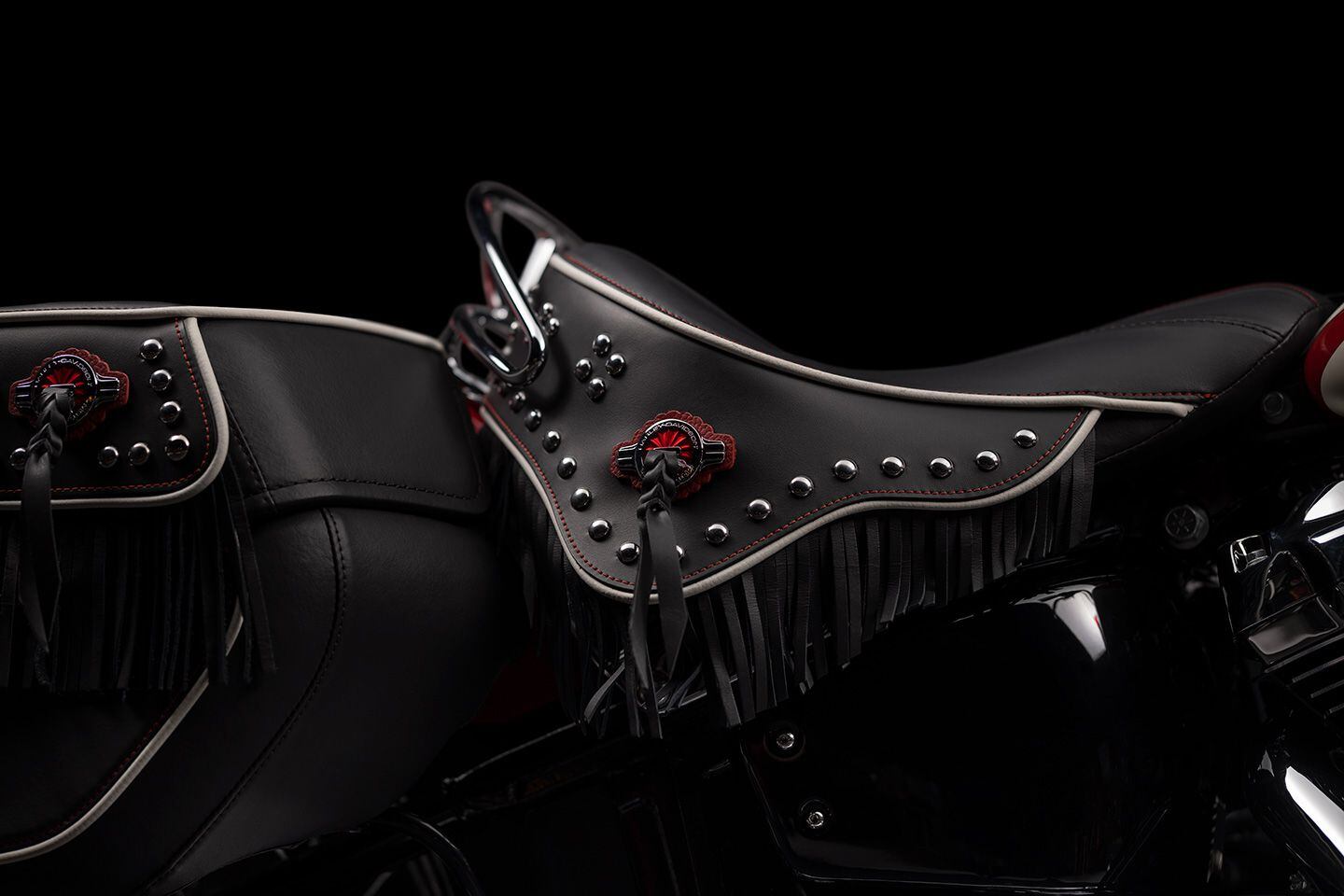
The 27-inch seat is adorned with tassels, studs, fringe, you name it. (Harley-Davidson/)Up front, the screen is taller than the standard Heritage Classic and features a color-matched lower section like the design on the 2023 Highway King. That screen is removable and sits above a set of chrome engine bars. The visual changes at the rear include a tasseled, studded, piped, and fringed solo seat and a matching treatment for the saddlebags, but behind the retro style there’s modern practicality as those bags are lockable, water-resistant, and rigid-lined. The leather continues onto the tank with a studded strap.
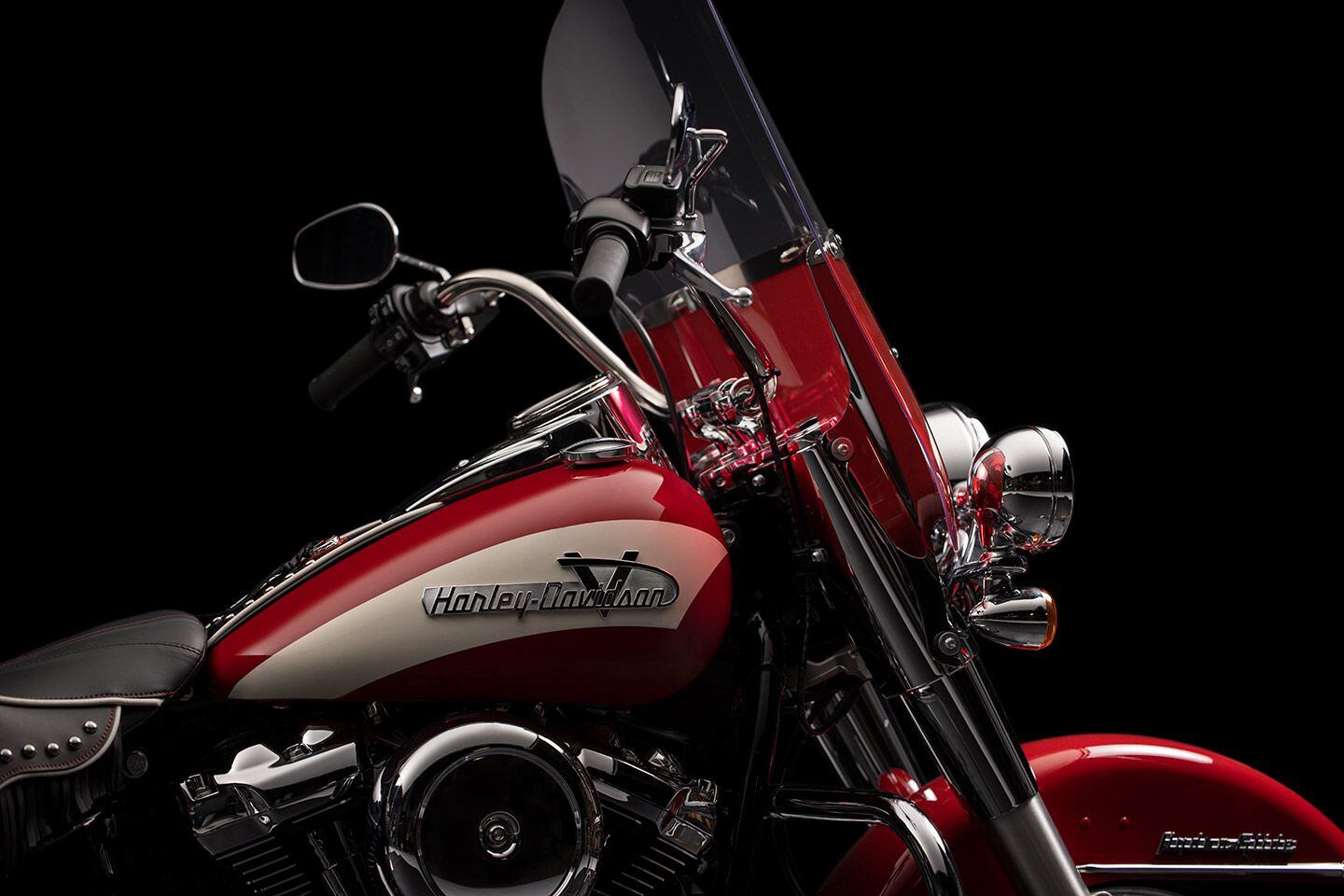
Classic touches continue with the removable windscreen and “V”style tank badges. (Harley-Davidson/)The 114ci Milwaukee-Eight V-twin is given a circular air cleaner cover to replicate a more traditional look but peak power and torque figures are unchanged from the standard Heritage Classic, with a claimed 94 hp at 4,750 rpm and 119 lb.-ft. at 3,000 rpm. Those numbers can be increased with Screamin’ Eagle upgrades if you want or need more.
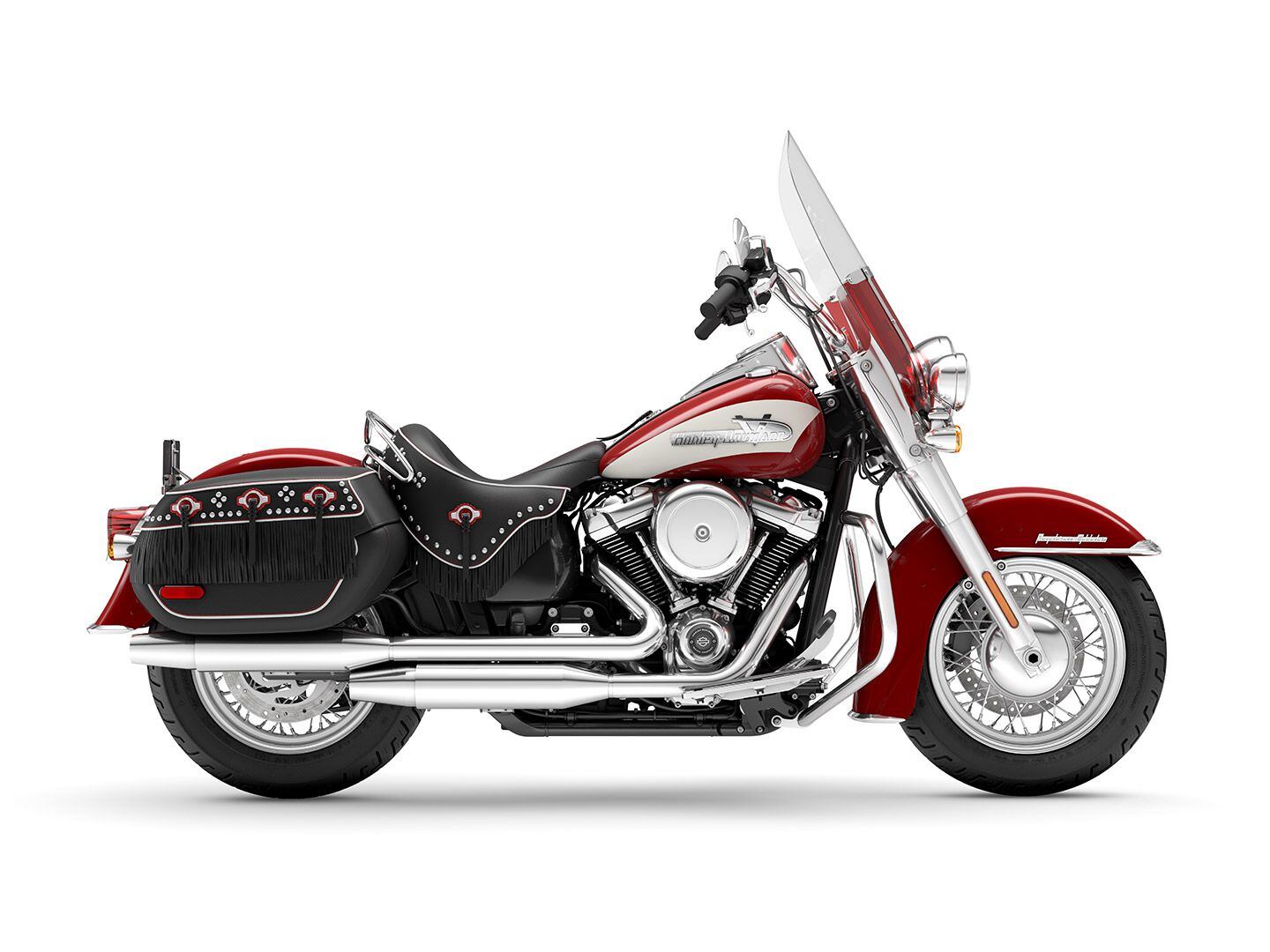
The Hydra-Glide Revival uses the Milwaukee-Eight 114. (Harley-Davidson/)The chassis and suspension are also conventional Softail fare, with an adjustable monoshock hidden at the rear, while the laced wheels and brakes are straight from the Heritage Classic. Unsurprisingly, most of the bike’s dimensions are the same as the Heritage Classic it’s based on, with no difference in length or wheelbase. The Hydra-Glide Revival’s laden (with rider) solo seat is a fraction lower than the Heritage’s (26.1 inches versus 26.3) and the new screen makes it around 3.5 inches taller than the machine it’s based on. Weight rises due to the Hydra-Glide’s extras, coming in at 742 pounds ready-to-ride, up from 730 pounds for the Heritage Classic.
Given the success of the previous Icons Collection models, Harley isn’t likely to have any trouble finding buyers for all 1,750 examples of the 2024 Hydra-Glide Revival.
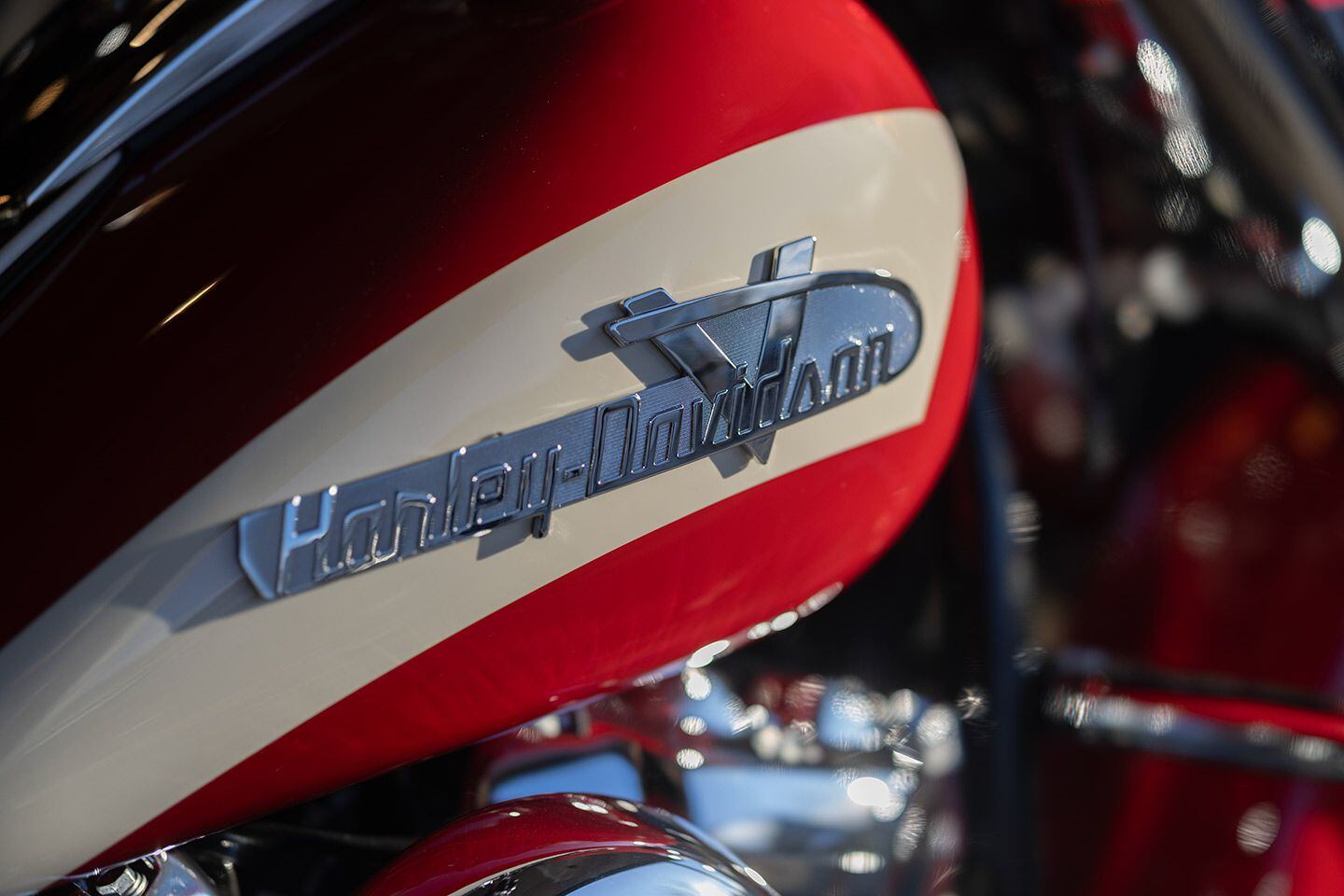
The 2024 Hydra-Glide Revival’s V badge tank. (Harley-Davidson/)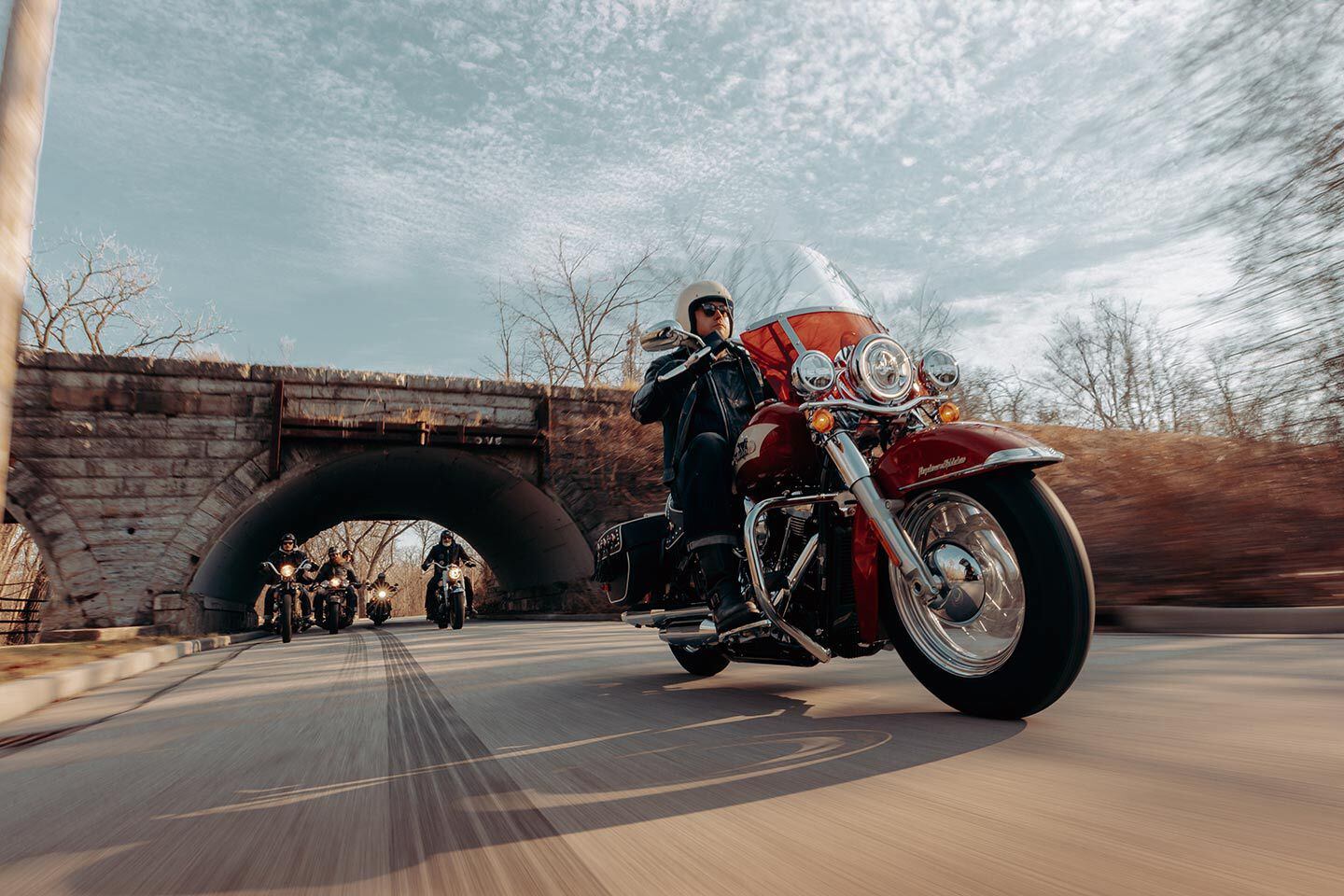
Based on the Heritage Classic, the Hydra-Glide Revival shares a very similar chassis. (Harley-Davidson/)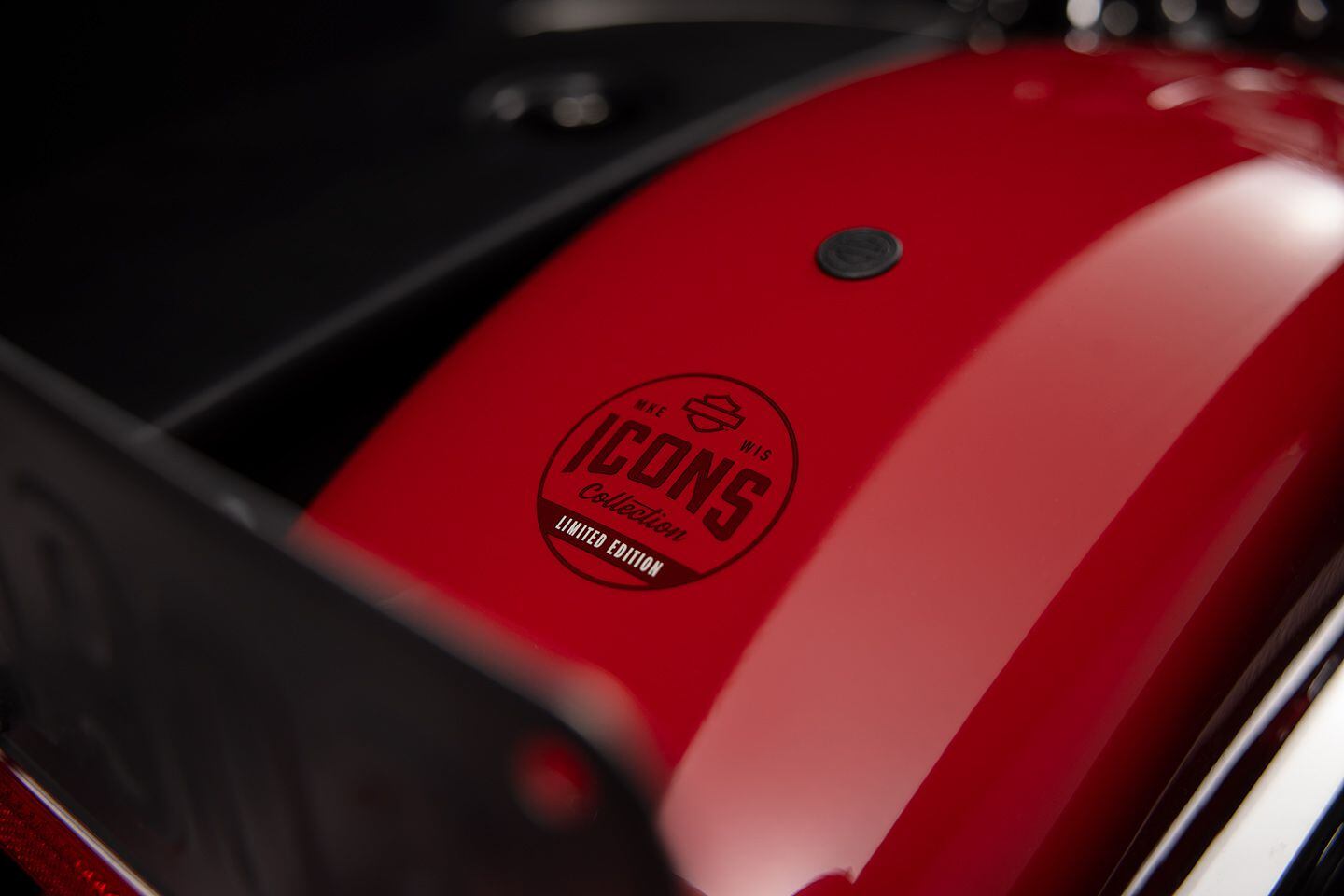
The Hydra-Glide Revival’s rear fender. (Harley-Davidson/)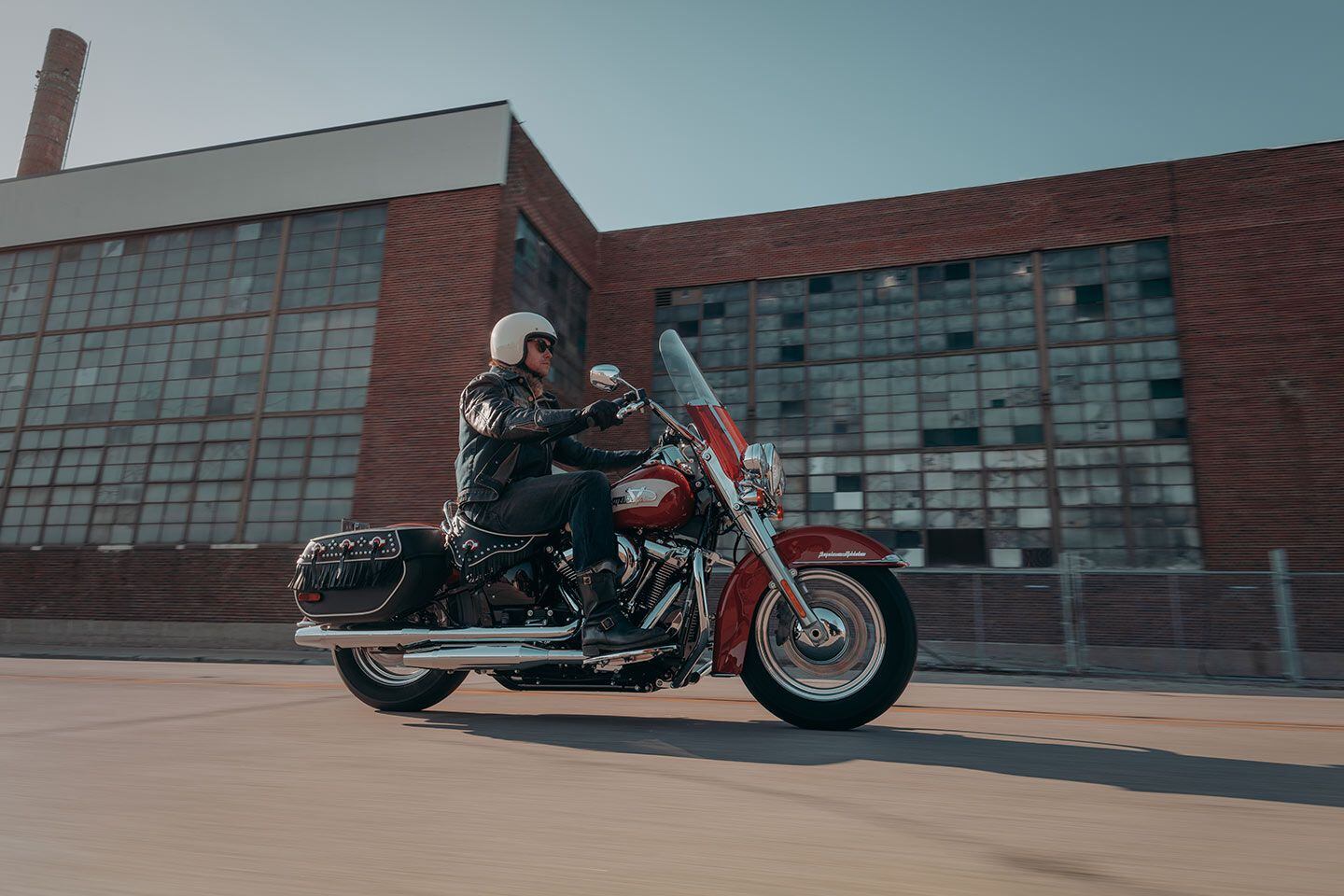
Hydra-Glide Revival side view. (Harley-Davidson/)2024 Harley-Davidson Hydra-Glide Revival Specs
MSRP: $24,999 Engine: 45-degree V-twin; 4 valves/cyl. Displacement: 1,868cc Bore x Stroke: 102.0 x 114.3mm Compression Ratio: 10.5:1 Transmission/Final Drive: 6-speed/belt Claimed Horsepower: 94.0 hp @ 4,750 rpm Claimed Torque: 119 lb.-ft. @ 3,00 rpm Fuel System: Electronic Sequential Port Fuel Injection Clutch: Wet, multiplate assist Frame: Tubular steel Front Suspension: 49mm telescopic, dual-bending valve; 5.1 in. travel Rear Suspension: Monoshock, spring preload adjustable; 3.4 in. travel Front Brake: 4-piston fixed calipers, floating 300mm discs w/ ABS Rear Brake: 2-piston floating caliper, 292mm disc w/ ABS Wheels, Front/Rear: Spoked steel; 16 x 3.0 in. / 16 x 3.0 in. Tires, Front/Rear: 130/90-16 / 150/80-16 Rake/Trail: 30.0°/5.7 in. Wheelbase: 64.2 in. Ground Clearance: 4.7 in. Seat Height: 27.0 in. (unladen) Fuel Capacity: 5.0 gal. Claimed Wet Weight: 742 lb. Contact: harley-davidson.com -
It’s pretty much a Dakar bike for the street, and we want one.
-
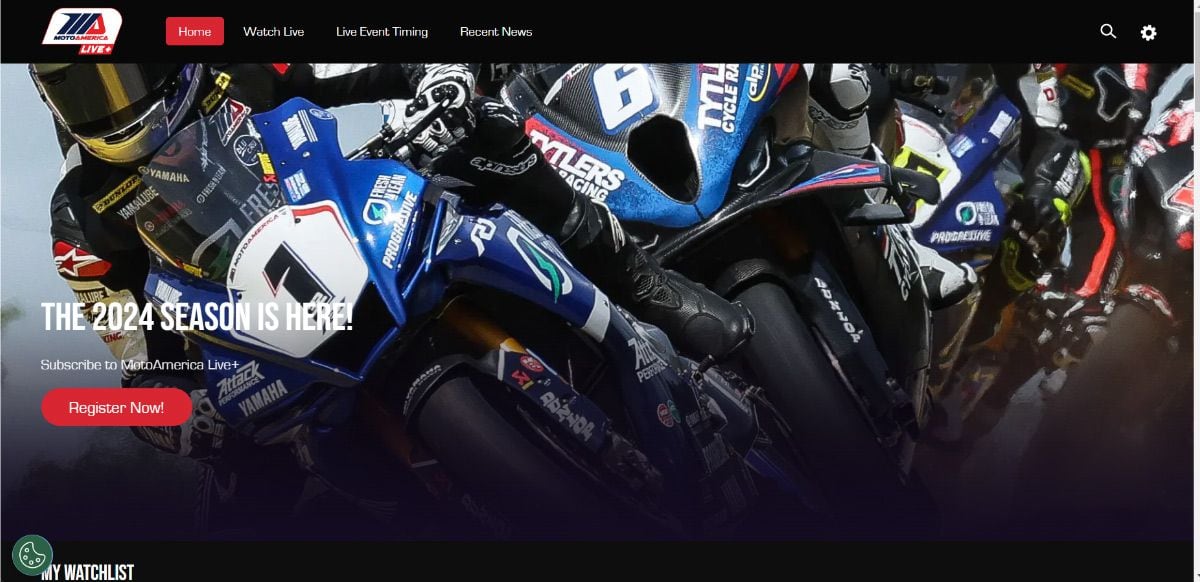
MotoAmerica Live+, MotoAmerica's live streaming and on-demand service, has undergone major upgrades for 2024 and beyond. (MotoAmerica/)MotoAmerica Press Release:
MotoAmerica, North America’s premier motorcycle road racing series, is thrilled to announce that its live streaming and on-demand service, MotoAmerica Live+, has undergone major upgrades for 2024 and beyond with vastly improved features and functionality that will bring fans closer than ever to all the action of the MotoAmerica season.
Previous subscribers to MotoAmerica Live+ will instantly notice the all-new look and feel with a streamlined user interface that provides faster and better access to all the MotoAmerica action both on and off the track.
Select new features include a DVR functionality that allows users to rewind and pause both live events and video on demand; enhanced search functionality so consumers can easily find more of what they want to watch; additional personalization for subscribers, including a “Continue Watching” function that means viewers never lose their spot in a video, and there’s also a new “My Watchlist” that allows users to save videos for later playback.
The mobile experience on MotoAmerica Live+ is also greatly improved with newly rebuilt apps for mobile and Connected TV that are more intuitive and offer more functionality for the end user.
As for the content itself, there’s going to be more than ever in 2024 – from live racing, highlights and compilations to exclusive behind-the-scenes footage, interviews, and original features.
Subscriber support is also improved with a fully loaded support hub, including end user self-serve options, an AI-powered chatbot for faster responses, and a dedicated human support team to tackle any consumer concerns to always ensure the best possible Live+ experience.
“We’ve come a long way since the inception of MotoAmerica Live+ in 2019,” said MotoAmerica COO Chuck Aksland. “Over the years, we’ve listened to our customers, incorporating their feedback and insights to help us enhance their viewing experience. The upgraded MotoAmerica Live+ platform gives us the flexibility to continue to evolve over time, bringing together live timing, betting, news, merchandise, and access to the 24-hour all-motorsports channel MTRSPT1. This is a testament to our commitment to evolve and adapt, ensuring that our fans have the best viewing experience for MotoAmerica racing. We’re genuinely excited about the improvements and are confident that our customers will appreciate the enhanced features and functionality.”
-
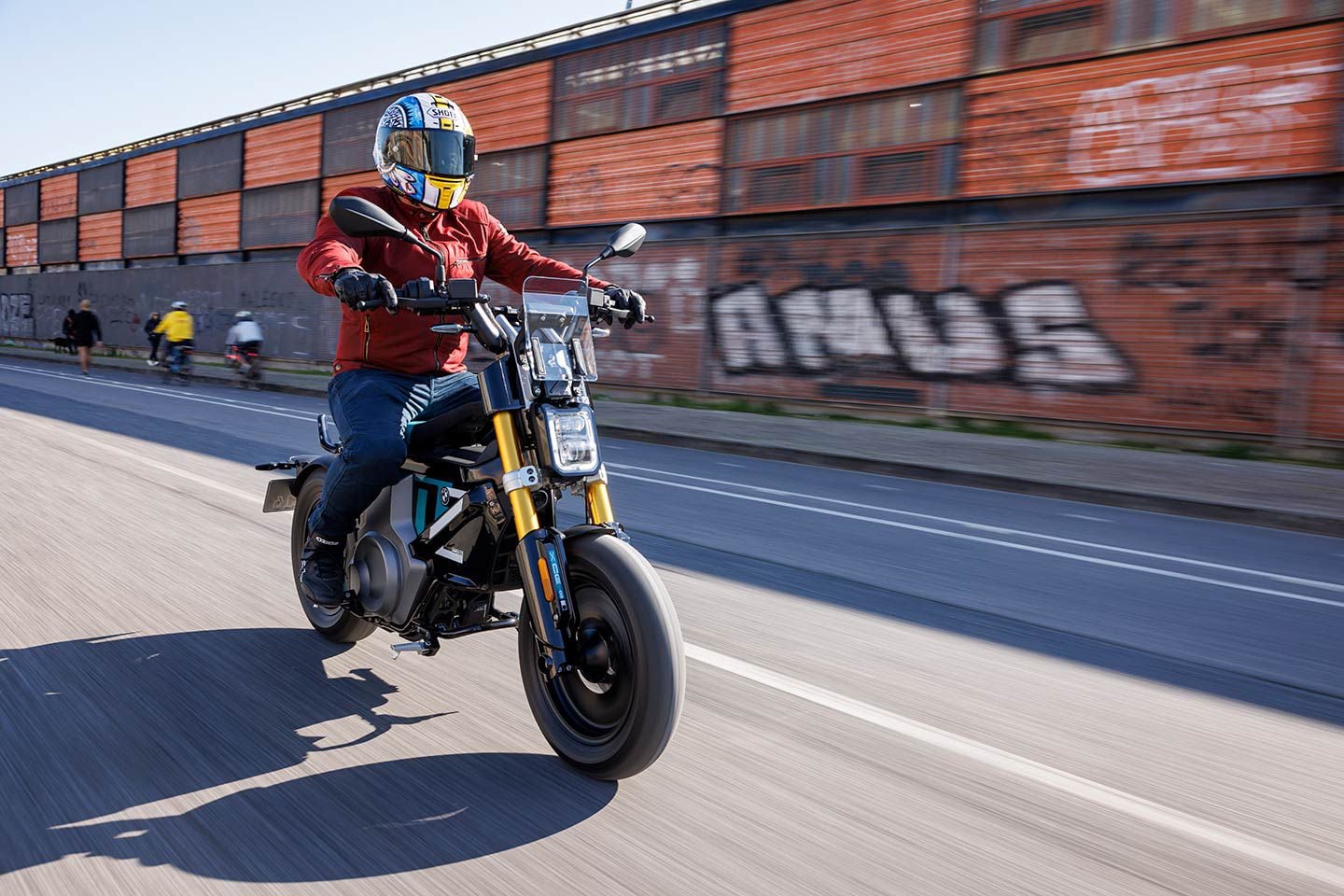
BMW’s CE 02 looks and feels perfectly at home in the urban jungle. (BMW/)If there’s one environment in which electric motorcycles or scooters make compelling sense, it’s in the city. For short commutes and zipping through the urban jungle, it’s hard to see why you’d want much more. Except…
Except the streets of London or Los Angeles and every congested conurbation in between aren’t exactly swarming with e-scoots. Not yet. One good reason why: To the younger generation, as well as those of us who like a little engineering quality in our lives, the typical electric offering lacks some appeal. The X factor is invariably missing.
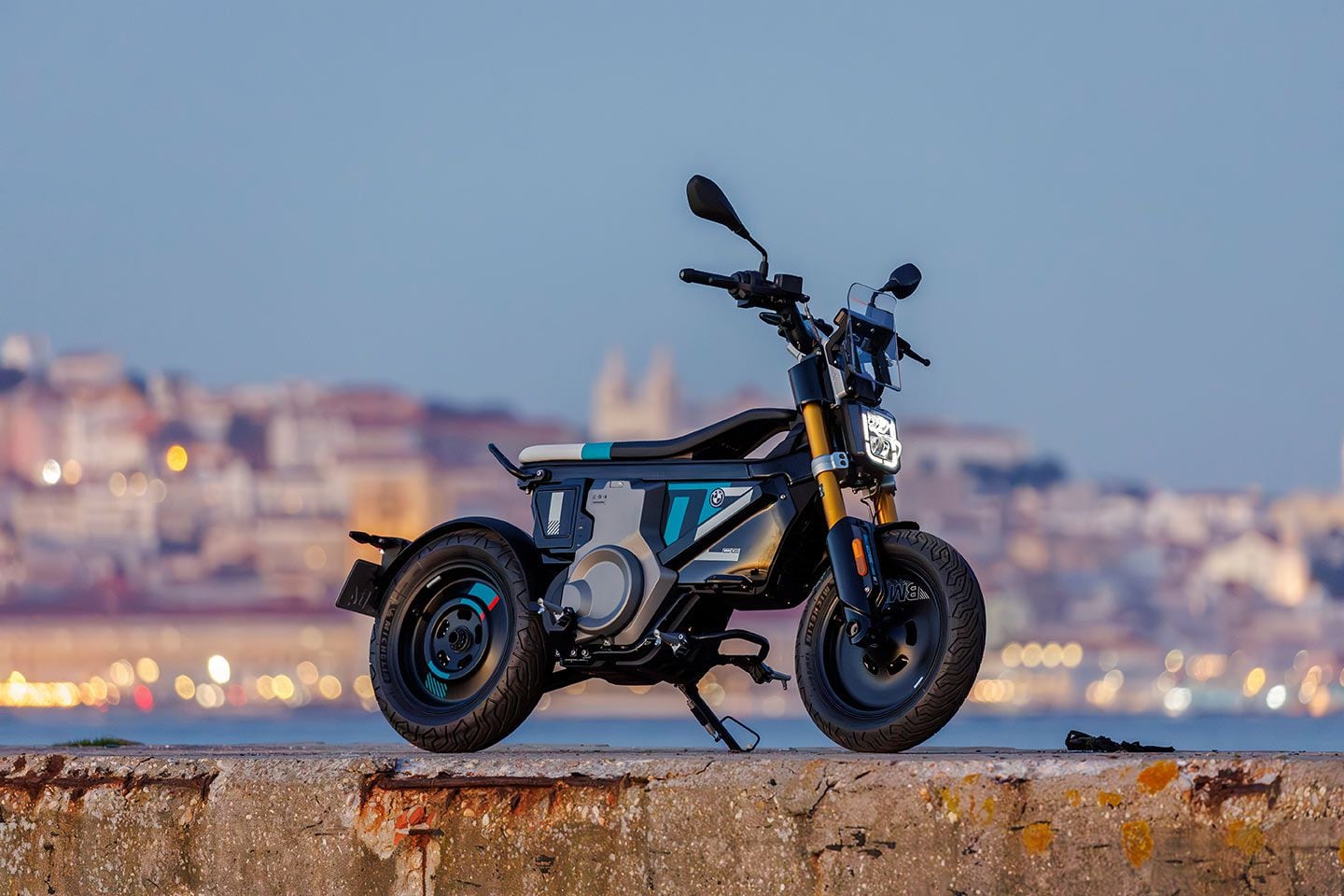
BMW’s CE 02 is clearly styled to go after a younger demographic. (BMW/)Enter the BMW CE 02, an 11kW (15 hp) e-scooter that looks more like a design project dreamed up by a skateboarding intern than a production motorcycle, but in terms of youth appeal and, yes, that X factor, it is taking no prisoners.
BMW describes it as an eParkourer and, while the CE 02′s styling influences are clear, this German electric is much more than a design exercise. It features a reverse gear, two selectable riding modes as standard, traction control, and ABS. There’s also Recuperative Stability Control (RSC), which acts like a slipper clutch, and a keyless ride.
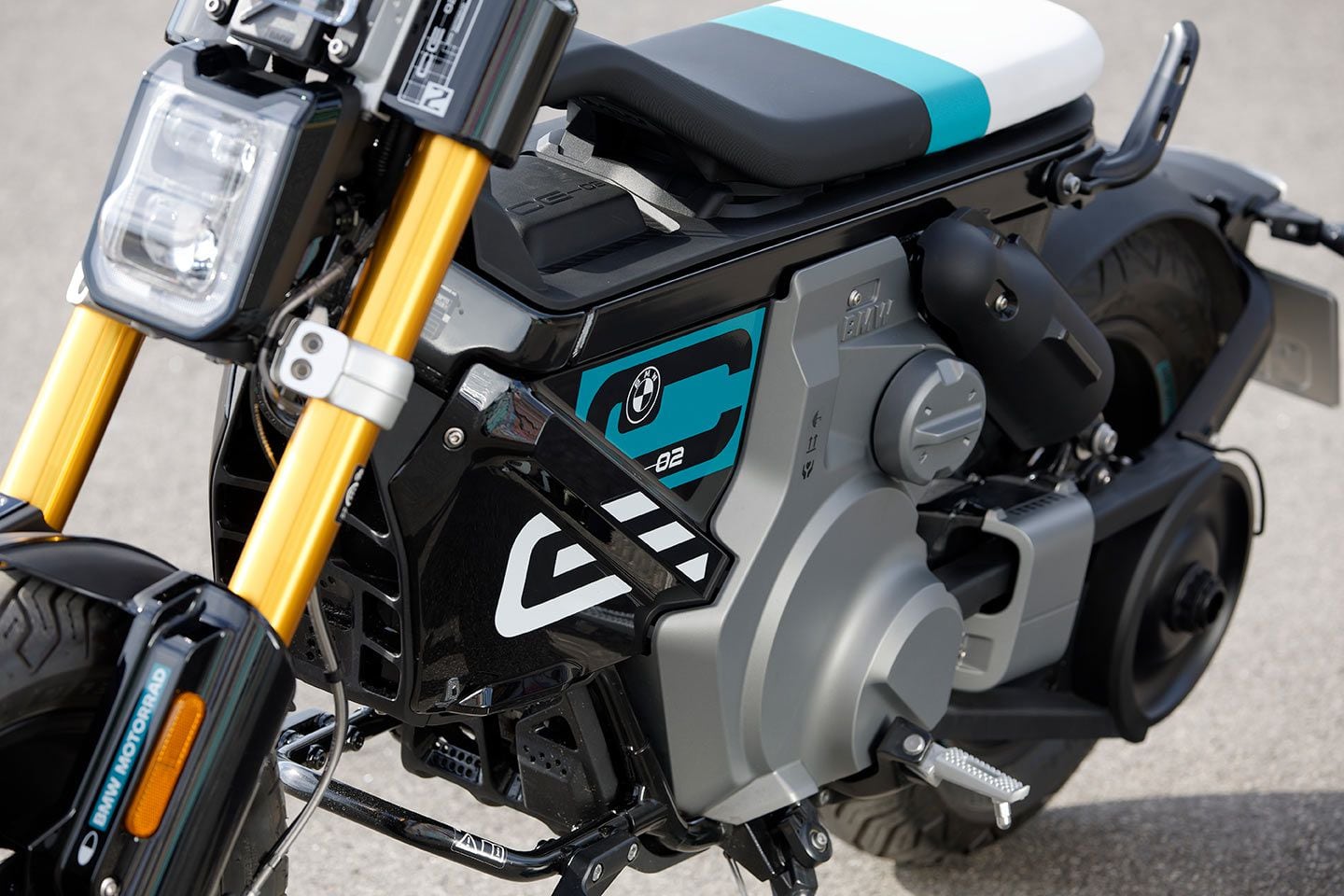
Small and compact, the CE 02 is described by BMW as eParkourer. (BMW/)It will come to the market this spring and will be priced at $7,599. Opt for the Highline package, which adds a gold fork and graphics and a raft of goodies including an extra riding mode, heated grips, a smartphone holder, and a quick charger that reduces the charging time from 5.2 hours to 3.5 hours. However, that price leaps to $8,475. That’s not an insignificant amount of money, especially for the youth of today.
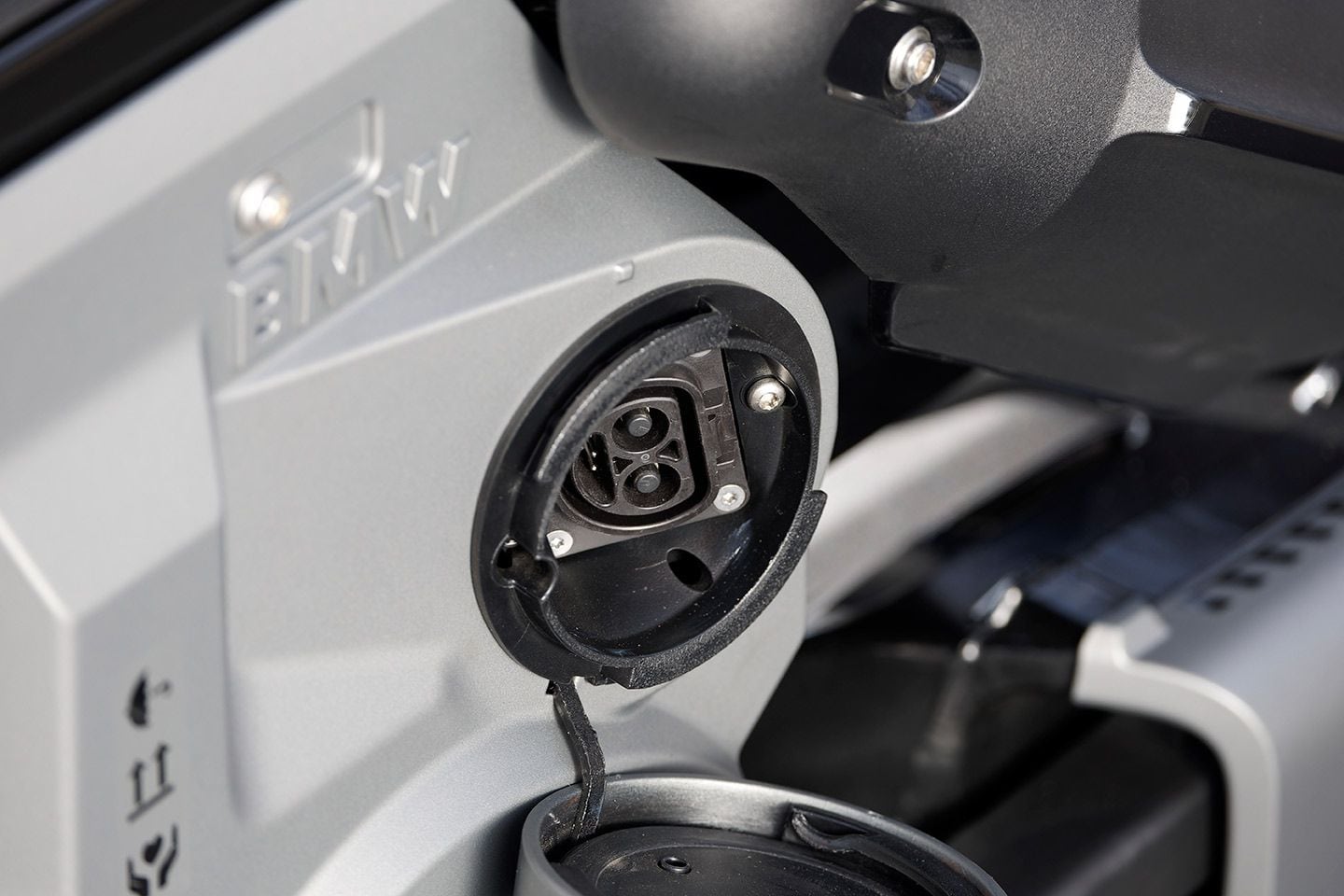
The Highline package features a quick charger that reduces charge time from 5.2 to 3.5 hours. (BMW/)Battery, Motor, Modes
The 15 hp CE 02′s motor has a continuous power rating of 6kW/8 hp and makes a handsome 40.5 lb.-ft. of torque right from the initial opening of the throttle. The bike has two batteries, each 48 volts and rated at 1.96kWh, and a claimed top speed of 59 mph, and 0-to-30 mph acceleration of three seconds. Under World Motorcycle Test Cycle (WMTC), battery range is a claimed 56 miles.
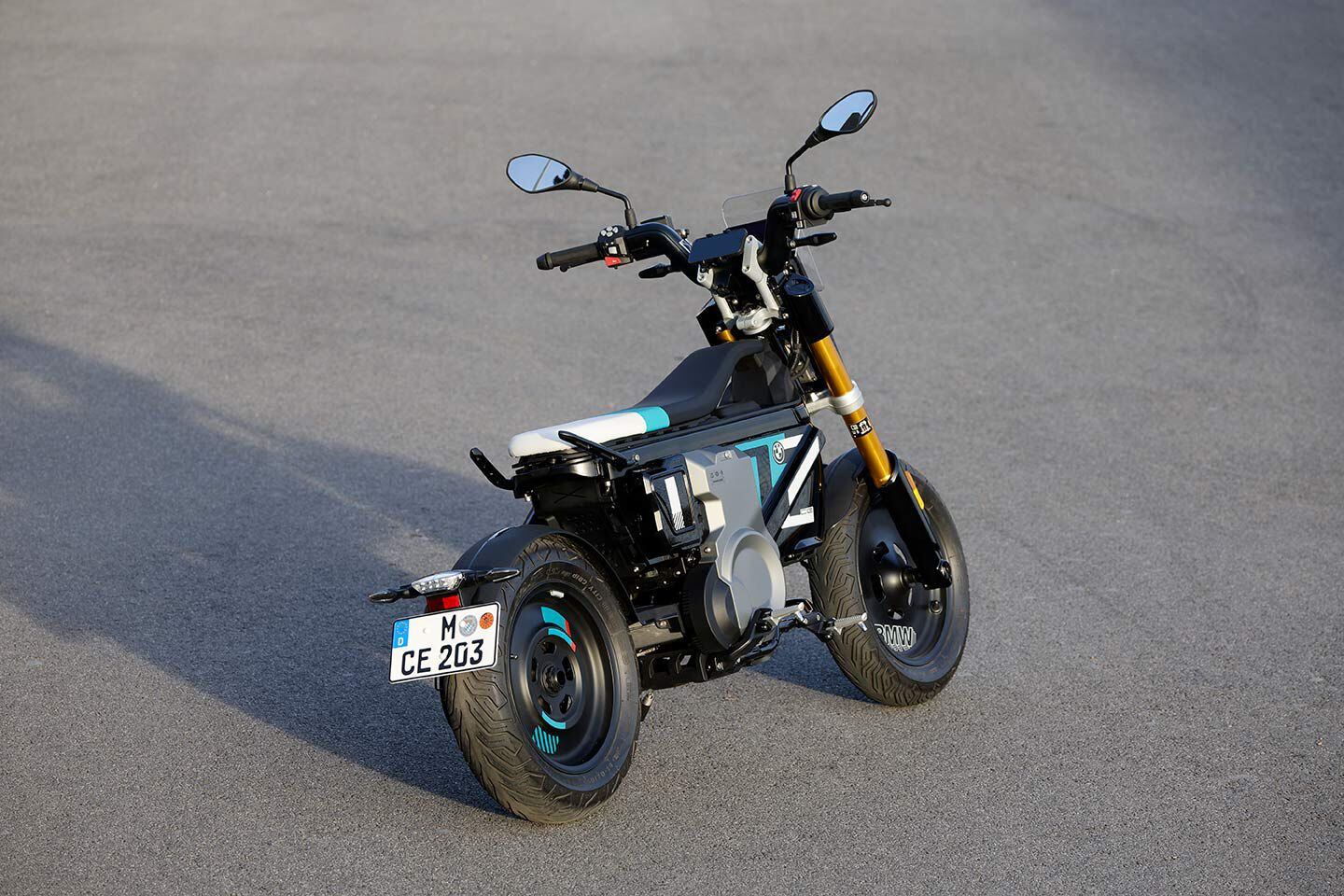
Hidden behind the bodywork is a air-cooled, synchronous-current motor with a continuous power rating of 6kW/8 hp. (BMW/)There are two riding modes, Flow and Surf. Flow is an urban setting with a soft throttle response and medium energy recuperation, and Surf is a sharper mode with no energy recuperation to allow coasting on a closed throttle. A sporty Flash mode is available only with the Highline package.
2024 BMW CE 02 Riding Impression
BMW set Cycle World loose on the CE 02 eParkour on the streets of Lisbon, Portugal, where the first task was to get the thing started. With the keyless fob in your pocket, you press the unlock button on the right handlebar, then press the red starter button while holding either brake lever (both on the bars)—and the micro-dash highlights “ready.” Then, finally, you twist the throttle and go. (Or press down and hold the reverse button on the left bar, twist the throttle, and go backward.)
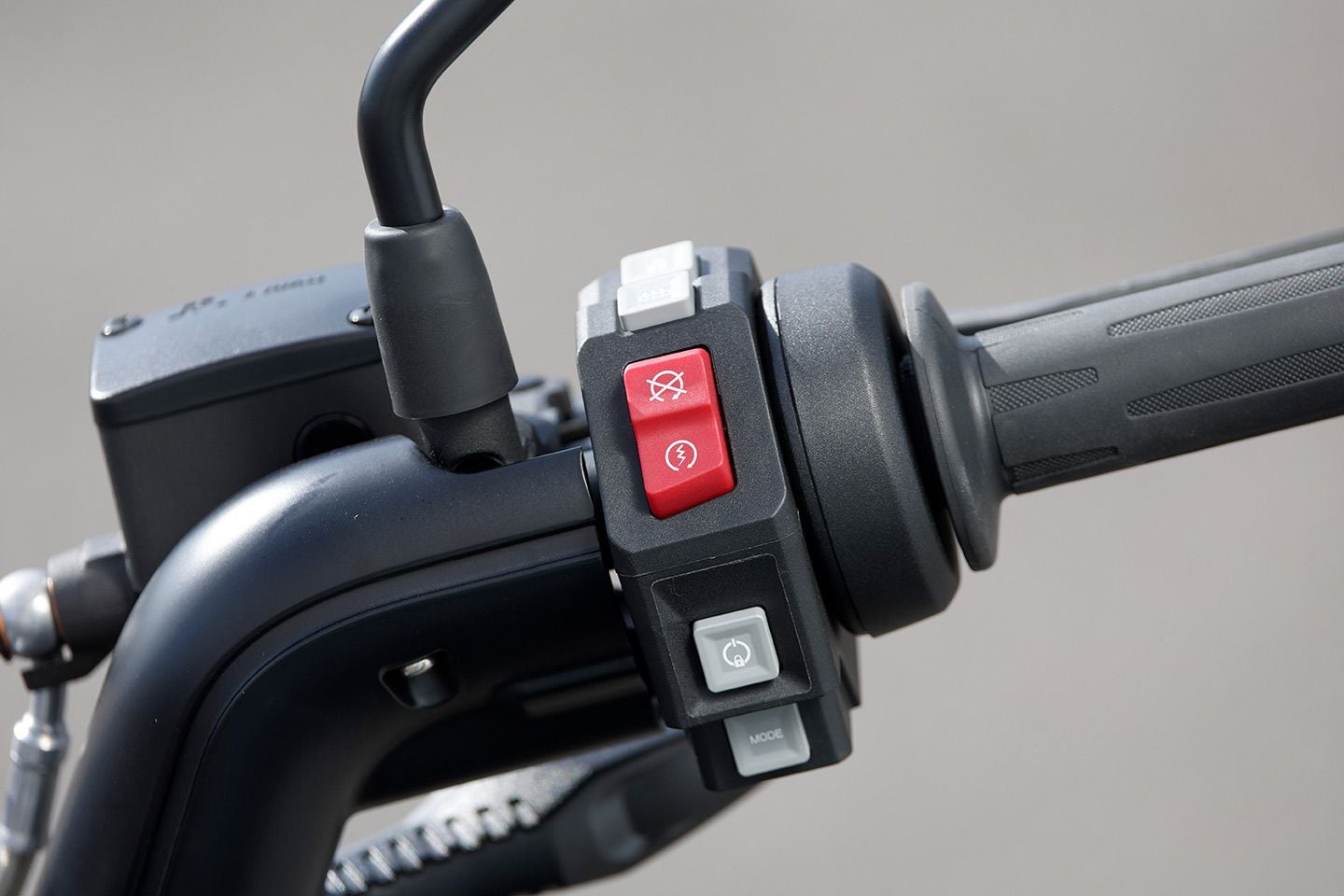
BMW CE 02 right switch gear. (BMW/)As you roll away in near silence, the torque of the air-cooled, synchronous-current motor gives the BMW serious energy compared to equivalent internal combustion engine scooters. It’s a tiny machine but makes an immediate statement that it won’t be pushed around, and while electric bikes can feel a bit jagged and digital on the initial pickup, the CE 02′s response is smooth and easy, especially in Flow mode.
Once used to Flow mode, you can start to use its recuperative function to slow the bike down, much like a soft rear brake, and there is enough instant drive to jump easily ahead of the hordes at the stoplights. However, Surf mode is preferable, which is more responsive and, like a two-stroke, has minimal engine-braking on a closed throttle. You quickly adapt by closing the throttle earlier for turns and rolling smoothly and satisfyingly to a stop—which also increases the displayed battery range.
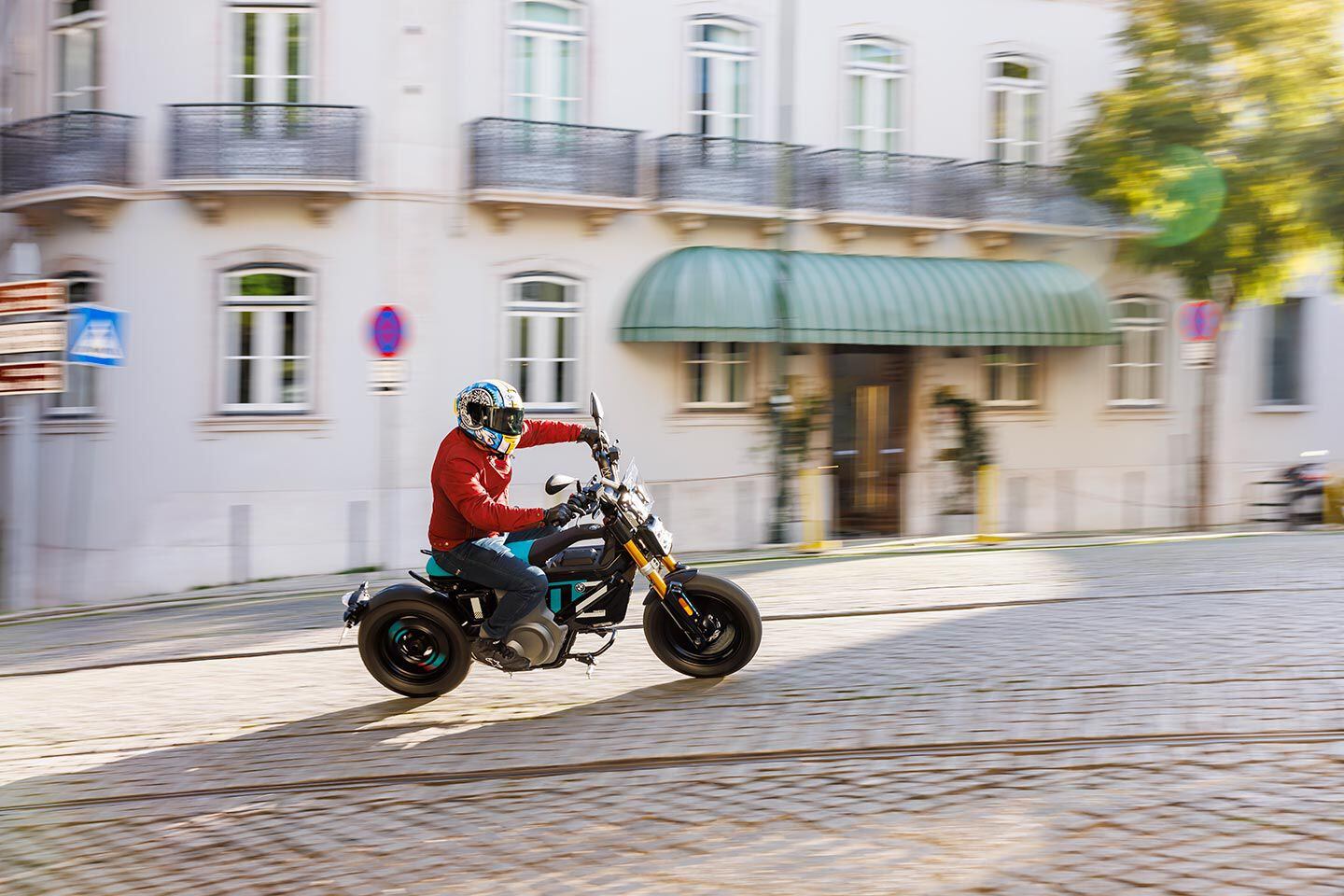
Around town, the CE 02 is fun to ride, with good performance, nice ride quality, and sharp, responsive handling. (BMW/)It’s fun to hustle. Hold the throttle to the stop long enough and you will see an indicated 62 mph. And with instant torque and no clutch or gears to worry about, the 100-yard drag race from the lights is where the CE 02 truly turns heads. It’s a good feeling to sit waiting at the lights—silent, confident, a little bit self-conscious too—knowing you’re going to leave the rush hour behind as soon as the light turns green.
Traction control, in the form of Automatic Stability Control, comes as standard and, with such a large serving of torque on tap, it’s useful when the surface is polished or wet. So too is that reverse drive. Weighing in at 291 pounds and with a low seat (29.5 inches), it’s easy to move around, but smaller lighter riders will welcome the assistance, especially when trying to pedal backward on a slight incline.
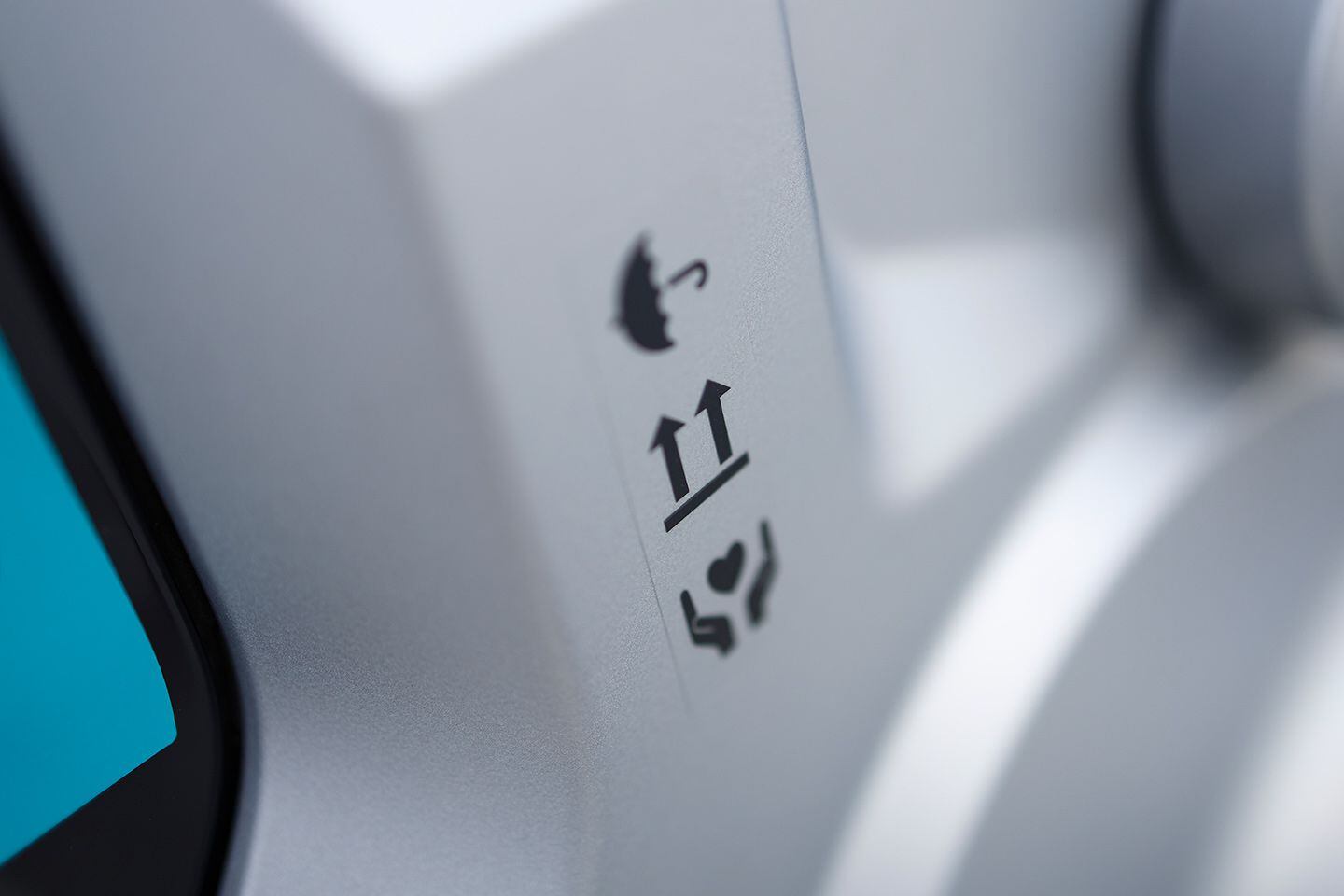
A compact steel chassis, inverted fork, preload-adjustable shock mated to a single-sided swingarm, and 14-inch wheels provide crisp handling. (BMW/)Chassis
The CE 02′s super-compact chassis comprises a steel double-loop frame with an upside-down 37mm fork and a single-sided swingarm and directly mounted, preload-adjustable shock. Wheelbase is just 53.2 inches, the head angle is steep at 24.5 degrees, and the wheels are just 14 inches in diameter, suggesting agility was a high priority for BMW. Braking is via a 239mm disc up front and a 220mm disc at the rear, with ABS on the front wheel only.
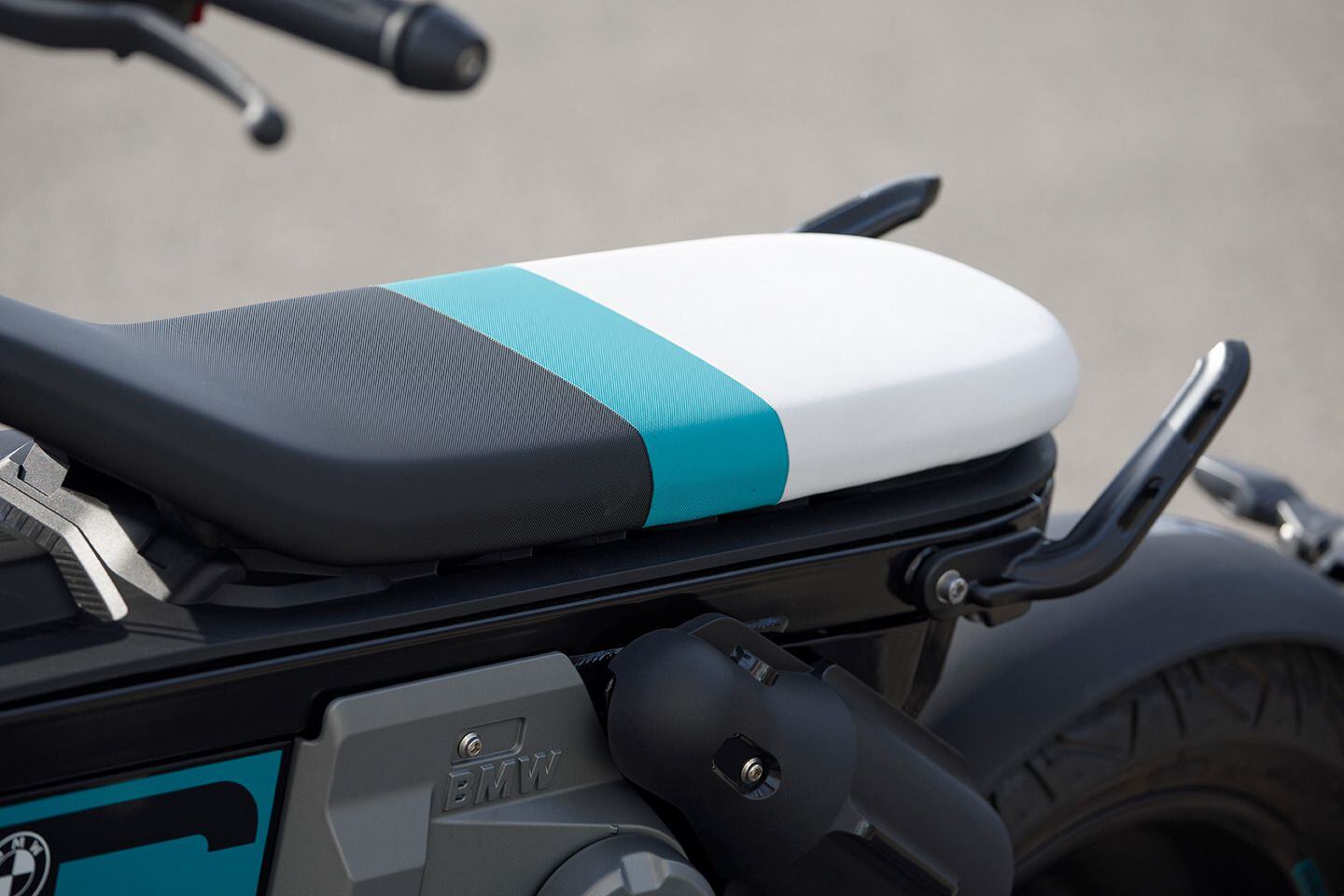
A pair of 48-volt batteries rated at 1.96kWh reside under the skateboard-style seat. (BMW/)Much of the bike’s 291 pounds (the single-battery 4-hp version weighs 262 pounds, and is available only in Europe) are accounted for by the batteries and the motor. The batteries are stored under the skateboard-style seat, while the motor is positioned low in the chassis to give a natural balance to the bike’s low-speed handling. The riding position is upright like a BMX bike, and there are two options for your feet: either on pegs that are mounted slightly forward like footboards on a conventional scooter, or on the pillion pegs which are set farther back, like rearsets on a sportbike. As there are no foot controls (both brake levers are on the bars) you can switch between pegs as you ride to suit your mood and the moment.
The CE 02′s steering is responsive to the touch and predictably quick; so fast it has made a turn or jumped into a gap seemingly before you’ve thought about it. Stability is superb, even at 62 mph, but you need to be aware that the slightest input by the rider will affect the steering.
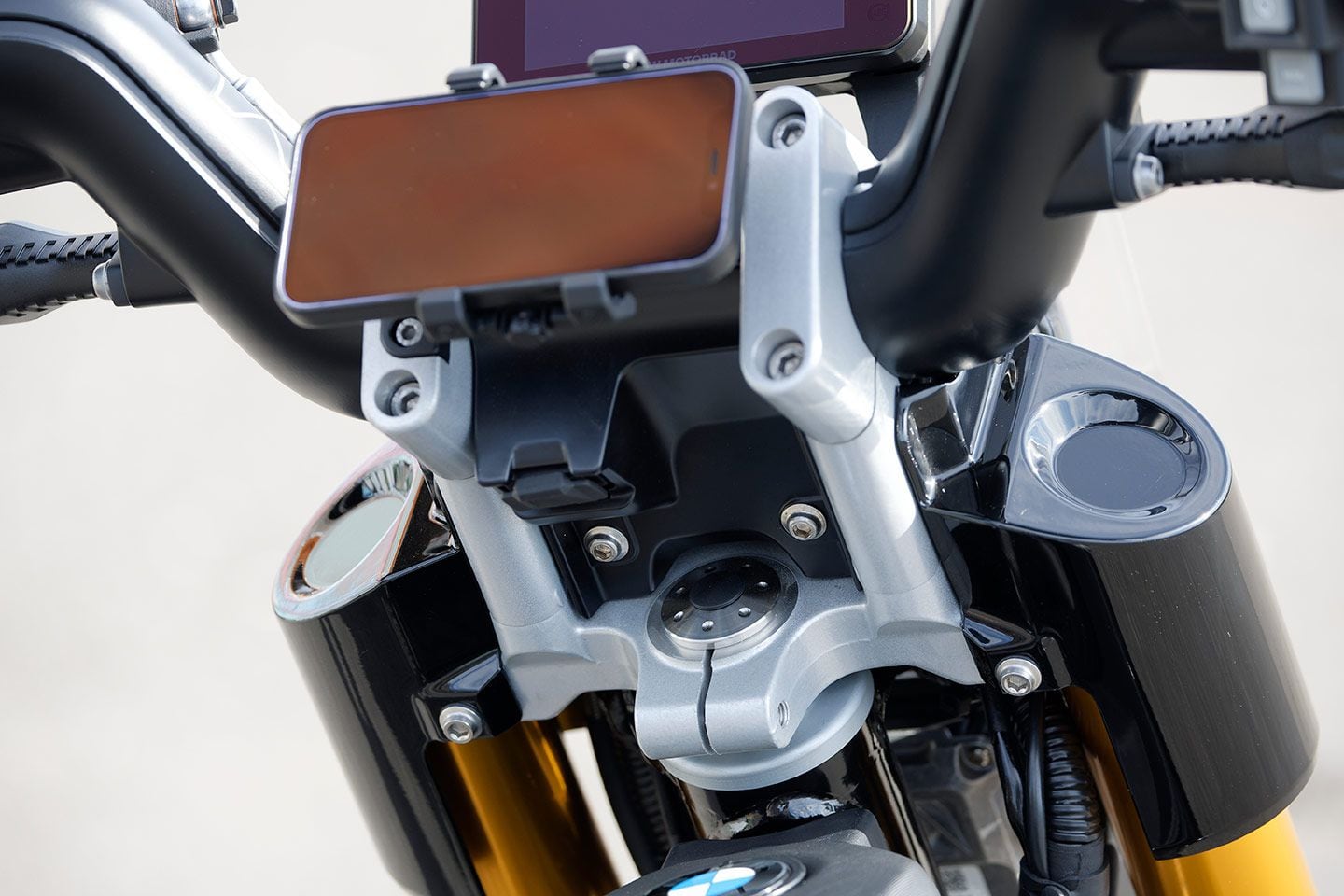
The riding position is upright and similar to a BMX bike. (BMW/)Ride quality is excellent, and the CE 02 soaked up all the cobblestones and potholes Lisbon could throw at it. The suspension is soft but supportive, though the rear can feel a little harsh when jumping over speed bumps and hitting imperfections at speed. There are none of the bangs and rattles you hear on many silent-running e-scooters, even when hitting those cobbles at speed, which is a sign of quality. Incidentally, Cycle World’s test machine was fitted with the Highline package plus an optional comfort seat, suggesting the standard “skateboard” seat might not be overly sumptuous.
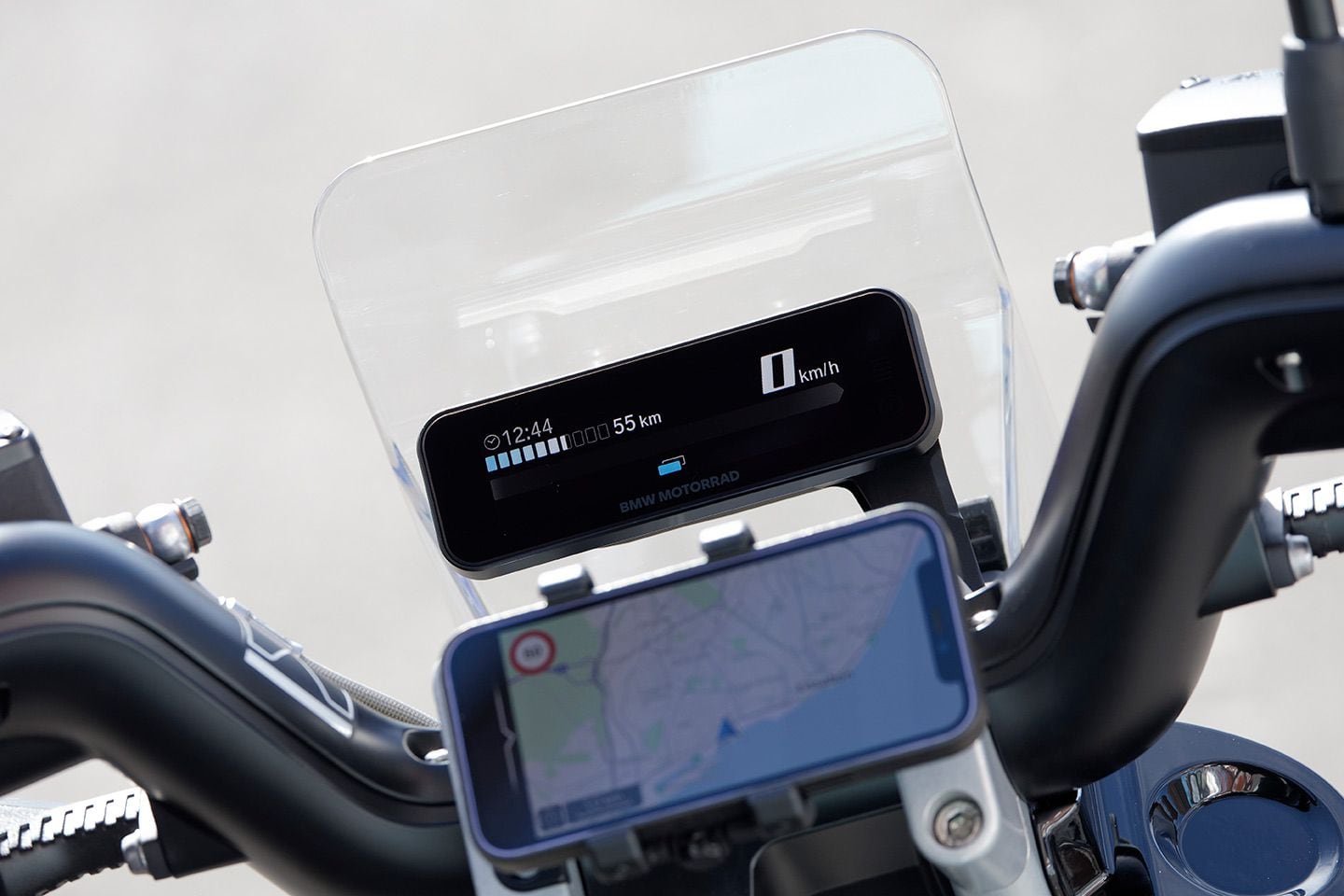
The small TFT display has basic info, but add the BMW Motorrad Connected app (standard on the Highline package, and you can navigate and get more machine info. (BMW/)The TFT micro-dash is clear and functional and gives a mileage range and percentage of battery used. Riding briskly around hilly Lisbon, I covered 32.5 miles and had 16 miles or 27 percent battery remaining, which suggests a range of 48 miles, though in reality you could expect more as your riding style adapts to the range remaining, much as you would with the fuel warning light on. As we tested the Highline model, we got the opportunity to test the included BMW Motorrad Connected app which, combined with the bar-mounted smartphone holder, delivered clear navigation around Lisbon via the switch gear on the left bar.
Conclusion
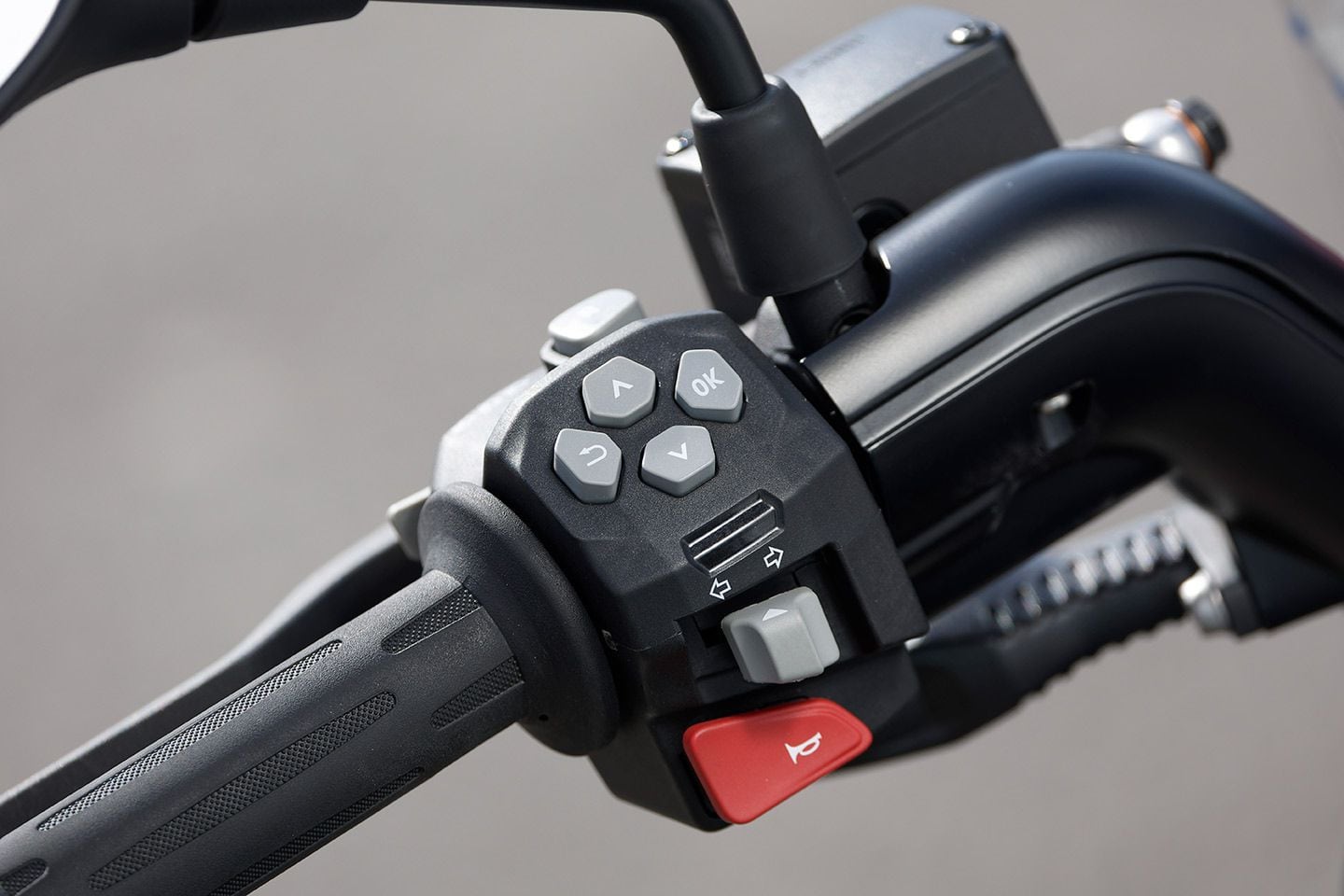
The left switch gear has simple controls for navigating the dash’s menus. (BMW/)Overall, there is no denying that the build quality and level of finish of the CE 02 are better than any other gas or electric scooter in this segment, or that it is a brilliant, charismatic, and enjoyable way to deal with the daily commute, and the best electric bike in this segment by far. But it’s hard to ignore the price: $7,599 for the 11kW (125cc-equivalent) version and, with the Highline package, $876 more. Add some luggage and a comfort seat and you’re up at around $9K, that is about a grand more than Vespa’s Elettrica.
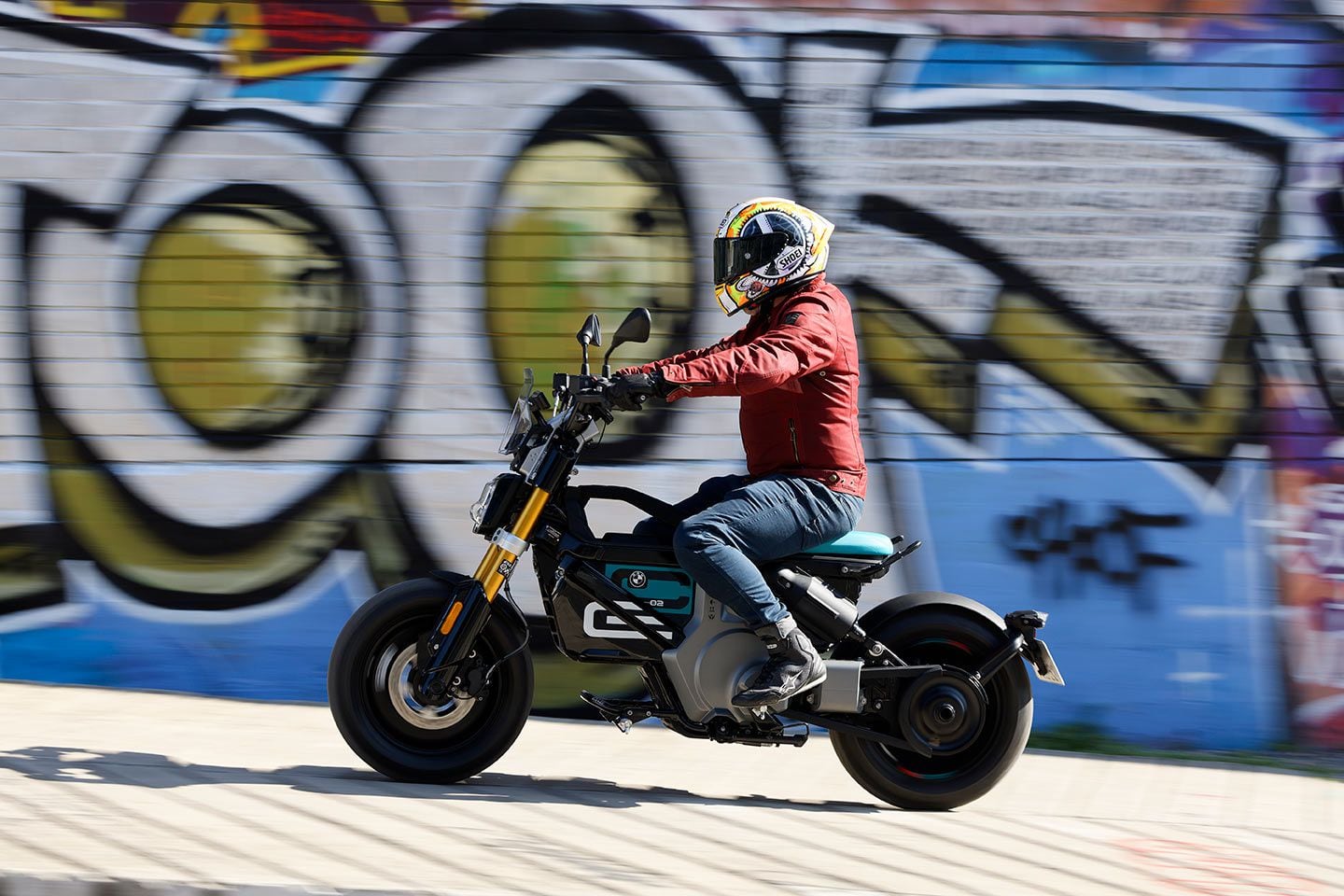
Even when bounding over potholes and cobblestone roads, the CE 02 rides completely silent with excellent build quality. (BMW/)Zipping around Lisbon in relative quiet was truly enjoyable. Safe, predictable handling allied to fast steering, a lack of bulk, and enough oomph to keep you in the fight away from the lights made for a fun, dynamic urban ride; so good I’d take the BMW over any gasoline equivalent.
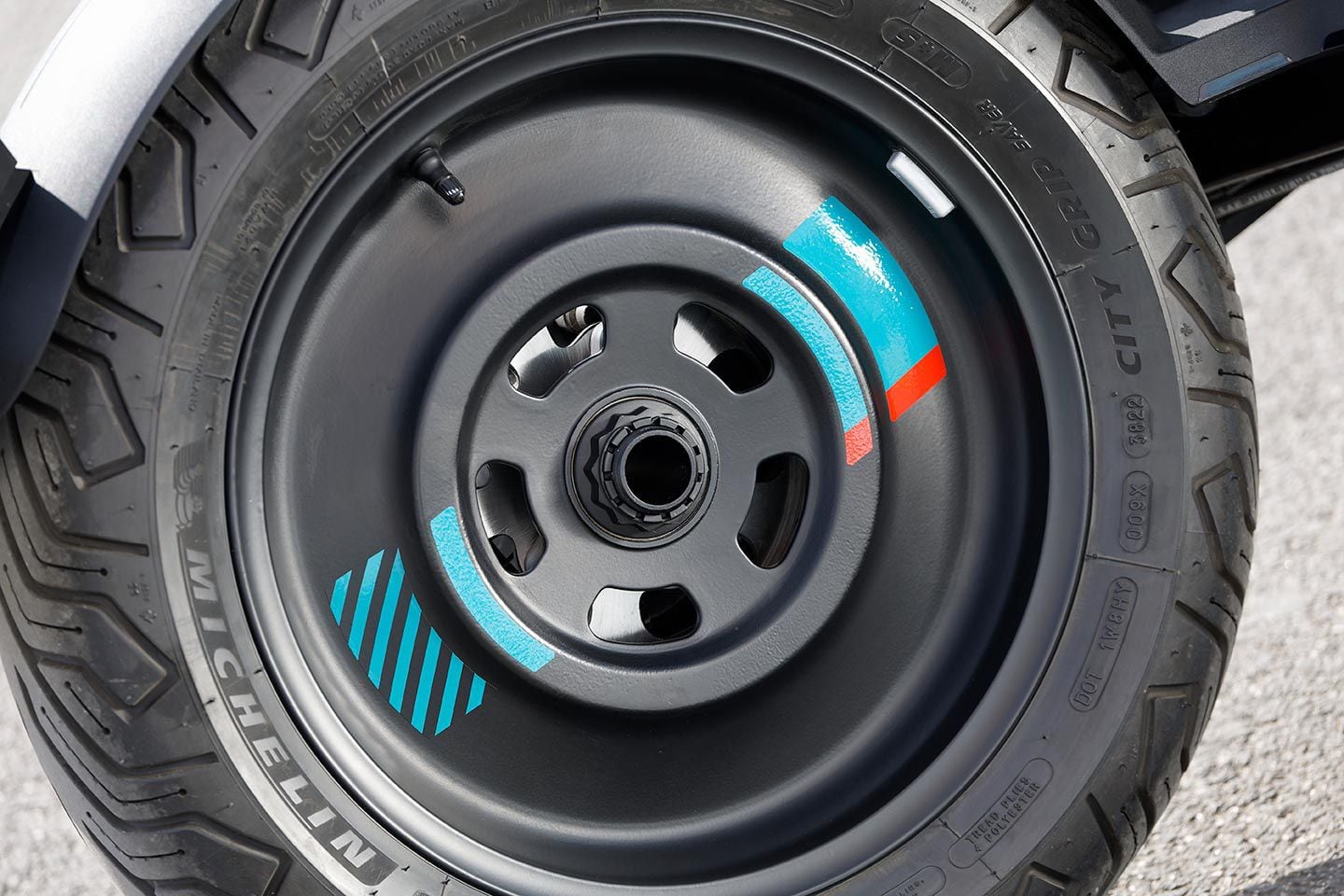
The CE 02’s open rear wheel. (BMW/)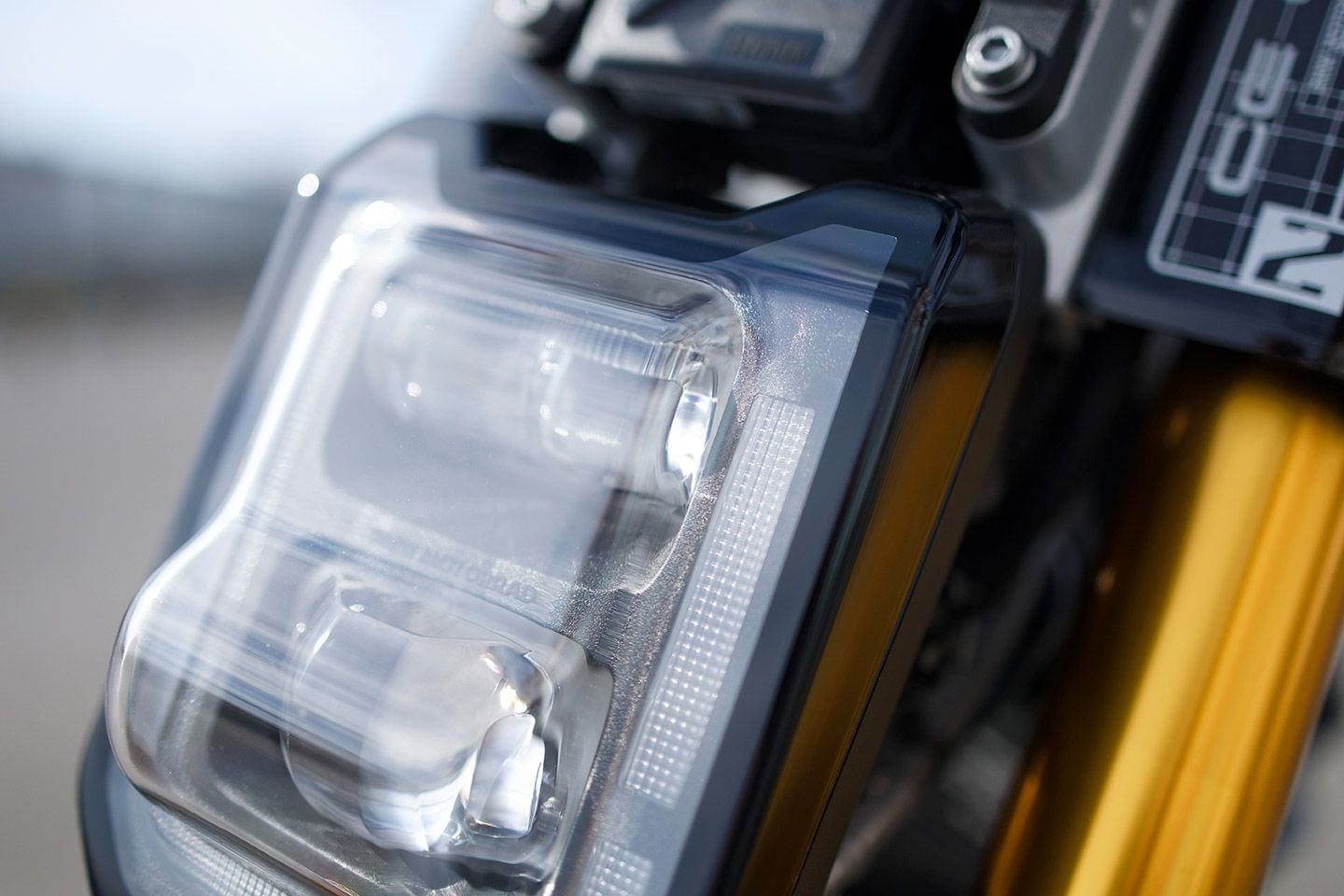
BMW CE 02’s headlight. (BMW/)2024 BMW CE 02 Specs
MSRP: $7,599 Motor: Air-cooled excited synchronous Rated Capacity: 8 hp Maximum Power: 15 hp @ 5,000 rpm Maximum Torque: 40.5 lb.-ft. @ 1,000 rpm Maximum Speed: 59 mph Battery: Two air-cooled lithium-ion batteries, 3.92kWh Voltage: 48V Charging: 0.9kW w/ integrated charger; 1.5kW quick charger w/ optional Highline package Charge Time: Standard 2 hr. 40 min. to 80%; 1 hr. 40 min. for 80% w/ quick charger Transmission: 1-speed, integrated into motor housing/belt drive Frame: Steel double loop Front Suspension: 37mm inverted telescopic fork; 4.6 in. travel Rear Suspension: Single-sided swingarm w/ direct-link shock, spring preload adjustable; 2.2 in. travel Front Brake: 2-piston floating caliper, 239mm disc w/ ABS Rear Brake: 1-piston floating caliper, 220mm disc Wheels, Front/Rear: Cast aluminum; 14 x 2.50 in. / 14 x 3.50 in. Tires, Front/Rear: 120/80-14 / 150/70-14 Steering Head Angle/Trail: 24.5°/3.6 in. Wheelbase: 53.2 in. Seat Height: 29.5 in. Curb Weight: 291 lb. Contact: bmwmotorcycles.com -
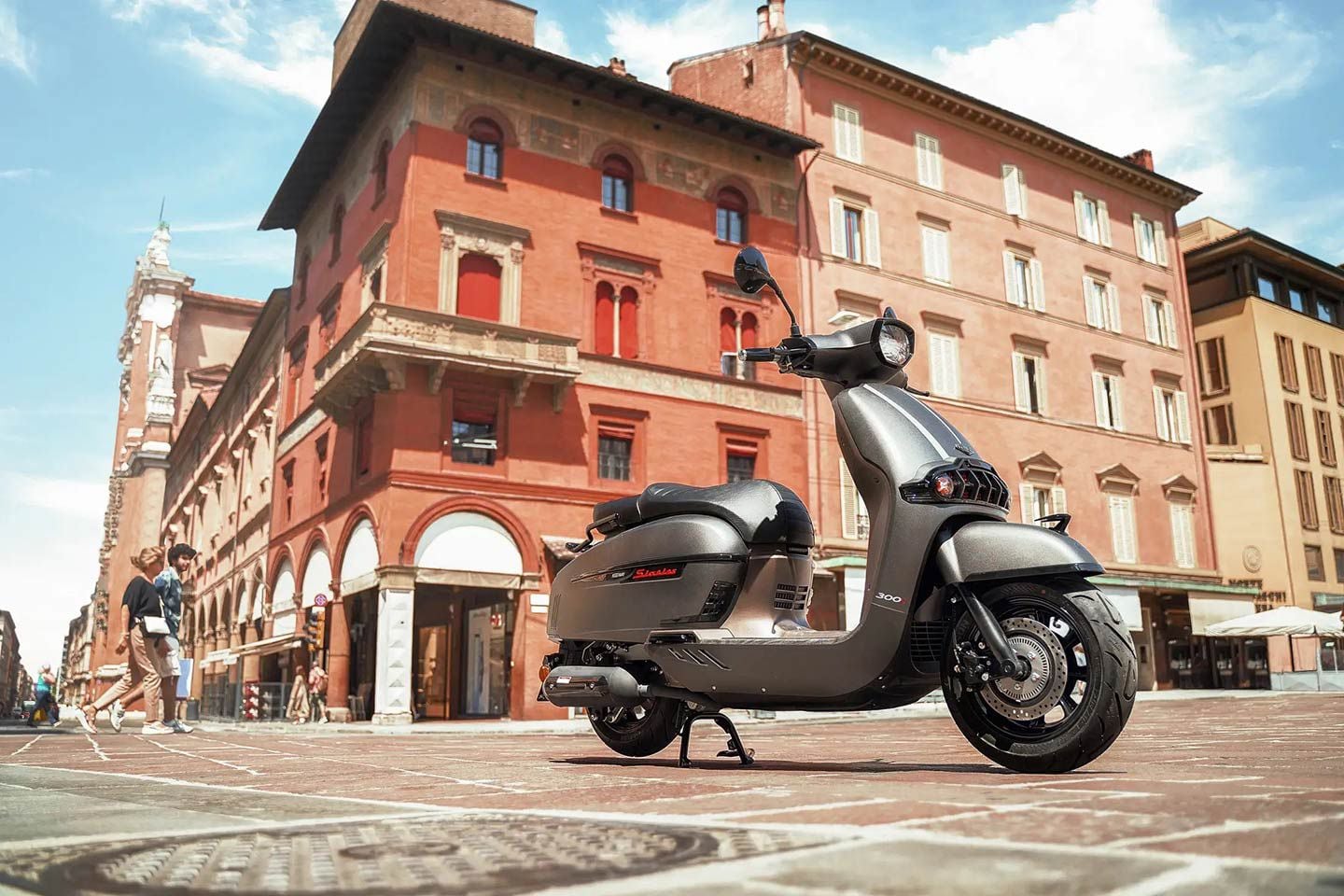
Keeway is rolling out its first batch of US models for the 2024 model year. (Keeway America/)Keeway America has just announced its initial batch of 2024 models for the US market, but it might be helpful to first rehash out the brand’s background a bit. As you already know, the Italian Benelli marque was acquired jointly by manufacturing giant Qianjiang Motorcycle Group and the (separate) Keeway Group, which now manages the Benelli brand. Keeway, however, also makes its own line of bikes and scooters, and is continuing its push in North America with the first part of its US lineup for the 2024 model year—under the Keeway America arm. The models (most of which have appeared elsewhere overseas) include the vintage-inspired Sixties 300I and Versilia 150 scooters, the more sleekly styled Vieste 200 scooter, and the small-bore V302C V-twin cruiser.
Related: Morbidelli Comeback
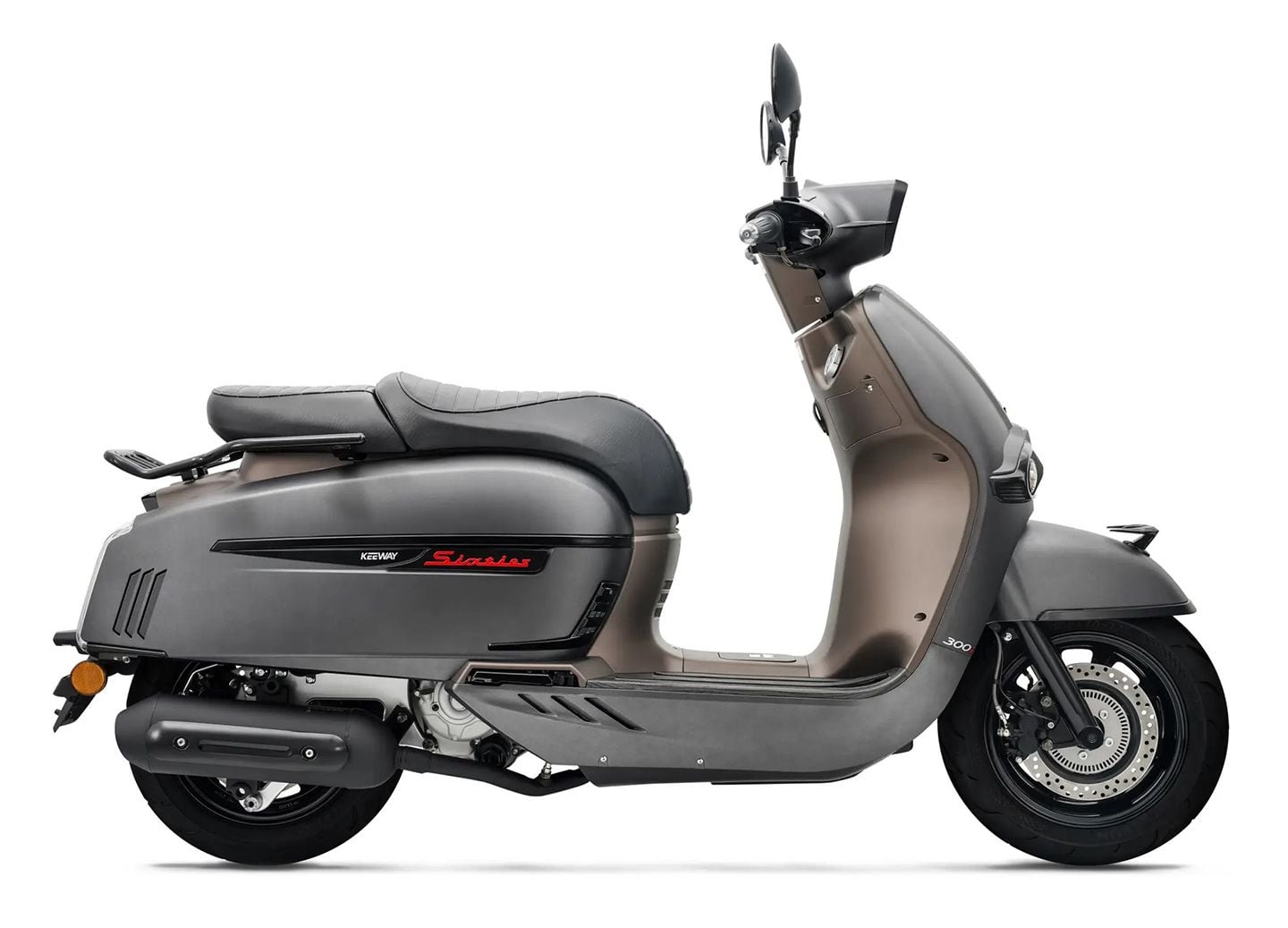
The new 25-hp retro-styled Sixties 300I leads the Keeway scooter lineup for 2024. (Keeway America/)2024 Keeway Sixties 300I
The new Sixties 300I scooter looks to be Keeway’s flagship model—at least here in the States—and aside from the retro-heavy styling, comes equipped with a fairly robust set of modern features, like a liquid-cooled 278cc single-cylinder four-valve engine producing a zippy 25 hp at 8,250 rpm and 17.7 lb.-ft. of torque at 7,000 rpm, with a top speed of 75 mph. Other welcome features include EFI, and a KYB telescopic front fork paired with dual KYB shocks that offer preload adjustability in the rear, while the fairly hefty (for a scooter) 230mm brake discs up front are clamped by Nissin calipers and further bolstered by Bosch ABS.
The Sixties 300 has appealing retro style, with a vaguely 1960s feel throughout, from the front-fender ornament and a vintage-y front grille with integrated turn signals, to the separate quilted seat pads for rider and passenger, and flowing side panels capped by finned LED taillights. The Sixties 300′s multicolored digital dash features digital and analog gauges, and a roomy underseat cargo hold as well as a rear luggage rack.
The Sixties 300I is available in Sky Blue, Matte Black, or white, and has an MSRP of $5,299.
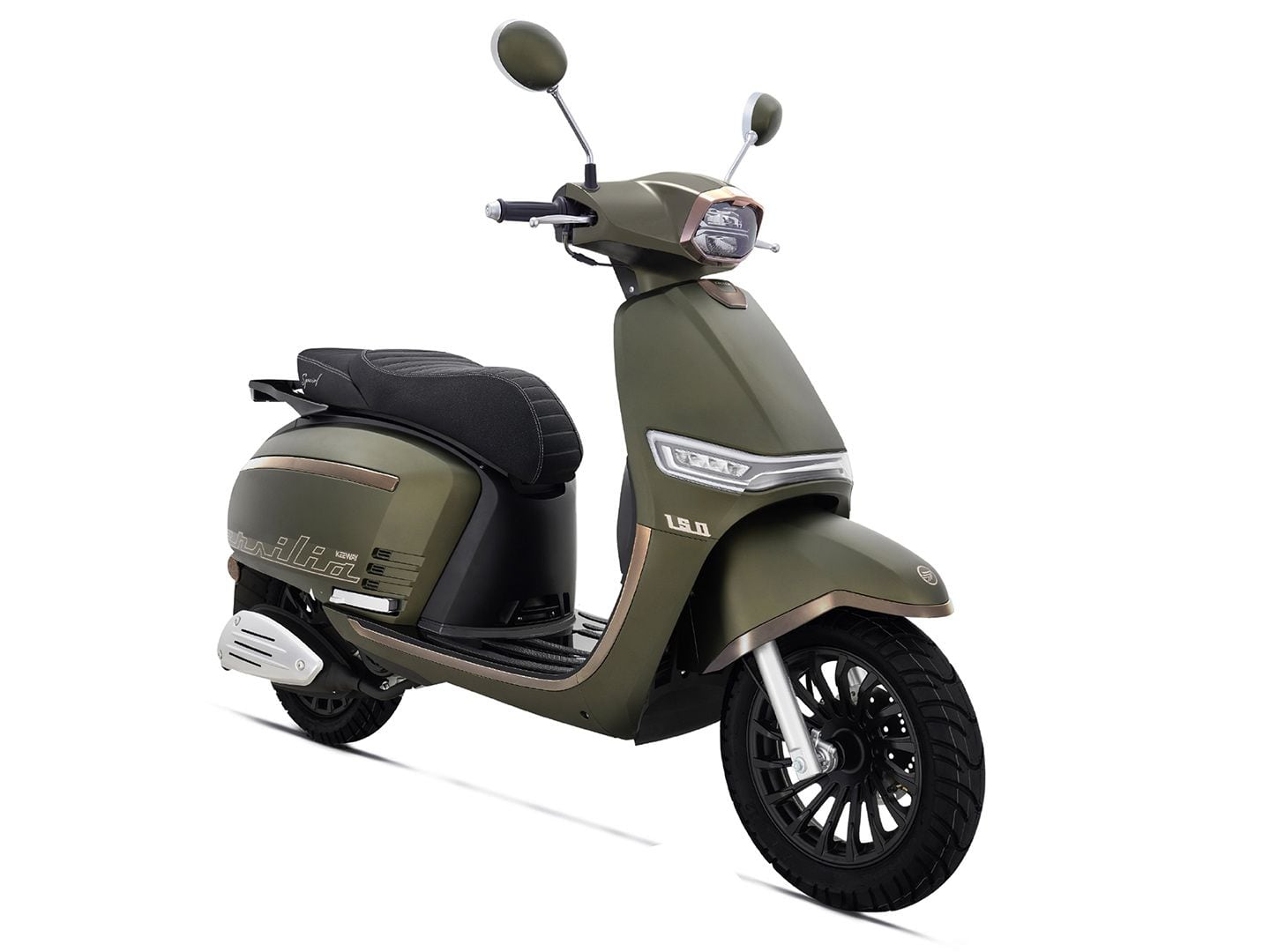
The smaller Versilia 150 has half the displacement and power—with a price tag to match. (Color shown is Asian market only.) (Keeway America/)2024 Keeway Versilia 150
The smaller Versilia 150 tones down the classic vibes a bit and offers more basic equipment, centered around an air-cooled 149.6cc fuel-injected engine good for 9.7 hp at 7,000 rpm. Final drive is through a twist-and-go CVT transmission, while braking is handled by a front single disc and rear drum. The smaller relative of the Sixties 300 still gets LED lighting all-around, leading with a stacked retro unit and modern DRL. Out back a minimalist taillight is bracketed by rear turn signals that are incorporated into the bodywork for a smooth look, while a luggage rack sits behind the one-piece custom seat. Naturally, there’s underseat storage for a helmet or groceries. Modern touches include a locking glove box with USB port and keyless ignition.
The Versilia 150 can be had in gray, red, or white, with an MSRP of $2,499.
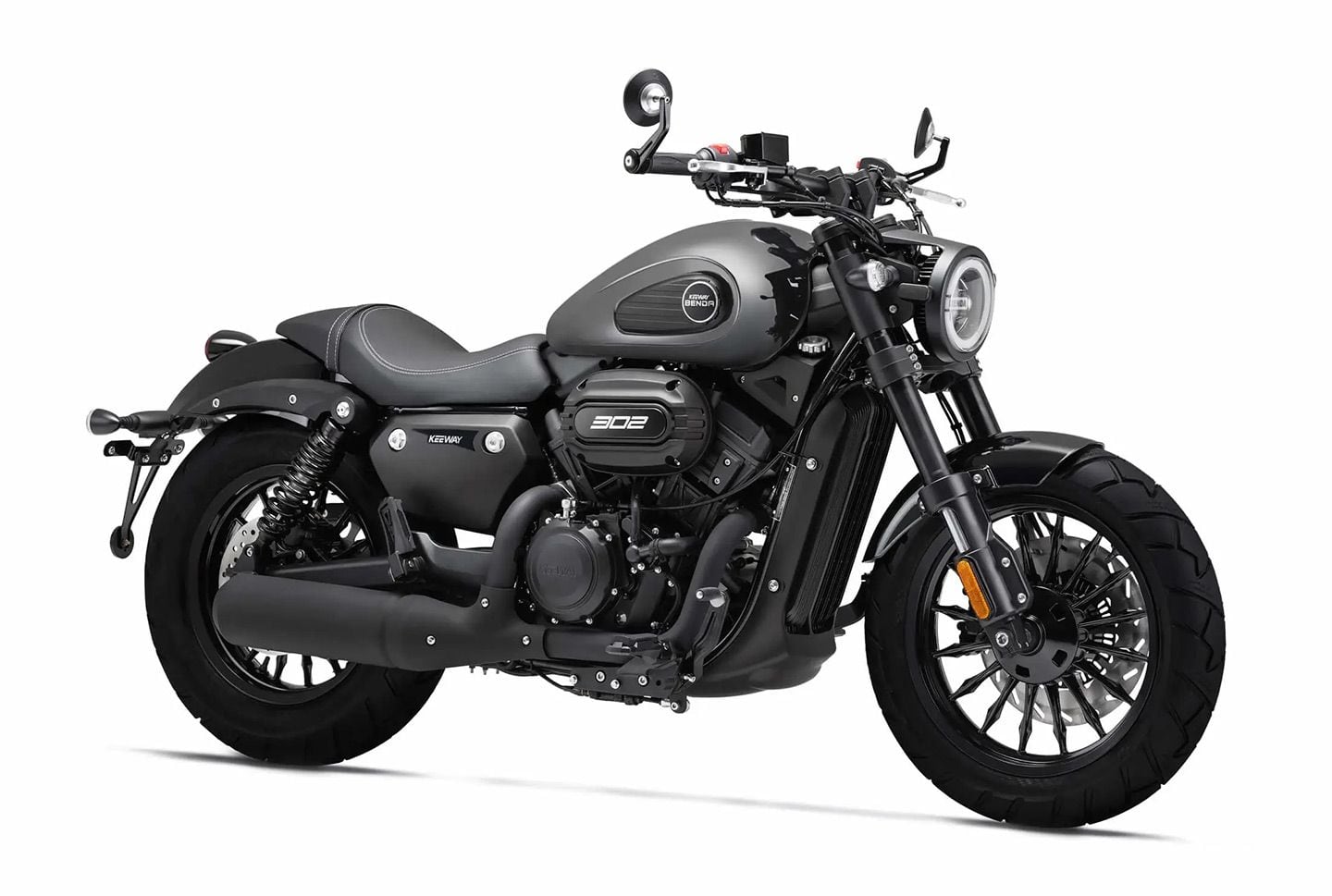
The nicely equipped V302C cruiser has been in the lineup for a couple of years now, and has an MSRP of under $5K. (Keeway America/)2024 Keeway V302C
Keeway’s main cruiser entry is the V302C, which is powered by a liquid-cooled fuel-injected SOHC 298cc V-twin with eight valves. Keeway claims it generates 30 hp at 8,500 rpm and 19.5 lb.-ft. of torque flowing through a manual six-speed transmission via belt final drive. The better-than-expected component list includes stout upside-down fork legs with 4.5 inches of travel, preload-adjustable dual shocks, a slipper clutch, and meaty 300mm front brake disc mated to a radial-mounted caliper backed up by a 240mm rear disc, each with ABS.
Set around the shorty bars is a round digital dash with tach, a speedometer, fuel gauge, gear indicator, odometer, and clock. The V302C goes for a more modern look with its blacked-out bars, wheels, exhaust, fork legs, and engine, though all lighting is LED, featuring a ringed driving light inside the headlight’s black bucket.
The V302C’s low profile is enhanced by its super-low 27.1-inch seat height, with a 120/80-16 front tire and a 150/80-15 rear riding below. The whole package weighs in at a very manageable 367 pounds too.
The V302C is available in black, red, or gray, with an MSRP of $4,999.
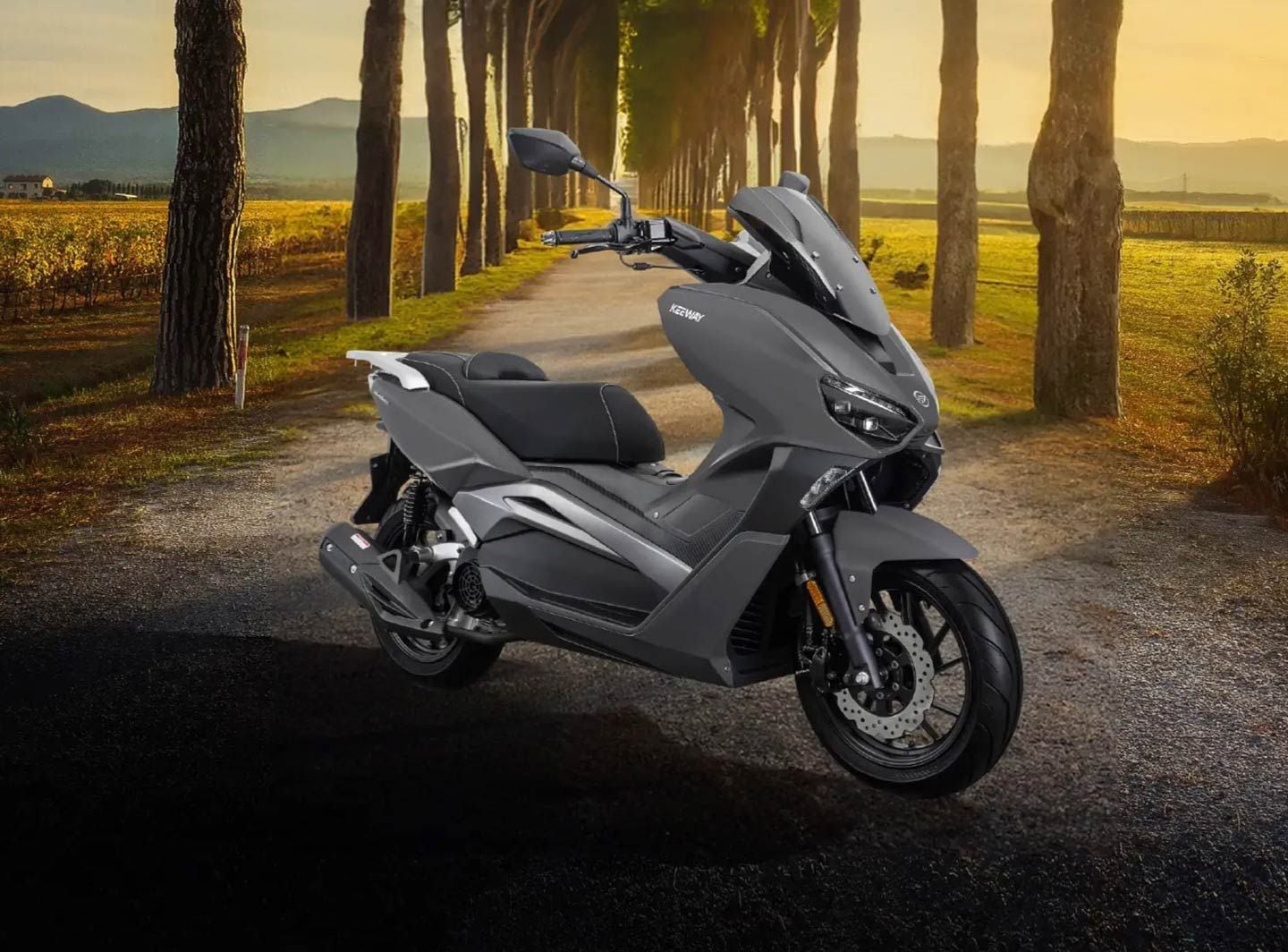
Keeway offers multiple scooters in its lineup both here and abroad. The Vieste 200 represents a modern spin on the midi class with shaper edges and dynamic bodywork. (Keeway America/)2024 Keeway Vieste 200
On the other end of the scooter-style spectrum is the Vieste 200, Keeway’s modern spin on the class. The futuristic styling is capped by four LED projector headlights with DRLs, LED turn signals and taillight, and wind protection marked by an aggressively swooped fairing. The tech is pretty middle of the road though, with a 171.7cc single-cylinder air-cooled engine putting out 11.4 hp at 7,500 rpm, and 8.9 lb.-ft. of torque at 5,500 rpm. Top speed is 59 mph at the end of the CVT final drive. Suspension too is a basic telescopic fork up front and dual shocks in the rear, though braking features discs at each end, with a 240mm platter up front and 215mm at the rear, both with CBS.
Analog gauges dominate the dash and are bracketed by digital displays of temperature, odometer, tripmeter, clock, and fuel. Rear grab rails come standard, along with storage pockets, a USB port, and a large storage bin under the seat.
The Vieste 200 is available in blue, gray, or white, with an MSRP of $3,399.
-
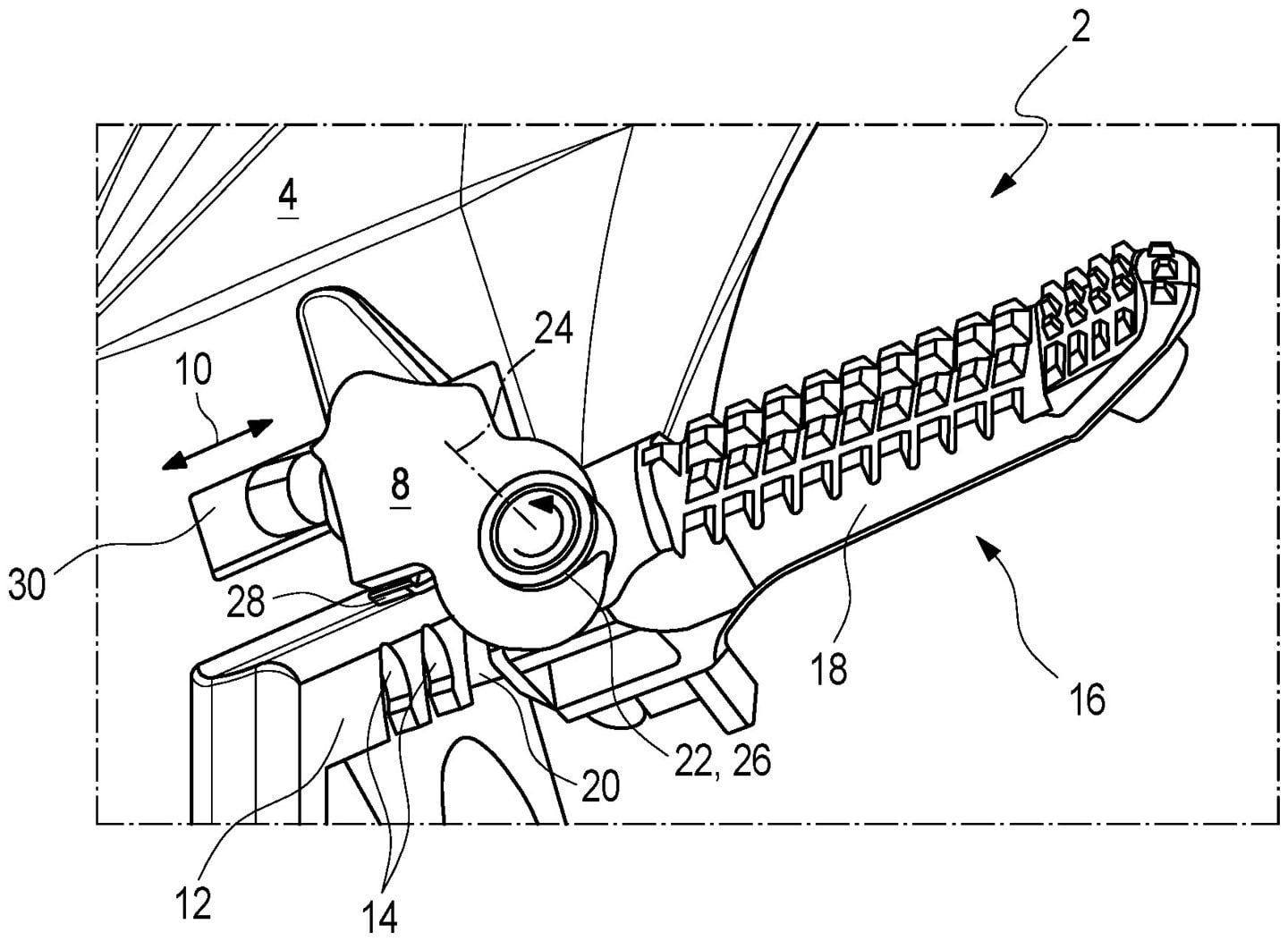
By not having to also adjust the brake or shift levers the execution can be greatly simplified. ( BMW/)Adjustable footpegs are far from a new idea but even on motorcycles that have them the adjustment process normally involves wrenches and hex keys. So a new patent application from BMW showing pegs that can be moved in seconds without any tools is interesting in itself. But the idea has specifically come about thanks to the company’s development of electric bikes—adding to a growing file of evidence that a BMW EV motorcycle is getting close.
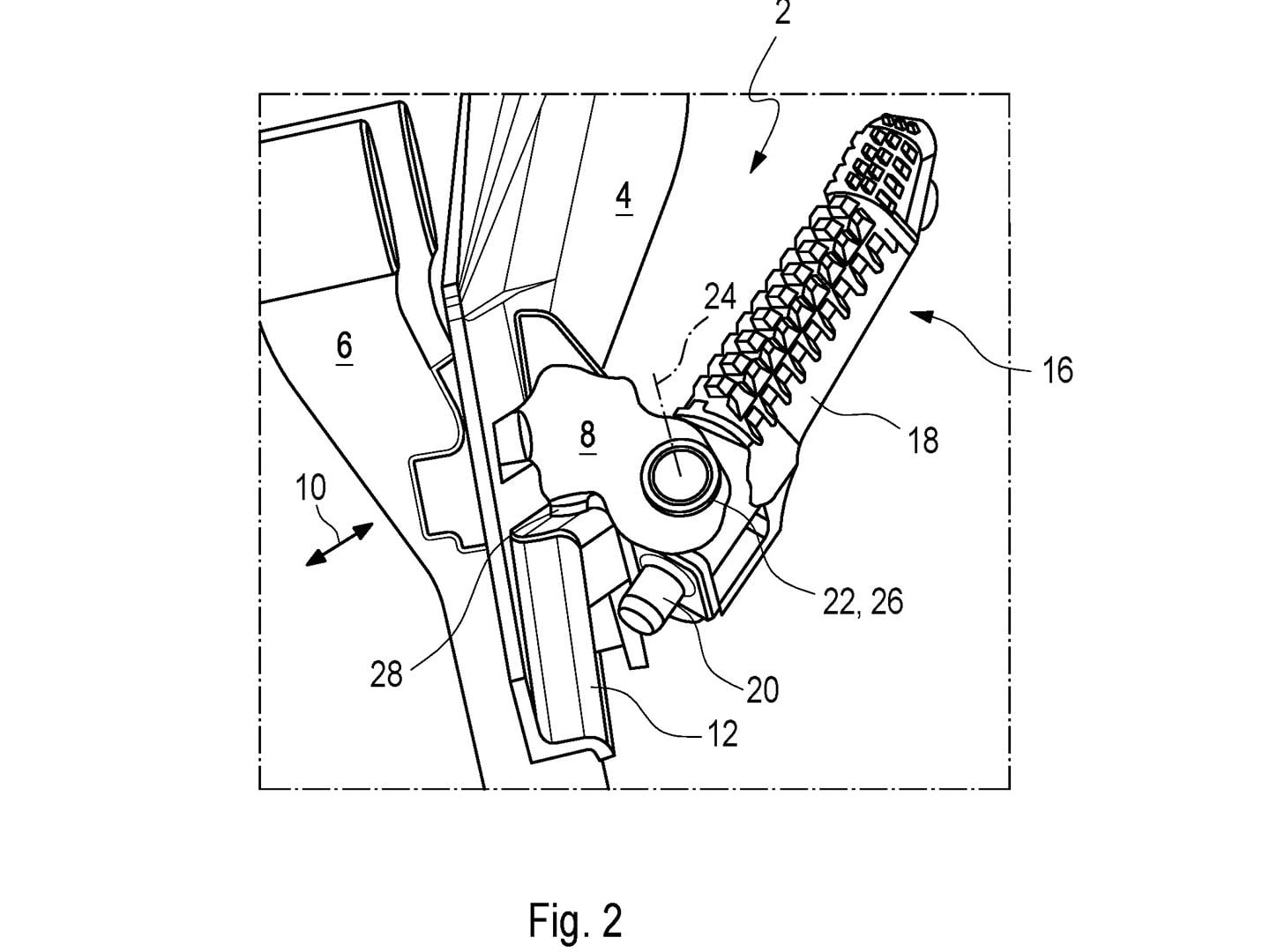
When the footpeg is folded up the pin (20) comes out of the toothed channel and allows adjustment. (BMW/)The system illustrated in the new patent is incredibly simple—the sort of thing that makes you wonder why it hasn’t been done already. It shows riders’ footpegs that are mounted in a slotted carrier that allows them to slide, but there’s no need to loosen bolts to move them. Instead there’s a sawtooth patterned set of notches machined into the aluminum hanger below the adjustment slot and a stud that extends inward, directly opposite the peg itself, to fit into it. The peg itself is hinged like those on most bikes. When the peg is extended into its normal position, the stud opposite it locks into one of the notches, preventing it from sliding along the slot in the carrier. To adjust the peg, you simply fold it upward, disengaging that stud from the notches so the whole unit can slide along its adjustment slot.
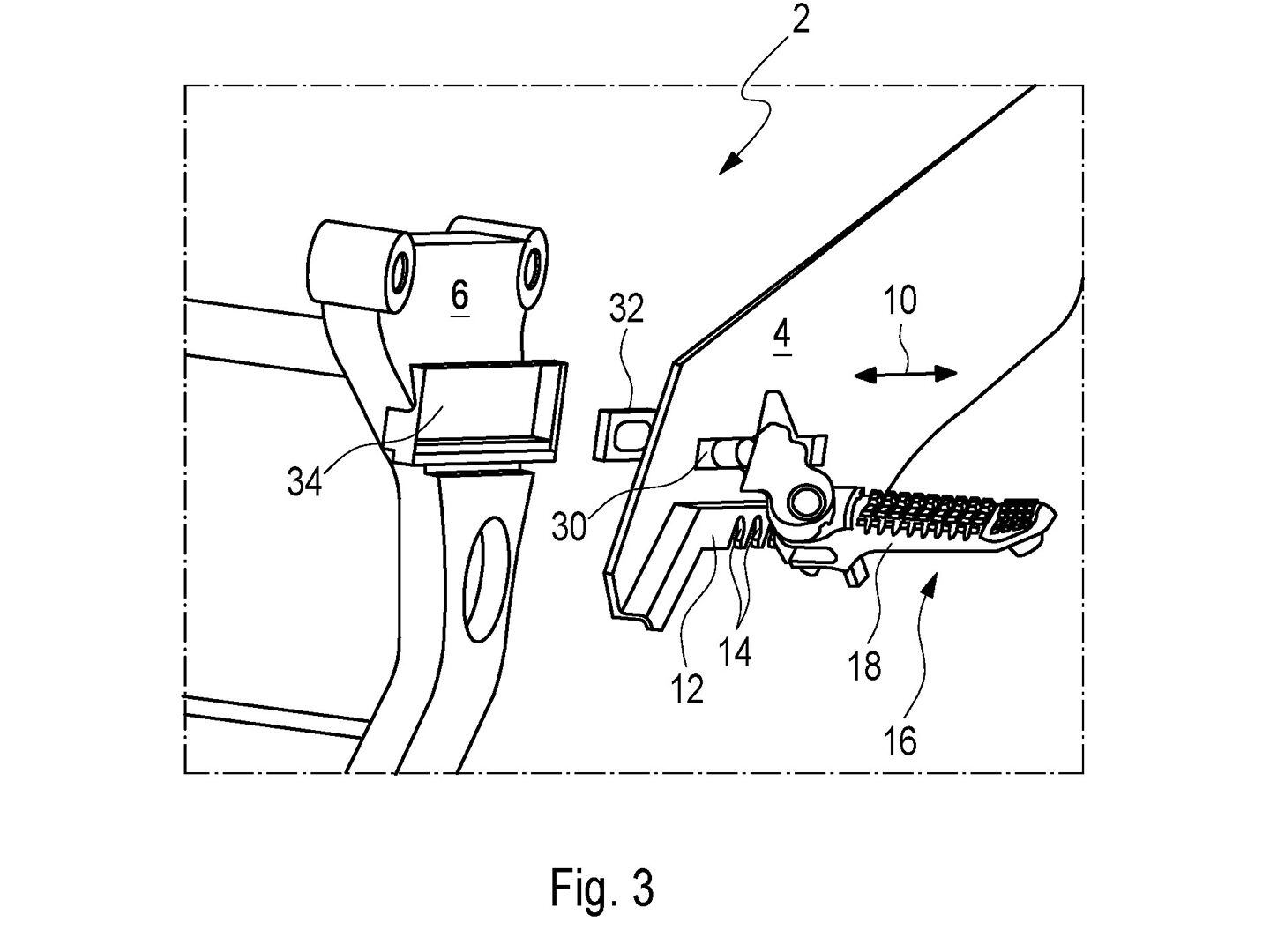
When folded down into place for riding, the pin locks into the toothed channel (12). (BMW/)BMW’s patent explains that the slot could be straight or curved, and in a variety of directions depending on the bike the system is fitted to. On a sportbike, for instance, it might slide backward and upward for track use, and forward and downward when you want a more relaxed riding position.
Simple, right? So how does the patent point to electric bikes? The answer is that the adjustment system isn’t easily combined with a manual gearshift and rear brake lever that are found on most combustion-engine machines. But on a single-speed electric bike, where the rear brake is controlled by your left hand instead of your right foot, the pegs are there simply as a place to put your feet, making this adjustment system a logical thing to adopt.
The patent itself is specific about that point, saying: “It is known in tilting vehicles to provide mechanical components that can be actuated with a foot, such as foot-shift levers and foot brakes, in or on a footrest. This allows a user of the tilting vehicle to shift into different gears or operate a brake with their foot. Due to the mechanical connection of the mechanical components to a clutch or to a braking system, the known footrests are installed in a stationary manner on the tilting vehicle.” But then it adds, “If the tilting vehicle includes an electric tilting vehicle, the installed footrests can be designed without function.”
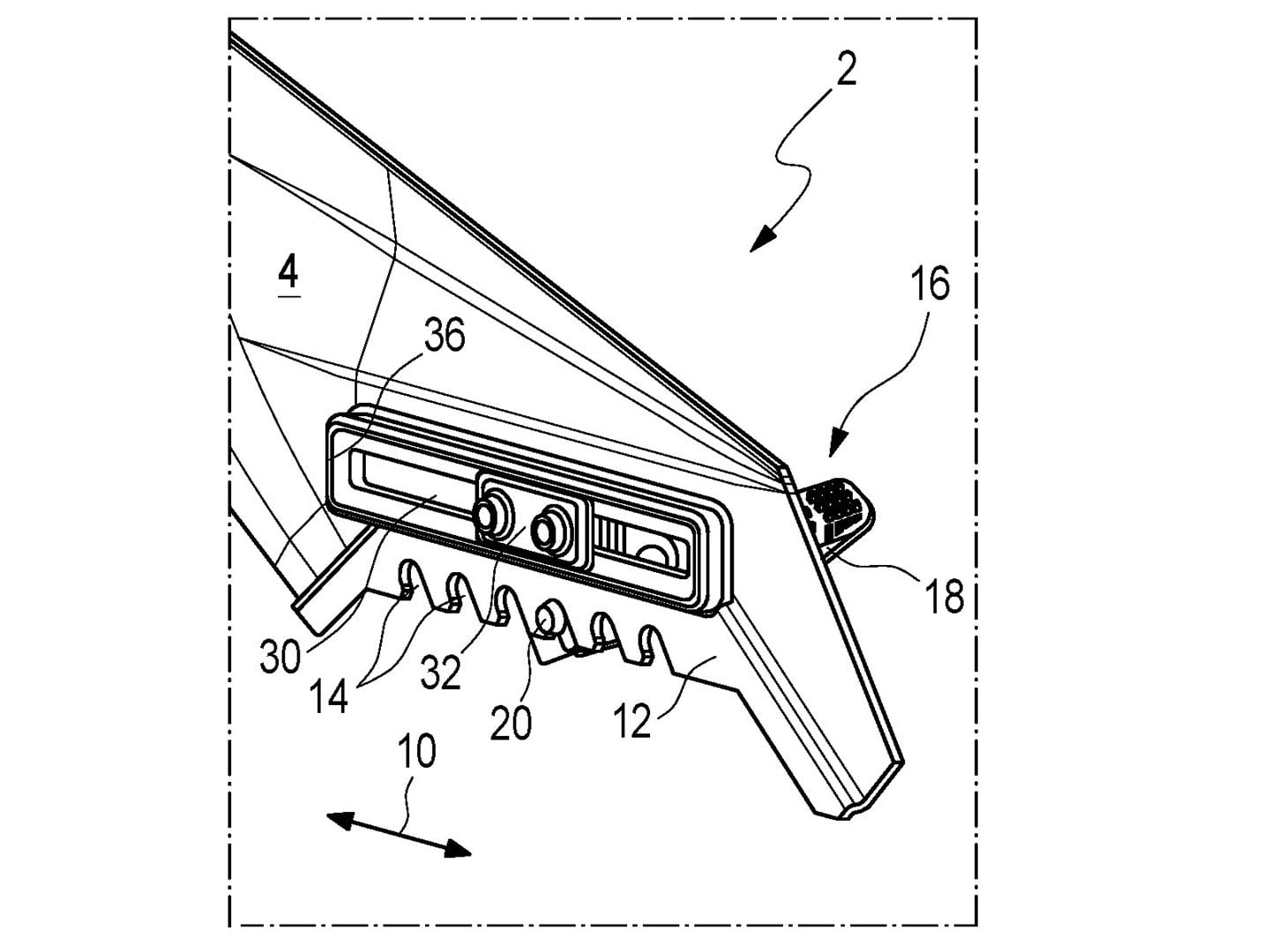
The backside view shows the pin (20) locked into the toothed notch in the track. (BMW/)Since this is a patent application and BMW wants to cover all the bases, the document does go on to say that “if the tilting vehicle can be driven by an internal combustion engine, a shift lever or brake lever arranged on the locking means can also be moved when the locking means is adjusted.” But the illustrations don’t show how a gearshift and rear brake might be attached.
What the illustrations do show is a set of pegs mounted on an aluminum rear frame section, with the swingarm pivot clearly visible and two bolt holes to mount to the main section of the bike’s chassis. It’s a pretty common layout, but not one that matches any bikes in BMW’s current lineup. What it does match quite closely is the patent for a large electric bike that we wrote about earlier this year, which featured much the same bolt-on swingarm pivot area, attaching to a big, structural battery case.
Is it incontrovertible evidence that a BMW electric motorcycle will imminently join the company’s lineup, alongside its existing range of CE electric scooters? Not quite. But when combined with other hints, ranging from the company’s 2019 Vision DC electric concept bike to a host of trademark applications for electric motorcycles wearing the “DC” name and patent applications for multiple electric motorcycle designs, it’s becoming increasingly clear that we can expect a battery-powered BMW bike sooner rather than later.
-
Are three wheels better than two?
-

That lever on the handlebar is something typically out of place on an electric motorcycle like Zero’s SR/F. (Zero/)Earlier this year, we revealed how Kymco plans to include an electronically simulated clutch and gearbox on upcoming electric motorcycles. Now it looks like Zero Motorcycles is thinking along similar lines, filing its own patent application for a faux clutch lever that modulates torque and regenerative braking to simulate the feeling and control an internal combustion engine-powered bike’s clutch.
Although it would be easy to write this fake clutch off as a gimmick to appease stuck-in-the-past riders brought up on a diet of internal combustion engines, that would do the idea an injustice. After all, the clutch on an ICE bike is far more than simply an on/off switch to connect or disconnect drive to the rear wheel. It’s also a tool that we all tend to use to add finesse while riding, promoting an extra dimension of control. Whether it’s to modulate torque when you’re pulling away from standstill or working in harmony with downshifts to add a variable level of engine-braking, the clutch is an integral part of riding, and for those jumping on an electric bike for the first time it’s a control that’s particularly noticeable by its absence.
Zero, like Kymco, appears to recognise the subtle control that a clutch offers and this new patent shows how the company wants to use the fingers of your left hand (left redundant on the company’s current range of bikes) as a constant control over the adjustable torque and regenerative braking of its electric motors. The company’s new patent application shows a completely normal-looking “clutch” lever and explains how it would be tied into the motor’s control electronics while giving familiar feedback to riders.

Not a part typically associated with an electric motorcycle. (Zero/)In terms of feeling, the patent says: “To mimic the feel of a traditional clutch, the kinematic relationship among the left-hand control lever, the linkages, rotational sensor, yoke, etc., may be configured such that the driver of the vehicle initially feels a steep ramp-up in resistance when moving the left-hand control lever away from its rest position, followed by a peak dwell or plateau, then followed by a significant let-off, as the left-hand control lever approaches its fully retracted position. As the driver of the vehicle reduces pressure on the left-hand control lever it is urged toward its rest position by spring.” In other words it will be just what you expect if you’re used to a combustion engine bike.
In operation, too, the results of using the lever will be familiar, even if it isn’t actually connecting or disconnecting drive via a set of clutch plates. The patent explains that: “By reducing the torque output by the motor, left-hand control lever mimics the operation and feel, e.g., slip, of a clutch of a multi-gear transmission present in motorcycles and other vehicles that are powered by internal combustion engines.”

The patent documents show a Zero SR/F; will that model perhaps be the first to get the faux clutch if it does in fact make it to production? (Zero/)We don’t use the clutch lever purely to reduce engine torque though. Sometimes it’s used to access higher engine revs and get an engine into a stronger part of its powerband than the selected gear would allow without it. For instance, if you use the clutch to instigate a wheelie. Zero has also recognized that and envisages programming its faux clutch lever to respond in the same way by monitoring the speed with which the lever is moved as well as its position.
The patent says: “For example, rapidly releasing the left-hand control lever from its fully engaged position may cause the controller to demand a short burst of torque from the motor that exceeds the torque demand indicated by the position of throttle, simulating or replicating the feel of ‘dropping the clutch’ in a vehicle that includes a multi-gear transmission and clutch.”

The current Zero SR/F has a one-speed transmission and no clutch lever, typical of most electric motorcycles. (Zero Motorcycles/)The same ideas apply during deceleration, when the pseudo-clutch can be used to soften or harden the effect of the bike’s regenerative braking. The patent explains that “the controller causes the motor to operate as a generator to deliver electrical energy to battery, and brake the vehicle as a function of the rotational position, angular displacement, force and/or pressure applied to the left-hand control lever. Additionally, the controller may take into account the rate of change of the rotational position, angular displacement, force and/or pressure applied to the left-hand control lever in determining the amount of regenerative braking to be applied. For example, a rapid movement of the left-hand control lever may indicate that the driver of vehicle is demanding a very high level of regenerative braking, e.g., while making an emergency stop, whereas a slower movement of the left-hand control lever may indicate less drastic regenerative braking demands.”
Kymco envisages combining its pseudo clutch with a simulated multispeed transmission operated by a familiar-looking set of foot controls. Zero’s patent leaves the door open for a similar approach and says that the system could be used alongside an automatic, clutchless gearbox but the document doesn’t make any mention of giving your left foot control over fake gear ratios. All the images in the document show the fake clutch fitted to Zero’s SR/F, suggesting that if it’s heading for production, that’s the model we’ll see it on first.
-
 1
1
-
-
There's been no official word yet, but there's reason to believe it could be.
-
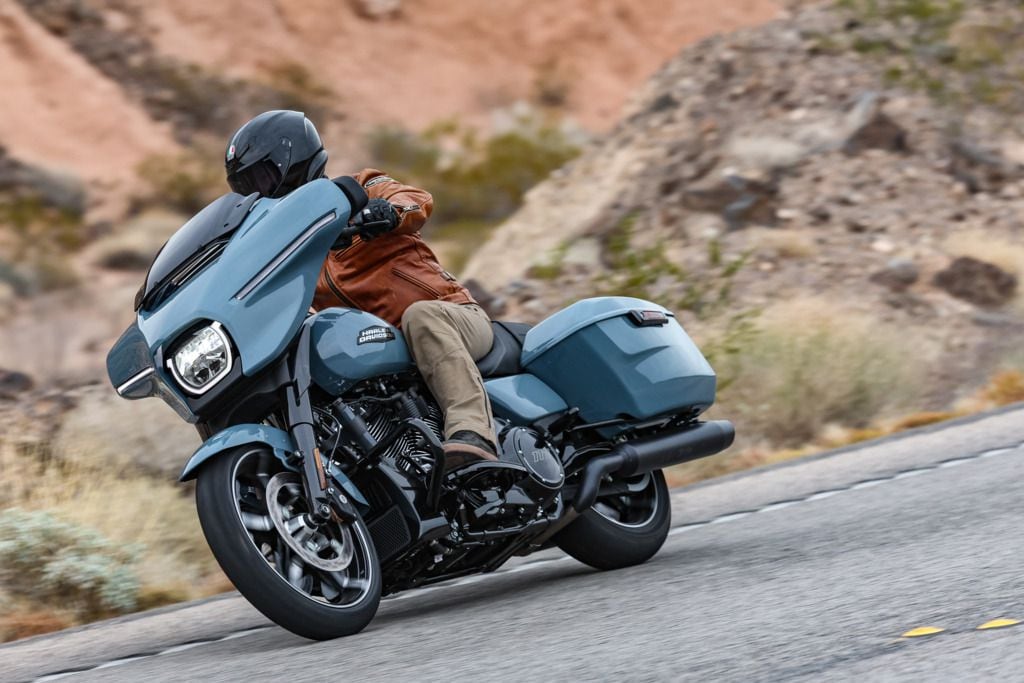
We logged some serious seat time on Harley-Davidson’s 2024 Street Glide. (Brian J. Nelson/)Change is inevitable, but sometimes controversial. Making a leap of faith beyond a tried-and true and popular model must require a lot of reflection, deciding if moving forward is the right decision. Surely there was a lot of debate inside Harley-Davidson when it came to updating the Road Glide and Street Glide: the poster children of what a Grand American Touring bagger should be. These two models have been icons for ages, and when the word “bagger” is used, these are the bikes that instantly jump to mind for most cruiser enthusiasts.
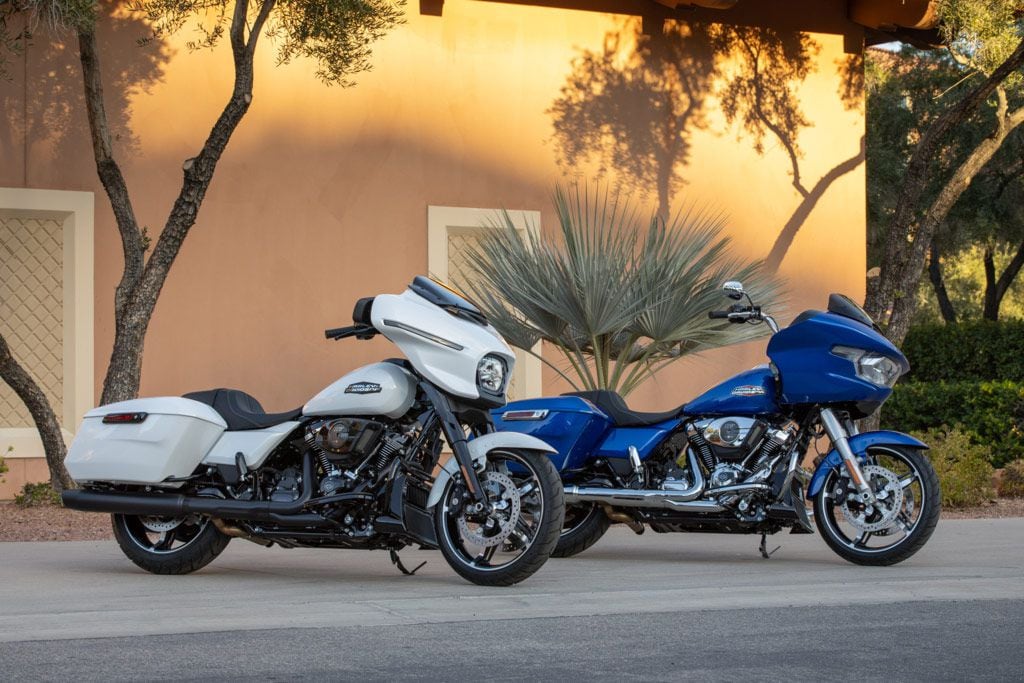
The 2024 Harley-Davidson Street Glide (left) and Road Glide (right) are mechanically very similar; the Street Glide has a fork-mounted fairing, while the Road Glide’s is frame mounted. (Kevin Wing/)The 2024 iterations of these models replace the outgoing Rushmore generation, and are the largest updates to either machine in a decade. The goals with the redesign were to update the styling, improve rider and passenger comfort, and take the infotainment to a completely new level—and, of course, add more power.
Styling and Lighting
Most of the changes, at least visually, are subtle unless you compare the models side by side with the outgoing ones, but that’s a good thing—we’d bet our kids’ college funds that most prospective buyers weren’t begging for a revolution. Harley-Davidson Vice President of Design and Creative Director Brad Richards described the process of tweaking the styling and making sure that all of the individual components come together to form a cohesive and complete picture as the “visual symphony.”
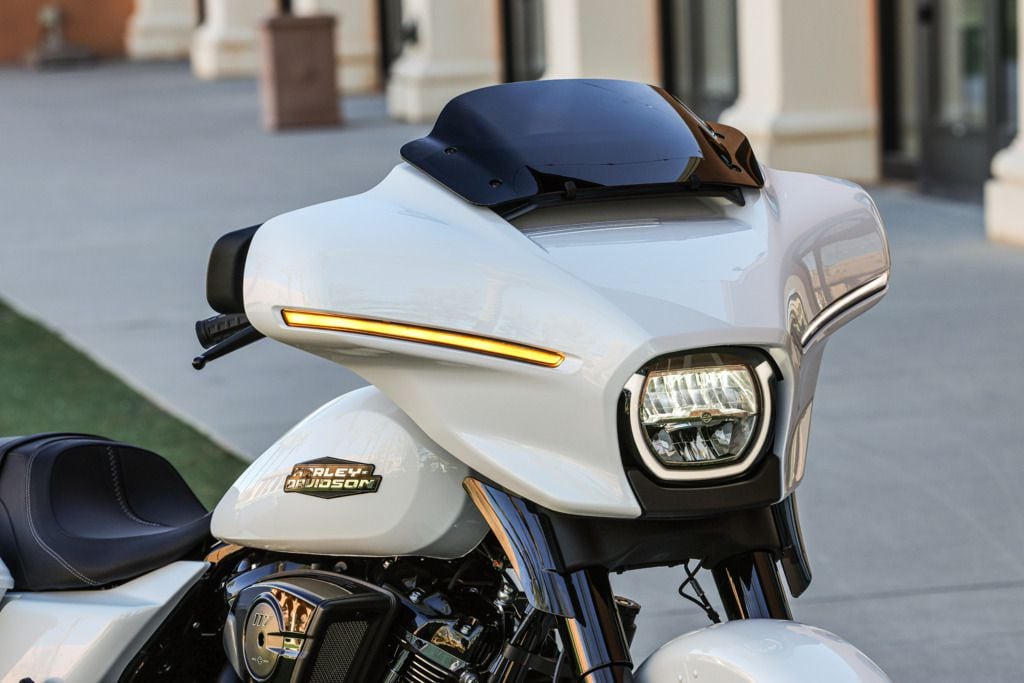
The updated Street Glide batwing fairing now has turn signals that are integrated into the running lights, and replace the bullet indicators. (Brian J. Nelson/)An obvious area that was touched for 2024 are each of these machines’ lighting. The Street Glide retains the classic batwing silhouette that has been around since 1969, but has slightly updated lines while modernizing, in particular, the headlight. The LED unit on the Street Glide is enclosed with an omega-shaped signature (running) light and integrated LED “eagle-wings” replace the bullet turn signals. On the Road Glide a large LED headlamp sits in the center, while a W-shaped LED running light incorporates the front turn signals.
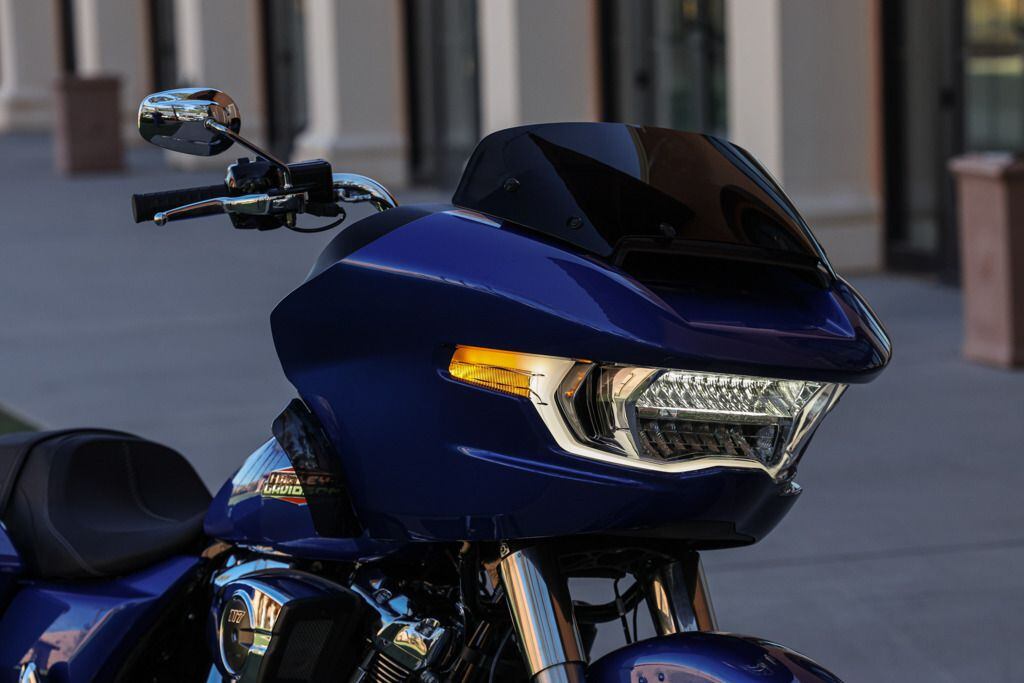
The fairing on the new Road Glide eliminates the bullet turn signals, and integrates them into the LED running lights. (Brian J. Nelson/)Tweaks to the teardrop shaped fuel tank (which no longer requires a key to open the fuel cap) includes a new bevel that carries on to the side covers and saddlebags and maintains a cohesive visual flow from front to back.
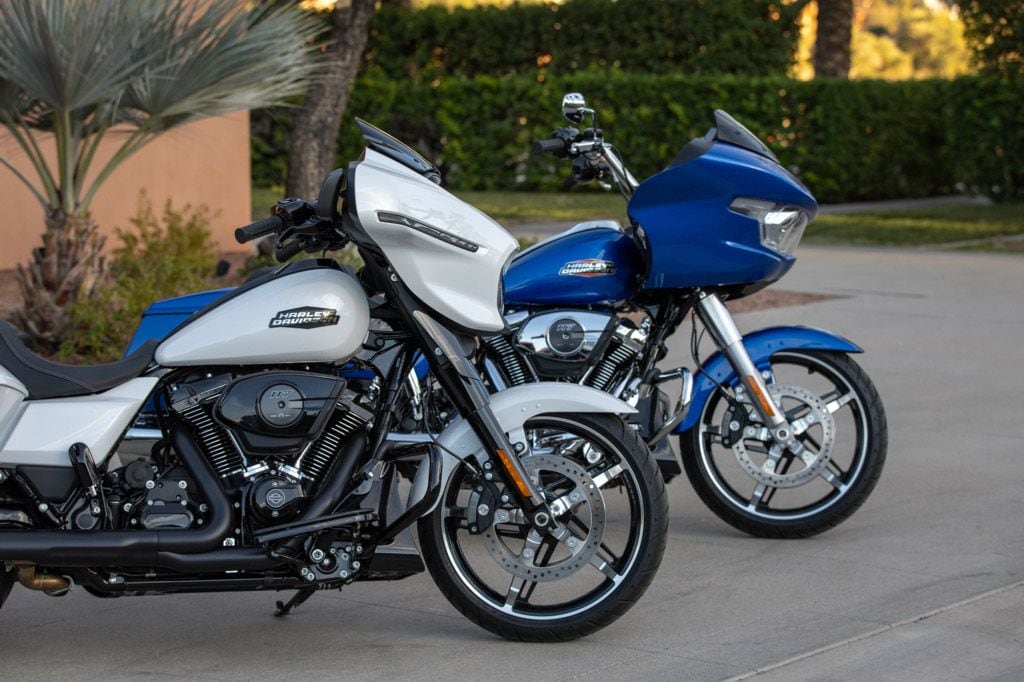
Styling changes have been made to the tank, side covers, and saddlebags. (Kevin Wing/)When it comes to colors and trim options there are a rainbow of choices. On each model there are six color options when combined with chrome trim, and if you choose the blacked-out trim (our preference), seven colors are available. The black trim adds $1,350 to the price on each, while the paint options can add up to an additional $850.
Milwaukee-Eight 117 Engine
Both models are updated with a new engine. And while the unit that is—for this year—exclusive to the 2024 Street Glide and Road Glide is called the Milwaukee-Eight 117, it is different from the 117ci unit that powers other models like the Breakout 117 and Low Rider S/ST. Modifications have been made to the intake and exhaust to improve power slightly, with a claimed 3 percent more horsepower and 4 percent more peak torque. Harley says output is now 105 hp at 4,600 rpm, and 130 lb.-ft. of torque at 3,250 rpm. Displacement remains an identical 117ci (1,923cc) with the same 103.5 x 114.3mm bore and stroke dimensions and a 10.3:1 compression ratio.
To address the goal of better controlling heat to rider and passenger, particularly during slow-speed riding, this version of the 117 gets the liquid-cooled cylinder heads that have trickled down from last year’s CVO Street Glide and CVO Road Glide models. A lower-front-frame mounted radiator circulates coolant to the exhaust valves with the path going first to the more enclosed rear cylinder’s head and then to the front cylinder’s. There is a fan mounted on the backside of the radiator that is angled to force the air down below the motorcycle, to further isolate the cockpit from excess heat.
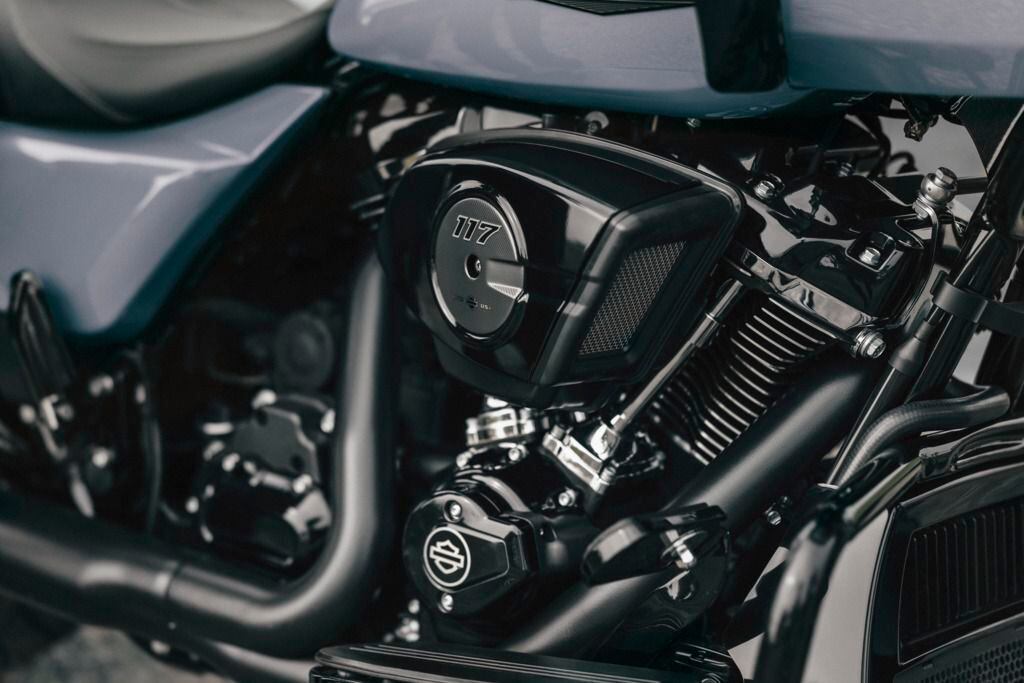
The 117’s airbox has 50 percent more volume than the one it replaces in part to compensate for the engine displacement increase but also to boost power while meeting sound emissions. (Harley-Davidson/)Changes to the airbox include 50 percent more volume (4.0 liters), compared to the 107/114 engines. Downstream from there, the intake tract has been completely redesigned with a new aluminum intake manifold that offers a smoother and more direct path into the larger 58mm throttle body (up from 55mm). Changes to the cylinder head include reshaped combustion chambers, oval intake ports with low-profile intake-valve seats for increased velocity, while a bump in compression from 10.2 to 10.3:1 enhances low-rpm torque and improves fuel economy.
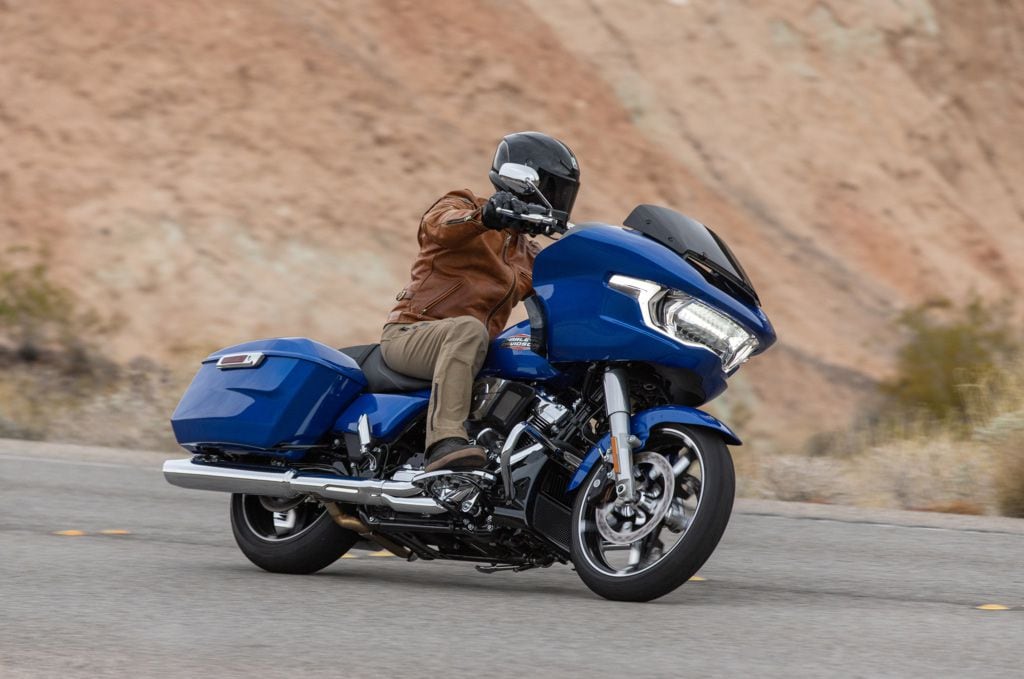
The 2024 Harley-Davidson Road Glide in Blue Burst paint with chrome trim. (Kevin Wing/)So how do all of these engine changes stack up? For starters, let’s remind you that the outgoing standard Street Glide and Road Glide were powered by the 107ci version of the Milwaukee-Eight. The version of the 117 in these new models offers 22 percent more horsepower and 19 percent more peak torque from that additional 9 percent of displacement compared to the 107. Another factor that plays into this duo’s increased performance is that both models have shed a not-insignificant amount of weight, with the Street Glide tipping the scales 18 pounds lighter and the Road Glide 16 less than the models they replace.
Unfortunately our street rides on the Street Glide and Road Glide were cut short by the atmospheric river weather system that had just pounded Southern California, and then found its way toward us in Las Vegas. But our backup plan was good: We’d brave the elements the following day and ride the Street Glide the 335 miles back to the Cycle World office in Irvine, California, and get some solid seat time.
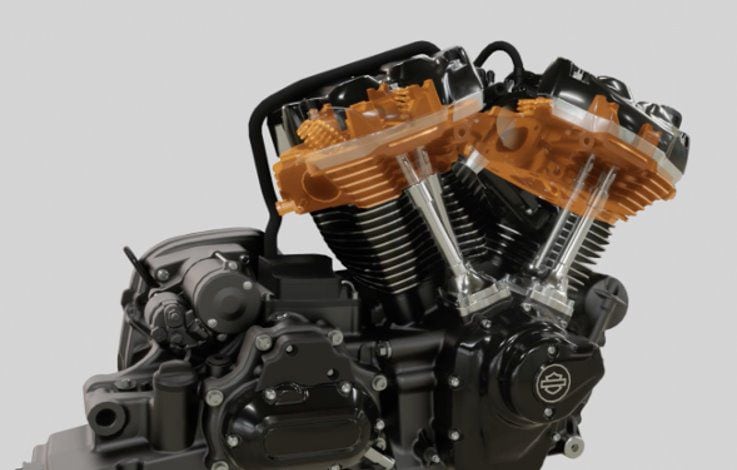
Milwaukee-Eight 117 cylinder-head changes improve intake flow. (Harley-Davidson/)Leaving Las Vegas on a cold and damp February morning, we settled into our groove and hit the less direct route down the 95 through Searchlight and to Interstate 40. It’s much less traveled than Interstate 15, and also has some fun twists, turns, and dips thrown in after miles of the straight and boring. The counterbalanced Milwaukee-Eight is a soulful partner, providing enough character to remind you that it’s a giant 45-degree V-twin, while also being smooth at cruise, allowing you to relax over long-distance rides.
Power off the bottom provides easy launches when leaving stoplights around town, and provides the acceleration to leap out ahead of traffic, especially when utilizing the Sport mode (that we’ll get into more detail on later). If you select Rain mode, the engine is much more docile, so don’t expect the bike to jump off the line with the same enthusiasm. Out on the highway, and interacting with trucks and traffic, a quick downshift to fifth (when in the right mode) wakes the engine up and easily allows quick and confident passes. In the twisty bits, the 117′s midrange torque is strong and chugs out of corners nicely, no need to drop down too many gears, as the engine has a broad sweet spot for sportier riding.
The six-speed transmission shifts with a solid and firm feel at the foot lever. Performance from the slipper/assist clutch is consistent and predictable around town and when making U-turns, which is a must for confidence when maneuvering at slow speeds on an 800-pound bagger.
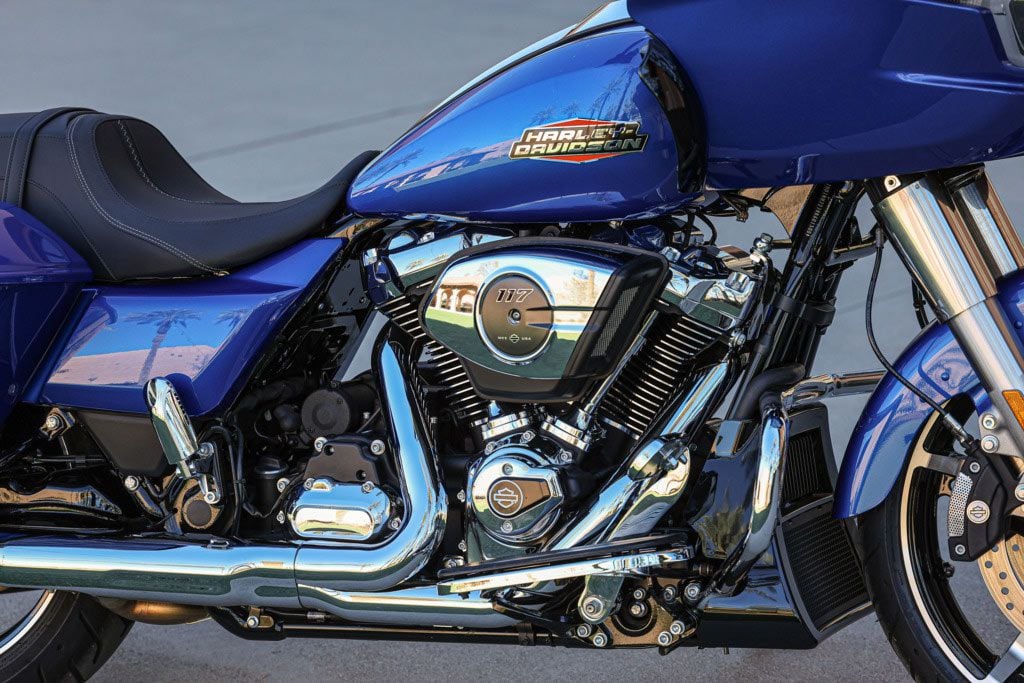
The 2024 Harley-Davidson Road Glide engine with chrome trim. (Brian J. Nelson/)Seat time was cut severely short on the Road Glide, but we did spend at least enough time to confirm that there is nothing between the two models when it comes to engine performance. The two bikes share identical powerplants, with identical transmission ratios, and weigh within 25 pounds of each other (the Road Glide the heavier of the two). So from the seat of the pants, there isn’t really any difference in terms of outright performance.
Electronic Rider Aids
Both models get big updates in terms of electronics, including selectable ride modes thanks to ride-by-wire throttle control. Both machines have four modes that can be changed on the fly from the right-bar-mounted control pod. Road mode is mapped to be the everyday go-to option with mellower throttle response, less midrange power and a high level of traction control and ABS intervention. Sport is much more aggressive with full power unleashed, the most direct throttle response, TC set to lowest level and engine-braking dialed up. Rain offers the mellowest throttle response and reduced power output, while engine-braking is limited and TC and ABS are at their most conservative settings. Of course we all like to tinker, so the Custom mode allows the rider to set up a mode to their preferences for all of those parameters.
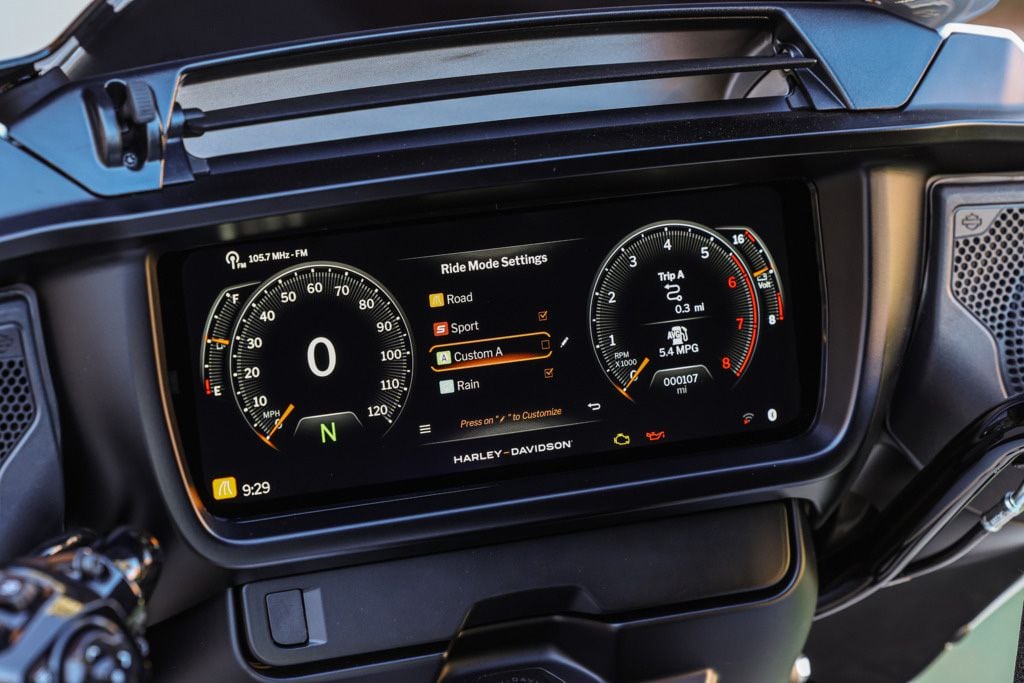
The Street Glide and Road Glide come with four available modes. (Brian J. Nelson/)Other electronic features include the Cornering Electronically Linked Brakes (C-ELB) which feeds in rear brake if you’re only using the front lever, and adds front braking if you just stomp on the rear. The C-ABS, CTCS (traction control), and Cornering Drag Torque Slip Control (engine-braking control) are all tied to a six-axis IMU to allow the bike to manage intervention when leaned over through corners. Two other features in the rider safety suite include Tire Pressure Monitoring and Vehicle Hold Control.
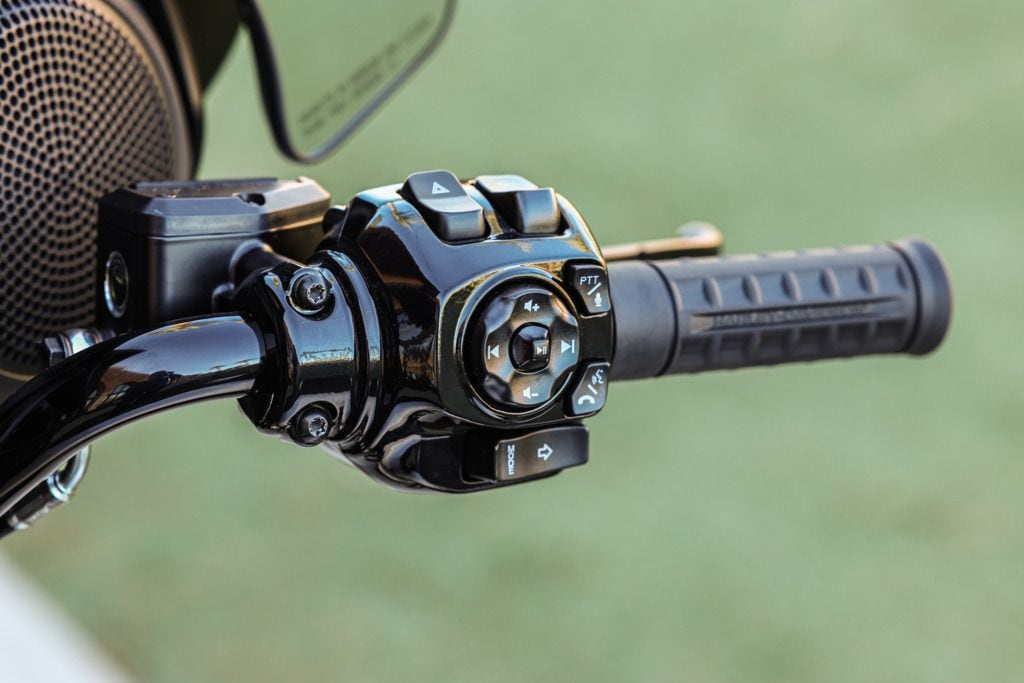
The modes can be accessed via the mode button on the right handlebar. (Brian J. Nelson/)Picking the right mode for the occasion is key to getting what you expect out of the engine’s performance—the easy-to-access button on the right handlebar allows quick changes so that you’re always in the right mode. Advantages to the modes include the ability to have crisp performance when riding through the twisty bits, but then be able to calm down the delivery when you just want to relax, or when you have a passenger on the back who doesn’t want their helmet banging into the back of yours everytime you grab a shift.
Street Glide and Road Glide Chassis
Chassis updates address midcorner performance but also long-distance comfort. We already mentioned that both models have lost a considerable amount of weight over their predecessors. That will pay dividends in all aspects of performance from acceleration and braking to handling. The Street Glide weighs a claimed 811 pounds and the Road Glide 838, ready to ride.
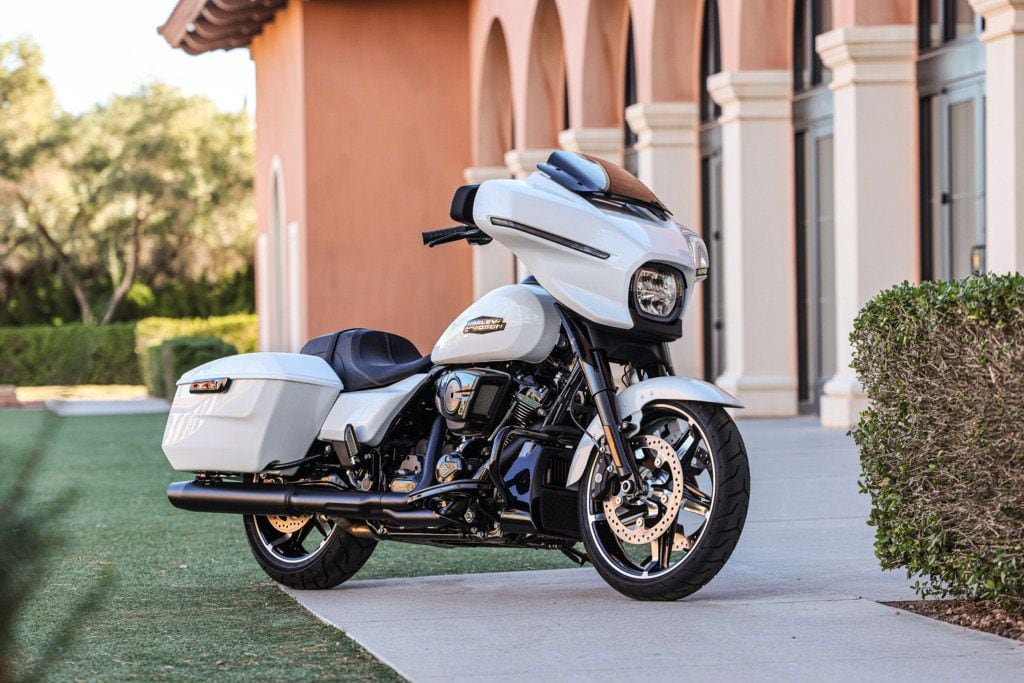
The 2024 H-D Street Glide and Road Glide get updated chassis components. (Brian J. Nelson/)The biggest change is to the new rear suspension, which gets a 50 percent travel increase from 2.1 to 3.0 inches of rear-wheel stroke. The preload-adjustable shocks are Showa emulsion-technology units, while the conventional 49mm Dual Bending Valve fork (CVO models have an inverted unit) has been retuned to work in unison with the rear suspension and also recalibrated to the bike’s reduced weight.
Having knocked out 335 miles in five and a half hours on the Street Glide, we’ll make the argument that there are very few other bikes out there that we’d rather have been on for this journey. Especially considering that we were plowing straight into nasty head- and crosswinds for a big chunk of the ride. The suspension provides a comfortable ride that easily eats up road imperfections, isn’t flustered by nasty pavement through construction zones, and is firm and controlled when a set of fast sweepers arrives and you hammer the throttle. We loaded the side cases, which have 2.42 cubic feet of total capacity (or 69 liters), to the rim with clothes and gear, and the Street Glide’s performance didn’t waiver. If we’d had a passenger, we would have dialed in some preload, but loaded up and solo the chassis performed great.
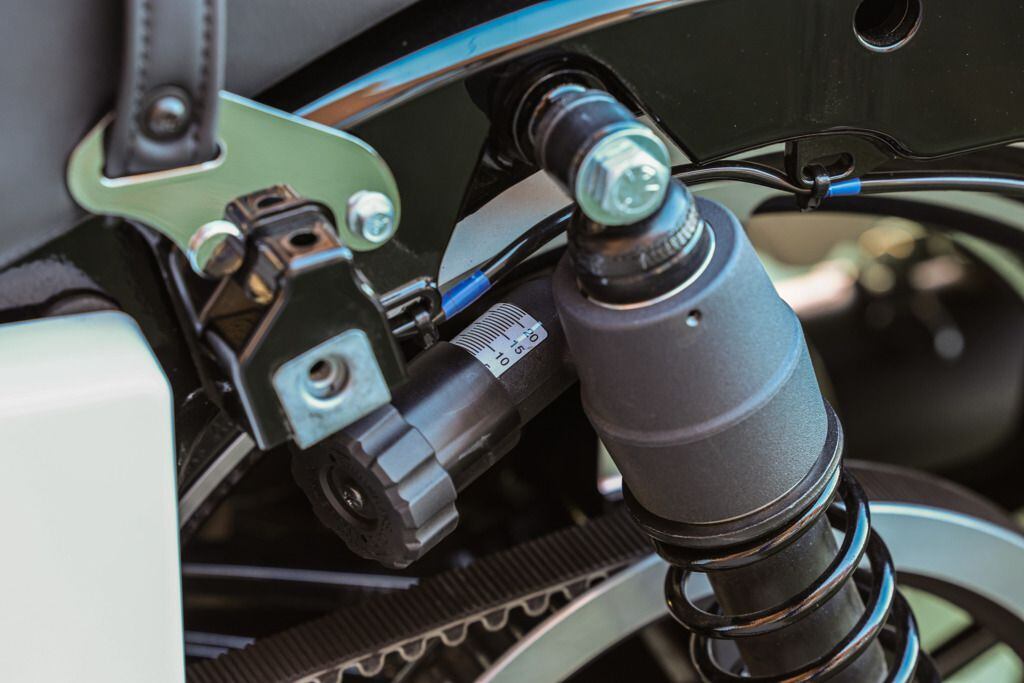
The Showa shocks on each machine have provisions for preload adjustability. Just remove the saddlebag to access the shocks. (Brian J. Nelson/)The Street Glide and Road Glide both provide nice handling and turn-in response, which is particularly impressive considering their weight, while reduced, is still up there. Midcorner stability is very good. As ever, cornering clearance is the speed-limiting factor, and H-D’s touring models actually provide quite a bit of lean for the class. At slow speeds around a parking lot, both bikes feel a bit heavy, but once rolling above 10 mph, the weight disappears and the bikes handle predictably.
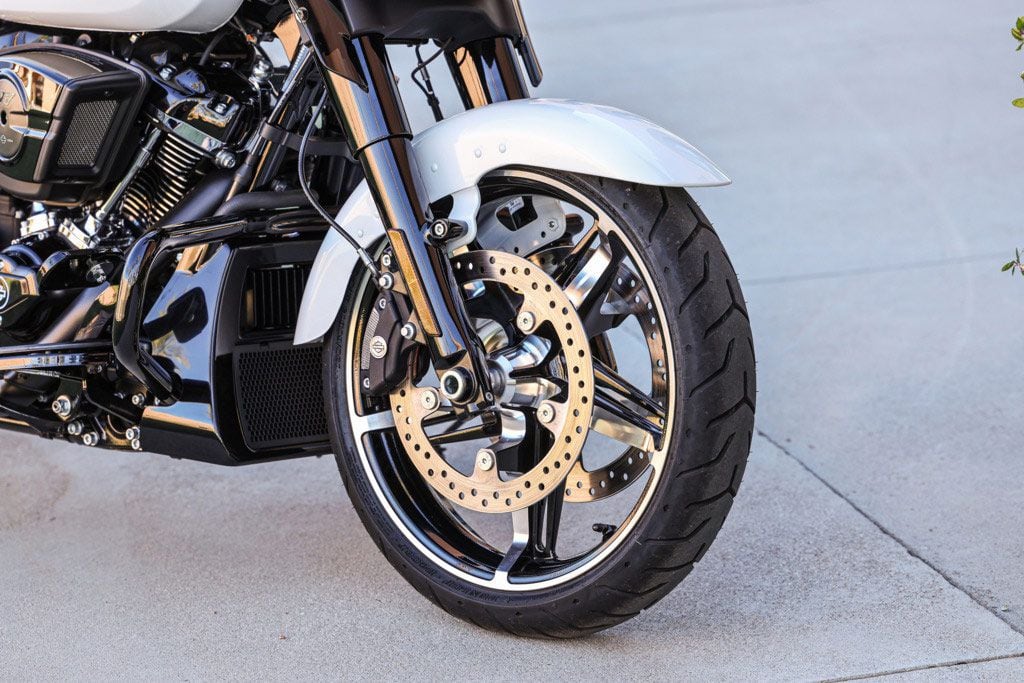
Each machine is fitted with a pair of four-piston calipers and 320mm discs up front and a 49mm fork that doesn’t have provisions for adjustability. (Brian J. Nelson/)A pair of four-piston brake calipers and large 320mm rotors up front work with a single-piston rear caliper mated to a 300mm disc. Power from the brakes is good, with progressive bite from the front units providing confident stops. Linked brakes add safety: The system manages front-to-rear bias and ABS as needed.
Street Glide and Road Glide Ergonomics
More than the fairing shape or any other differences, the separating factor between these two machines is the stock handlebars. For me, the much lower standard bar on the Street Glide was ultimately why I chose that model for our ride from Vegas to Irvine. The Road Glide’s much taller bar is just a bit too high for my preference, but other (taller) staffers who have tried the Road Glide like that one. The Street Glide offers a more traditional neutral height and therefore the riding position puts your upper body at a slight forward lean that I found really comfortable for long rides. The accessory catalog and aftermarket have a near infinite selection of alternate handlebars.
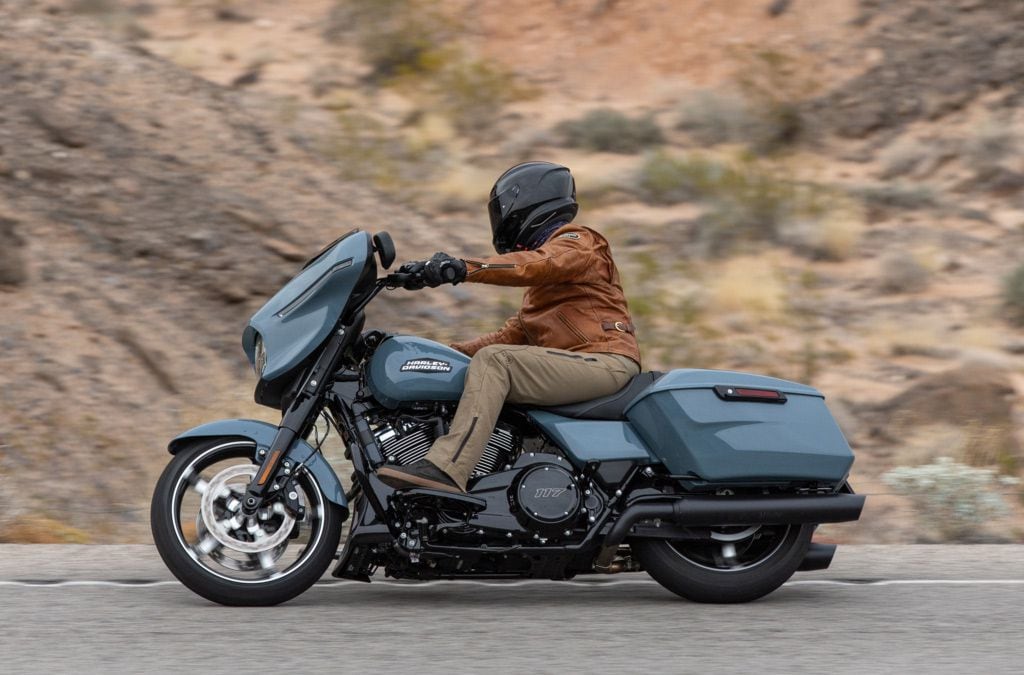
The Street Glide’s riding position is more neutral with a mellow bend at the knee, comfortable arm bend and slight forward lean from the torso. (Kevin Wing/)Improvements have been made to each machine’s aerodynamics for 2024. Harley claims a 60 percent reduction in helmet buffeting. Obviously this also depends on the rider’s height. In our case, for this 5-foot-11-inch tester (with a full-face AGV helmet), in most circumstances the buffeting was minimal. The new control vane in the center of the fairing above the infotainment screen drastically changes how the air interacts with you in the cockpit. We found that when it is raining and cold, shutting the vent is a must, but also increases the turbulence a bit. Once the rain stops, cracking it open smooths the airflow noticeably, and will be much preferred on hot days.
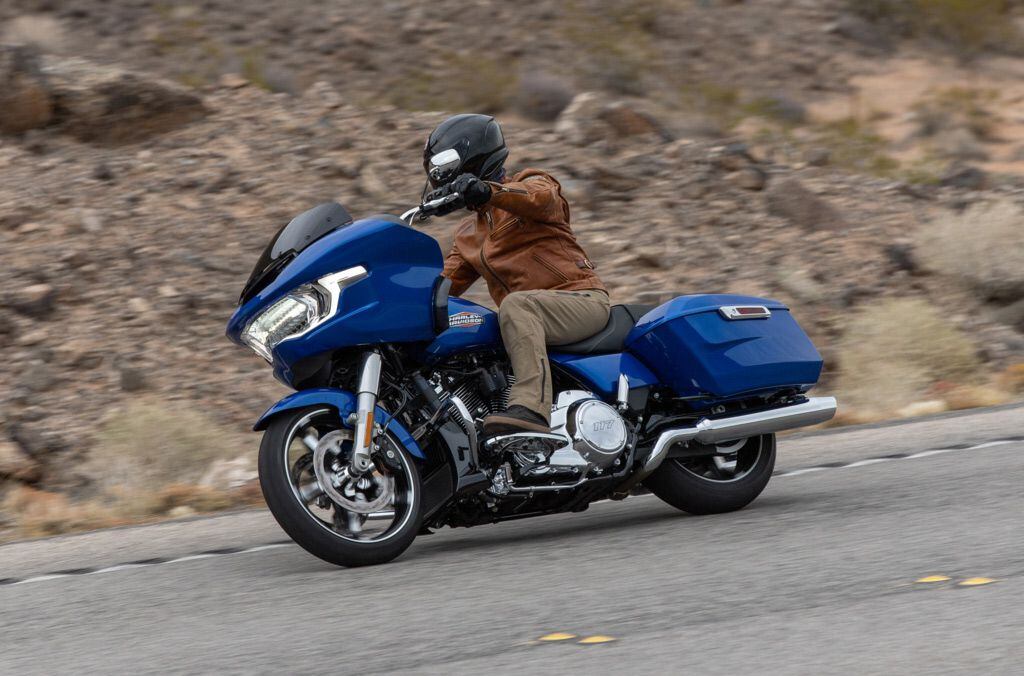
The Road Glide’s handlebar changes the seating position a bit with a similar leg bend, but places your arms much higher with the tall bars. (Kevin Wing/)The seat heights on these two machines are slightly different, with the Street Glide’s claimed laden (rider in place) seat height at 26.1 inches, and the Road Glide’s at 25.9. Harley has reshaped the seat to rotate the rider’s hips to a more neutral position to take pressure off the spine. After spending five and a half hours in the saddle with just a single fuel stop thrown into the middle of the ride, we can confirm that the seat is amazingly comfortable. Not only does it provide the back support that Harley aimed for, but the cushioning is soft enough for those long stints when you’re burning through that 6-gallon tank of fuel.
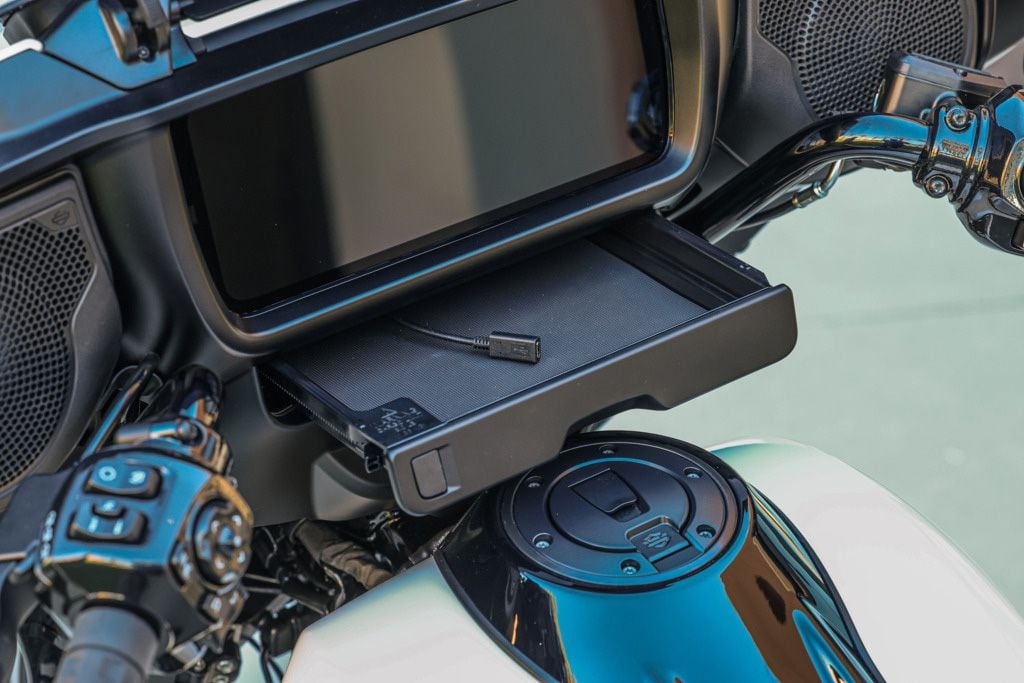
We love the Street Glide’s USB-C-equipped pop-out smartphone compartment. (Brian J. Nelson/)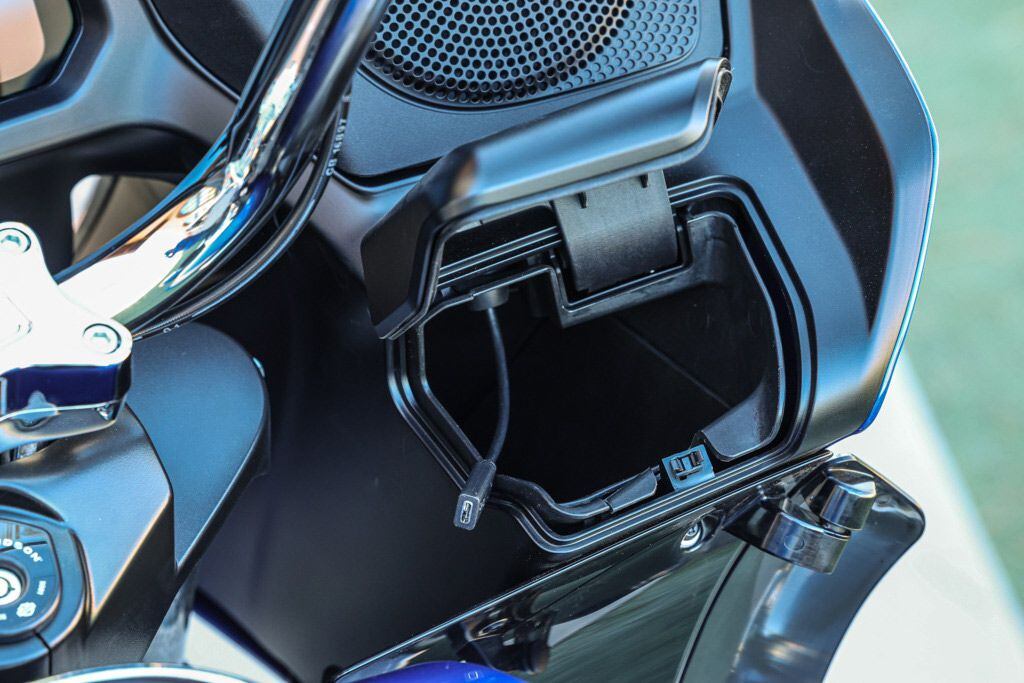
The cubbies on the Road Glide aren't quite as slick and don't allow easy access while in motion, but should you really be messing with your phone while riding? (Brian J. Nelson/)Harley-Davidson Skyline OS Infotainment
The brand-new Skyline OS infotainment system with a big, beautiful 12.3-inch full-color TFT display is similar to what was used on 2023 CVO Road Glides and Street Glides (similar because those were managed by the Boom! Box 4.3 software, whereas the 2024 models get the all-new Skyline OS). It’s a huge upgrade compared to the analog tach/speedo and 6.5-inch screen used on the old standard Road Glide/Street Glide models. The screen itself is feature packed, with an anti-glare coating, touchscreen or bar-mounted menu navigation, three different display modes including Cruise, Sport, or Tour, and then a super-bright high-contrast mode with white background and black details.
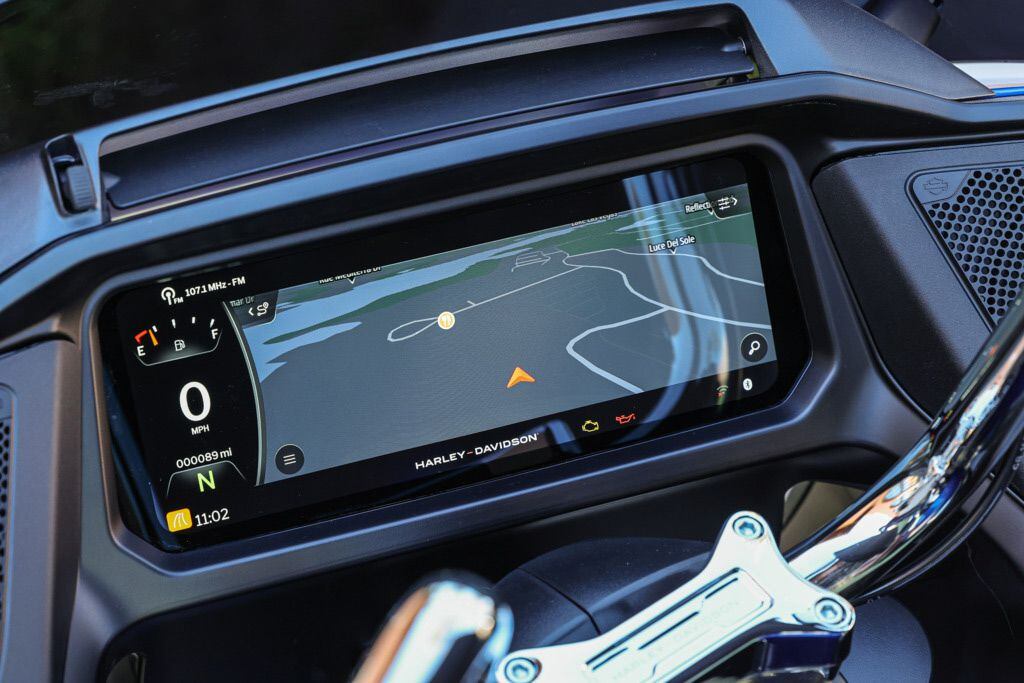
Of the three view options, Tour provides the best navigation experience. (Brian J. Nelson/)The available space afforded on this screen has been utilized to the maximum. There is no question that visually it is one of the most impressive info screens in motorcycling. The different view options provide excellent functionality too. For instance, our Street Glide had the optional $349.95 navigation installed, and when you toggle over to the Tour view, the navigation map dominates more than three-quarters of the screen’s real estate, leaving a numeric speed indicator, gear-position indicator, fuel level, and a few other tidbits of information on the left. Of course if you aren’t navigating, then the Cruise view (most info) or Sport (tachometer in the middle) are also options.
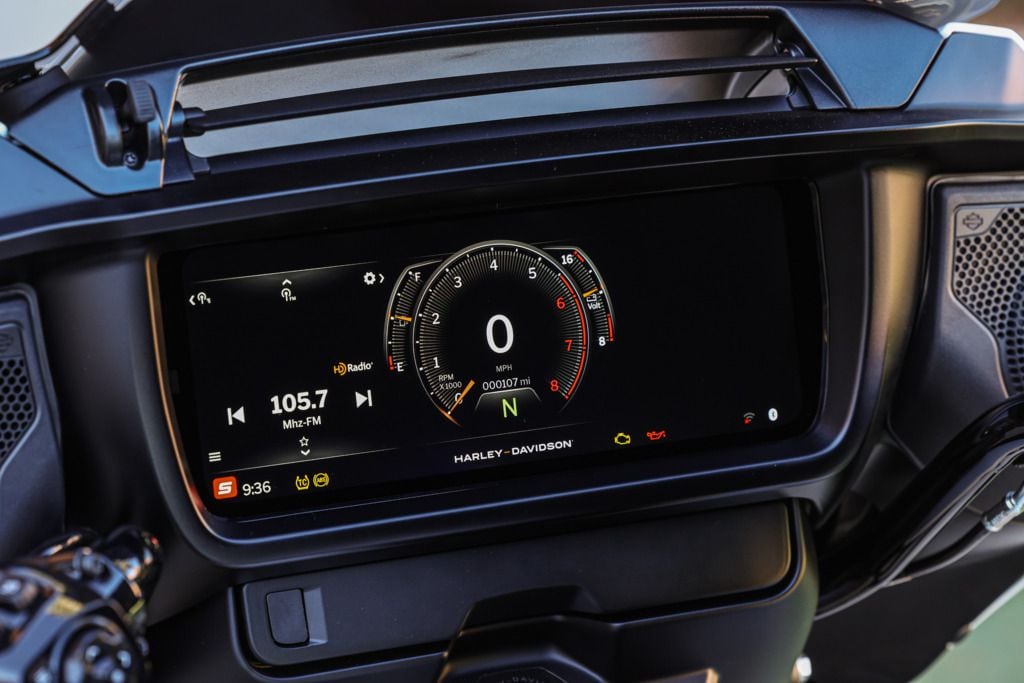
The Sport view has its tach in the center where it is super easy to glance at while riding more aggressively. (Brian J. Nelson/)If you want to forgo Harley’s nav and use a third-party app, you can utilize Apple CarPlay (but not Android Auto), but with one caveat: You also have to pair a helmet communicator because Apple requires voice control/helmet audio for the system to work. In terms of connectivity, the system supports Wi-Fi and Bluetooth or the USB-C connection for music and calls for both Apple and Android devices.
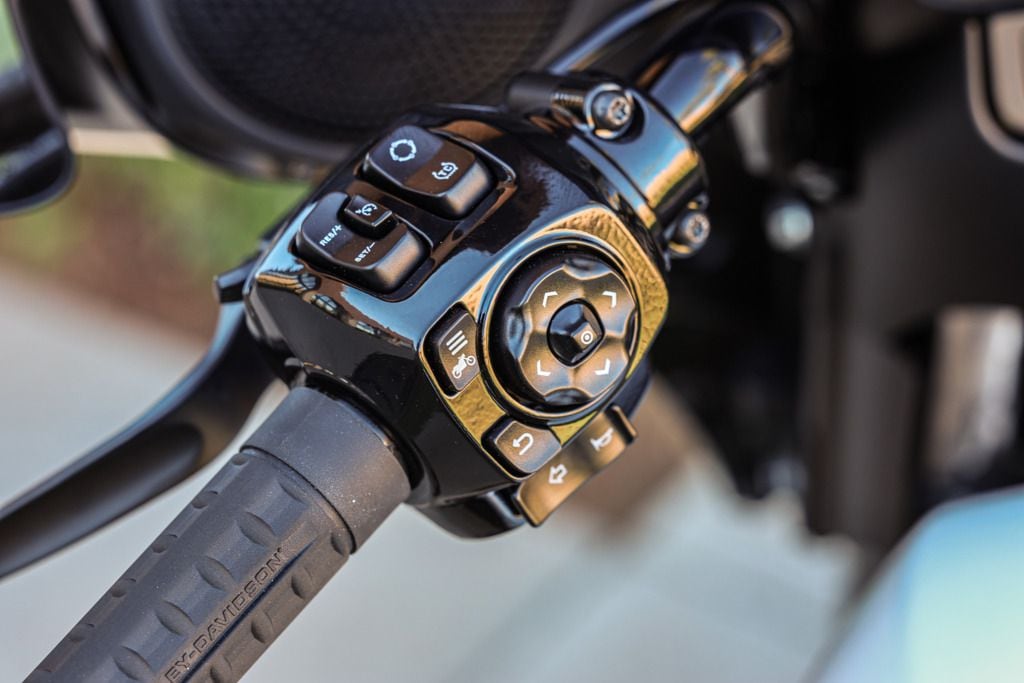
Use the left-bar-mounted control pod or touchscreen to navigate the infotainment system. (Brian J. Nelson/)Our experience with the system was almost completely positive with just a few quirks. Navigating the menus either via the left and right buttons is logical with well-laid-out menus to find everything from bike settings, tripmeters, modes, and audio control. Better yet is the ability to do most of this with gloved hands on the touchscreen. Most of the bike’s options can be accessed in motion, with just a few requiring the bike being stationary. Out on the open highway with the cruise control set, you can poke around and change your music playlist, or easily make other changes with very little distraction from the road.
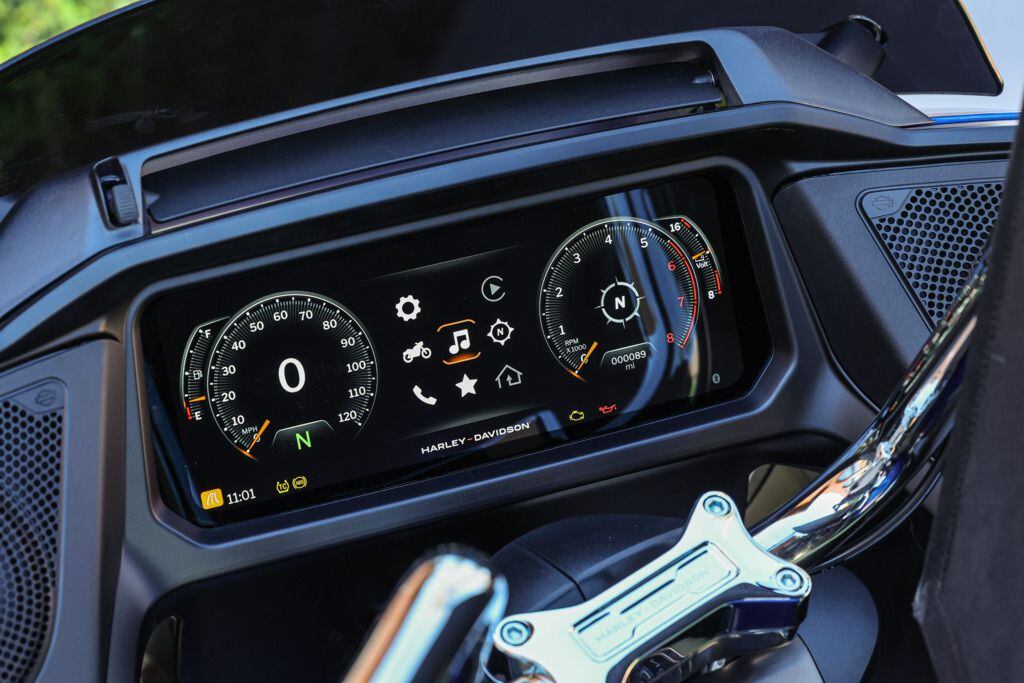
The menu in the center can be pulled up on the fly and navigated either from the pad on the left bar, or via the touchscreen. (Brian J. Nelson/)The audio systems on each model have been upgraded with a new four-channel 200-watt amplifier and 5.25-inch Rockford Fosgate speakers.
Conclusion
As has been the case for decades, if you don’t want to spend the big bucks on a CVO model, patience usually pays off as features and engines that debut on those exclusive models tend to trickle down in subsequent model years. Such is the case on these Grand American Touring models. Just a few years ago, the only way you could get a 117ci engine was in the CVO models that were introduced for the 2018 model year. And as we saw with the 2023 CVO Road Glide and CVO Street Glide, not only did a large TFT screen get passed down to these models, but the 2024 standard models get a vastly upgraded operating system to power the entire infotainment system.
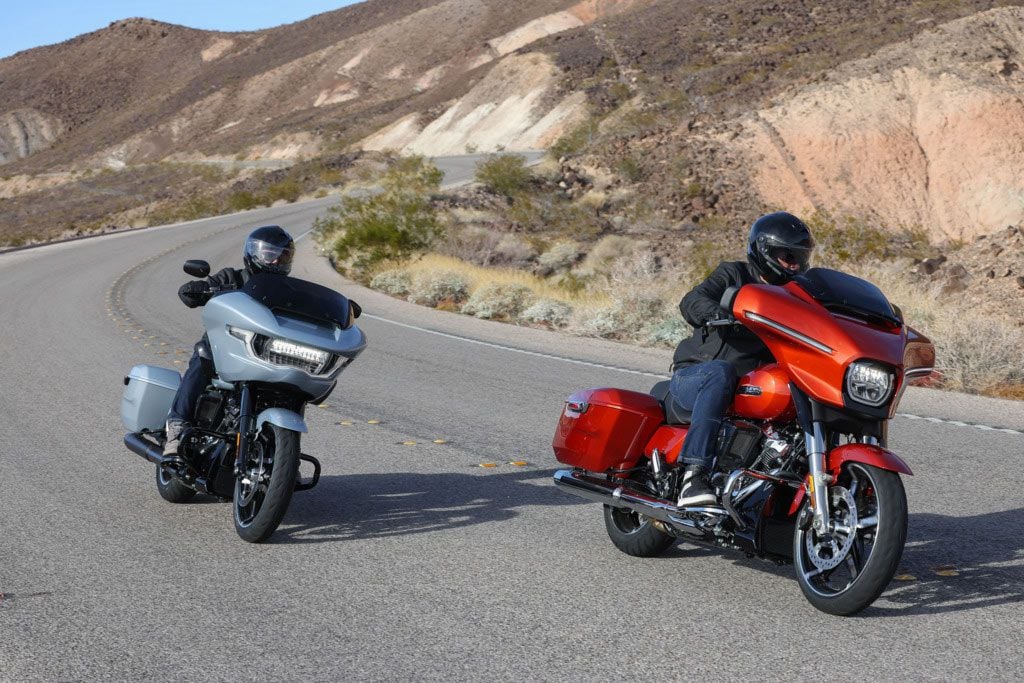
The 2024 Harley-Davidson Road Glide and Street Glide cost the same and have the same engine and features, so it really comes down to styling and the riding position. (Brian J. Nelson/)The new base Street Glide and Road Glide offer features and performance that were previously only available on CVO models at increased prices in 2024: both models start at $25,999 compared to $21,999 on the 2023s, a rise that beats inflation. But the updates and increased engine performance offer what the Harley-Davidson customer has traditionally looked for. To answer the original question, if dramatically updating these iconic models was a good decision on Harley-Davidson’s part, our opinion is, yes, they are better in every way.
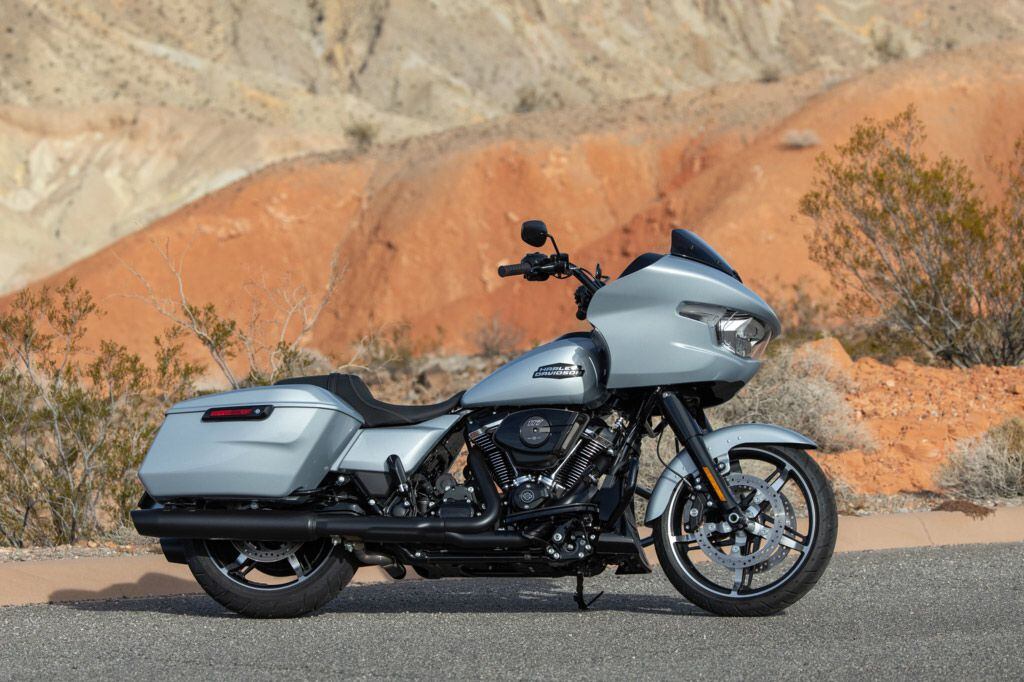
2024 Harley-Davidson Road Glide in Atlas Silver Metallic. (Kevin Wing/)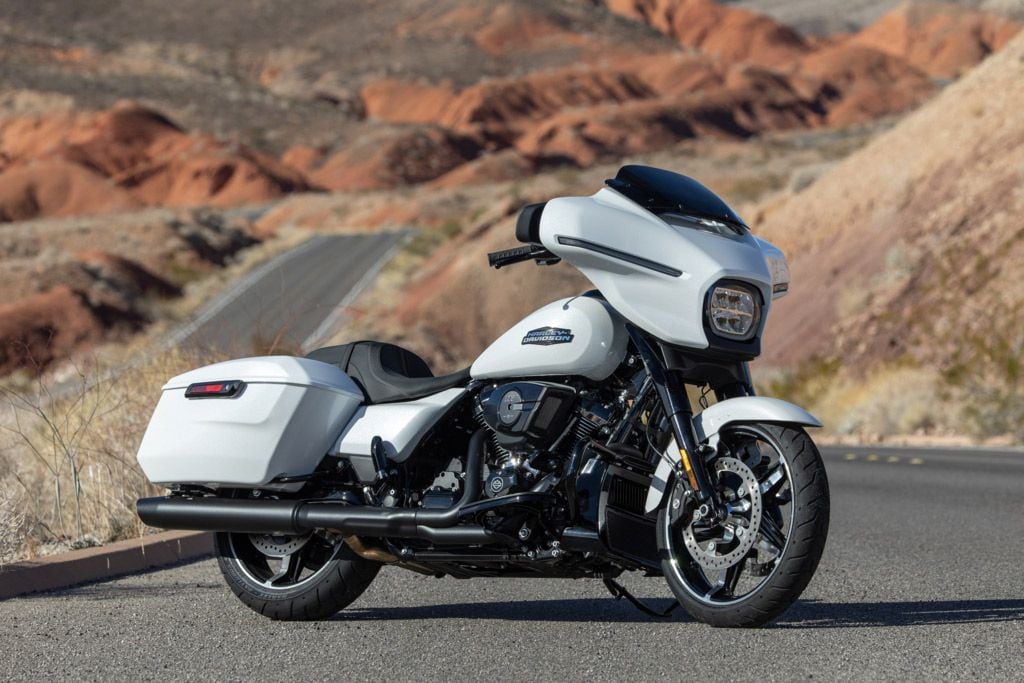
2024 Harley-Davidson Street Glide in White Onyx Pearl. (Kevin Wing/)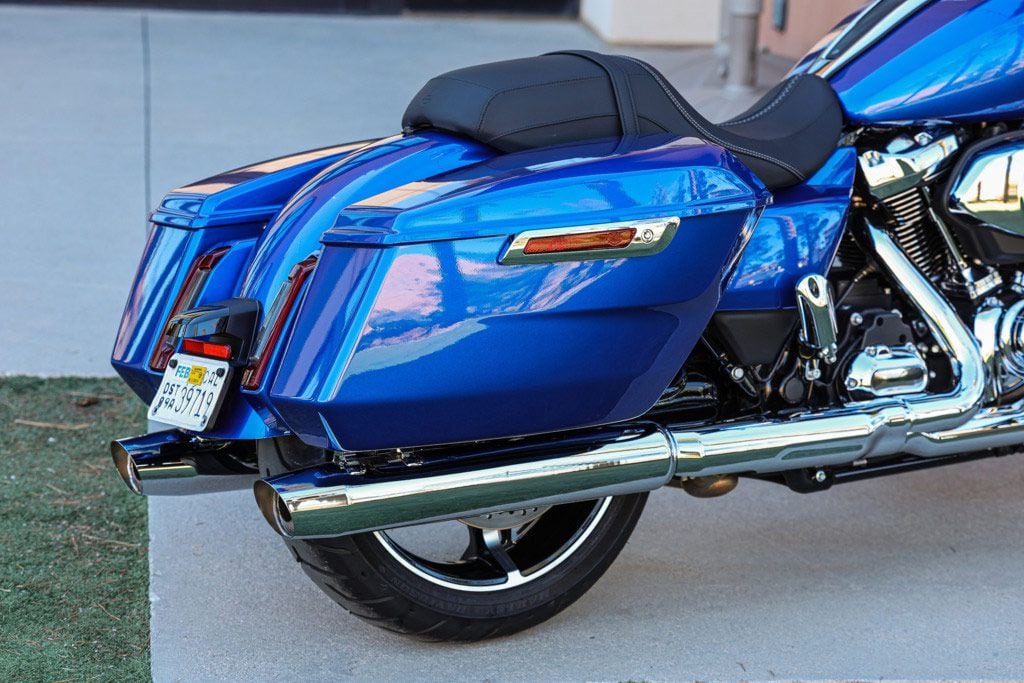
The saddlebags on each machine have been updated for 2024. (Brian J. Nelson/)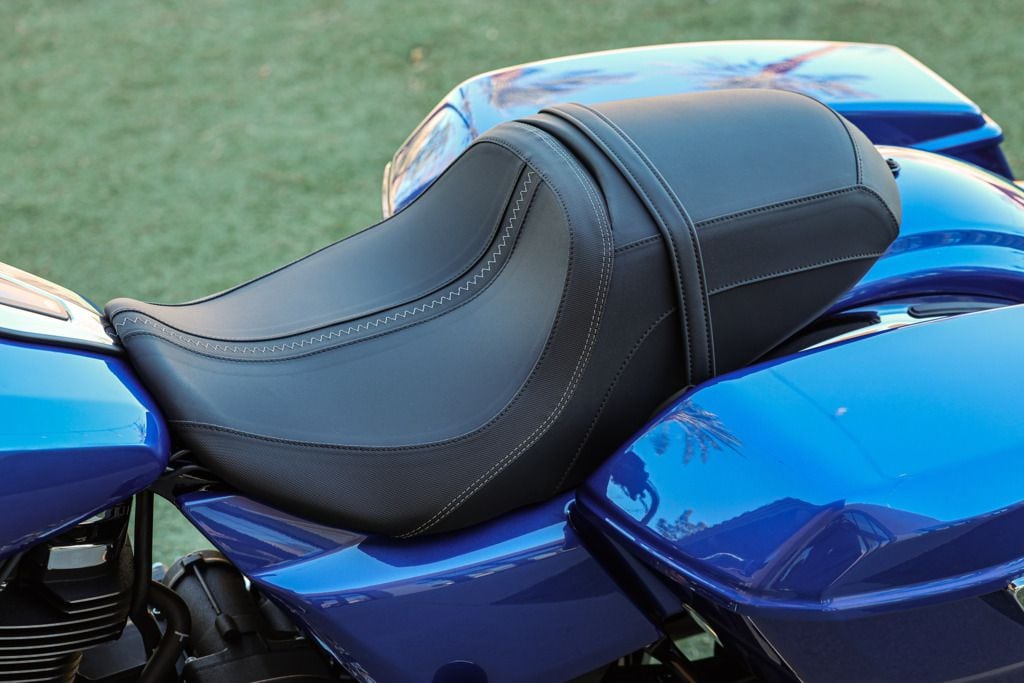
The seats on both machines have been modified for better long-term comfort. (Brian J. Nelson/)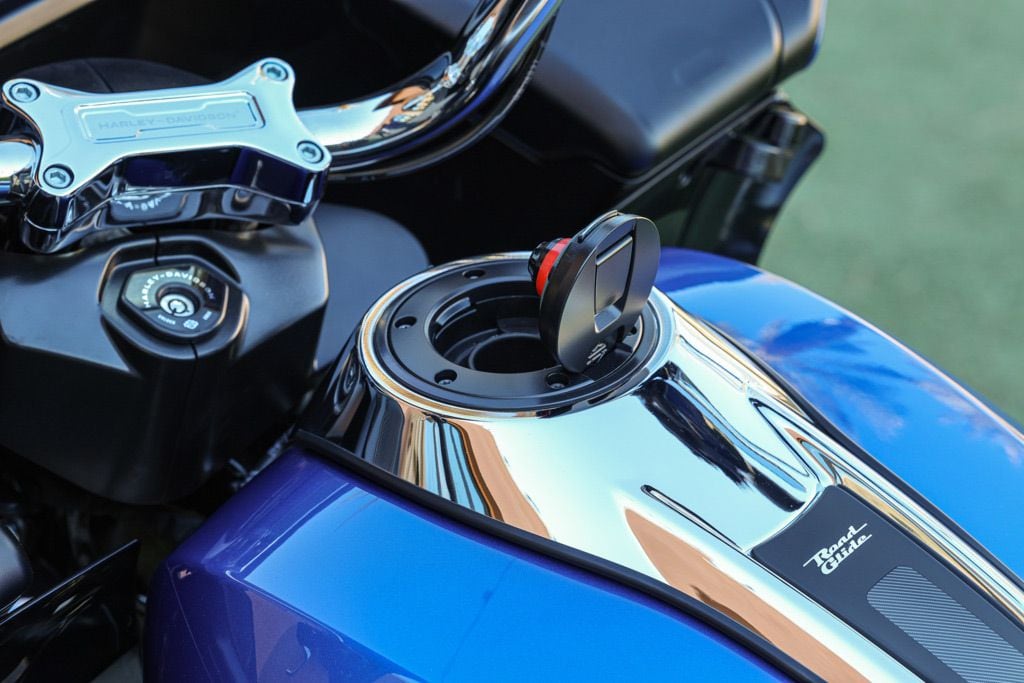
The fuel cap is now electronic and no longer requires a physical key to open. (Brian J. Nelson/)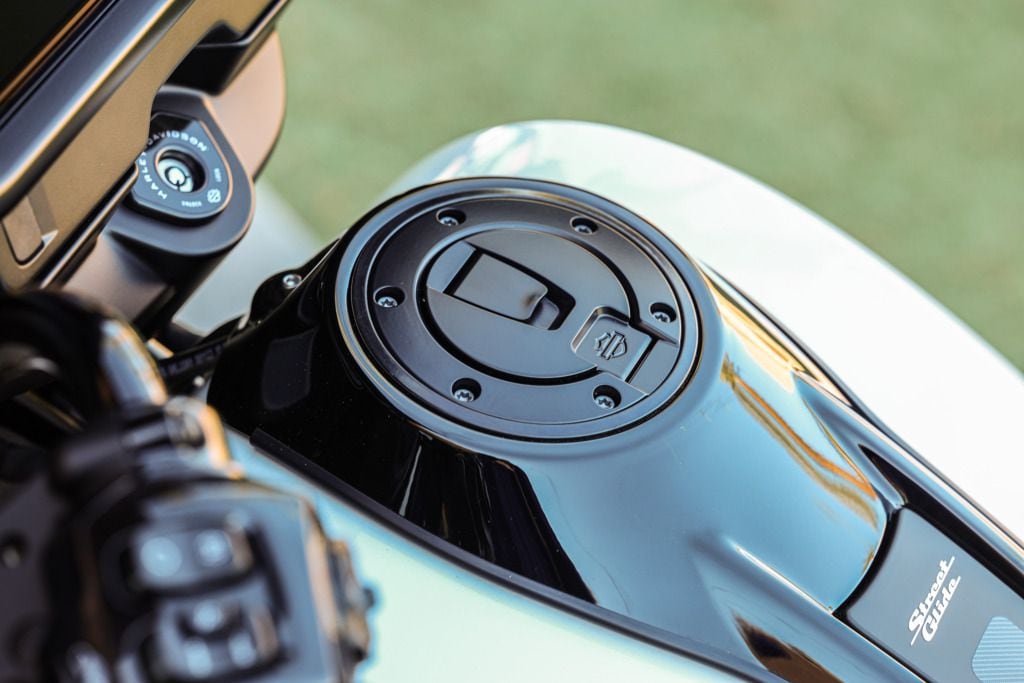
Another view of the new fuel cap. (Brian J. Nelson/)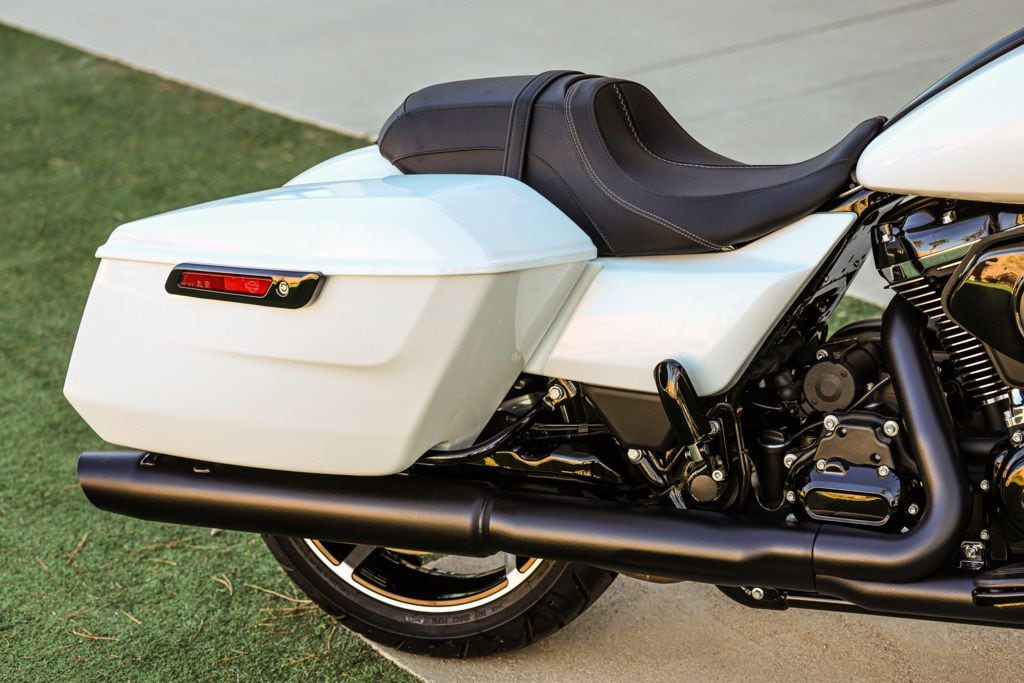
2024 Harley-Davidson Street Glide saddlebags. (Brian J. Nelson/)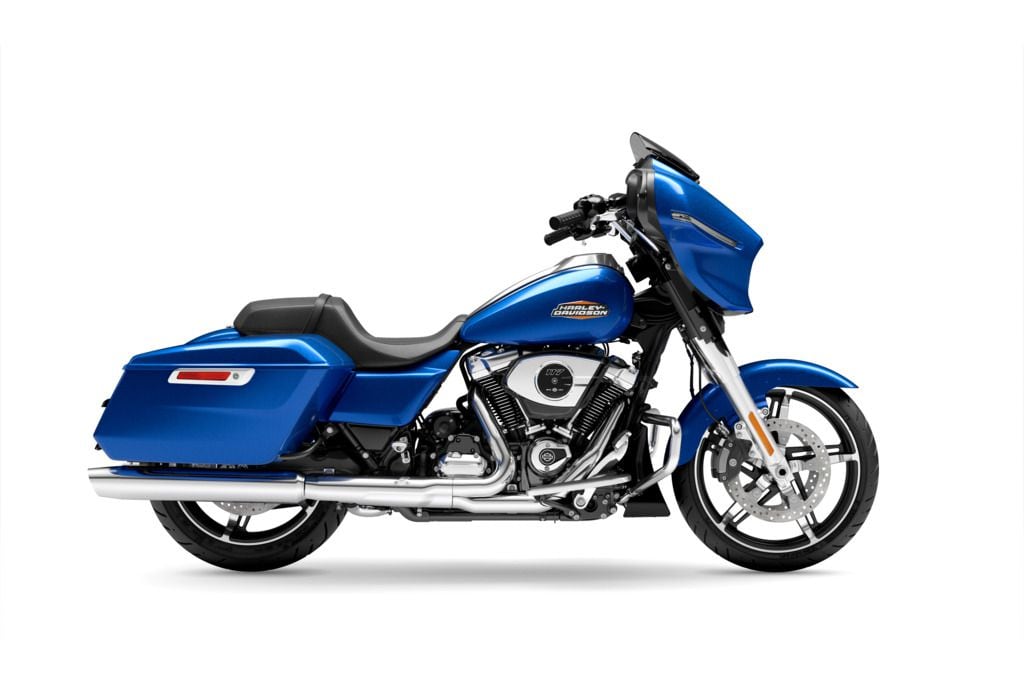
2024 Harley-Davidson Street Glide in Blue Burst with chrome trim. (Harley-Davidson/)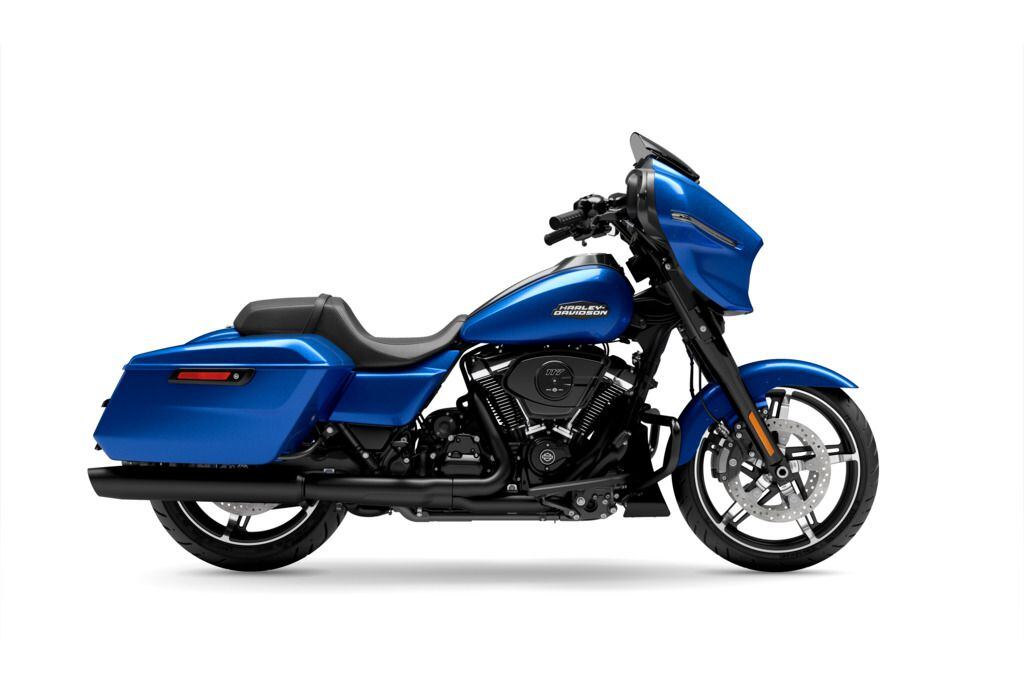
2024 Harley-Davidson Street Glide in Blue Burst with blacked-out trim. (Harley-Davidson/)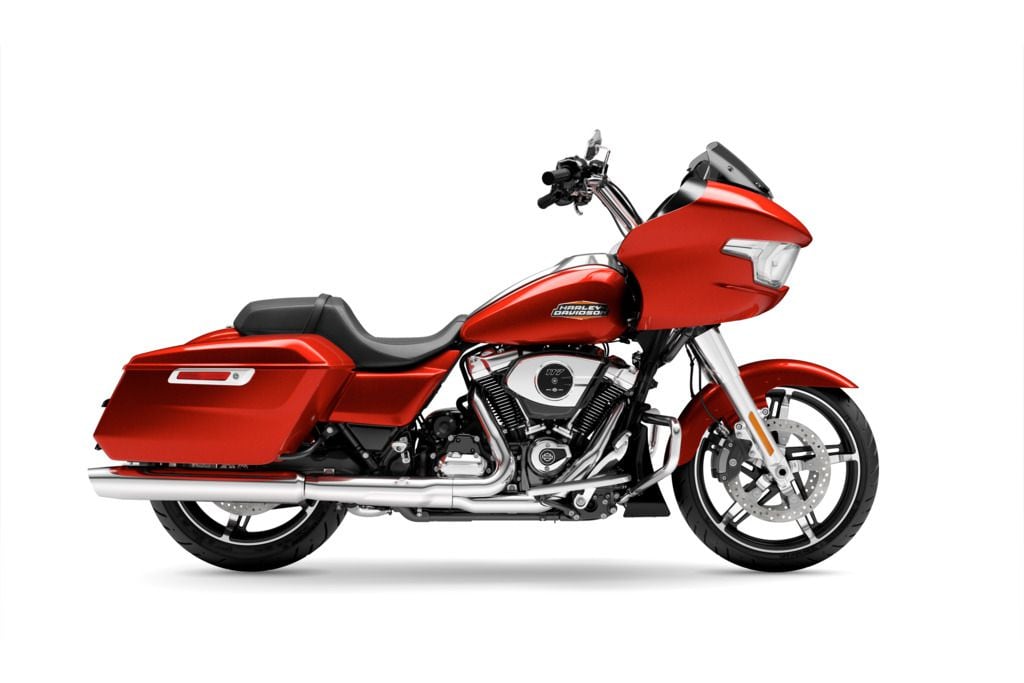
2024 Harley-Davidson Road Glide in Whiskey Fire with chrome trim. (Harley-Davidson/)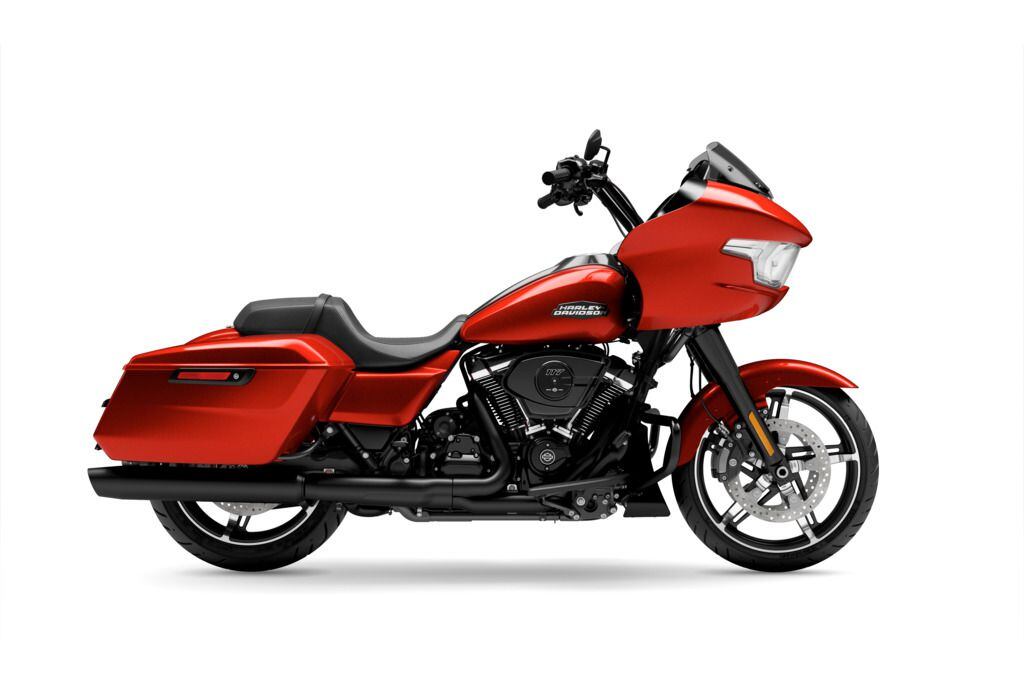
2024 Harley-Davidson Road Glide in Whiskey Fire with blacked-out trim. (Harley-Davidson/)2024 Harley-Davidson Street Glide / Road Glide Specs
MSRP: Starting at $25,999 Engine: Liquid-cooled, 45-degree V-twin; 4 valves/cyl. Displacement: 1,917cc Bore x Stroke: 103.5 x 114.3mm Compression Ratio: 10.3:1 Transmission/Final Drive: 6-speed/belt Claimed Horsepower: 105 hp @ 4,600 rpm Claimed Torque: 130 lb.-ft. @ 3,250 rpm Fuel System: Electronic Sequential Port Fuel Injection Clutch: Wet, multiplate slipper/assist Frame: Steel tube w/ two-piece backbone and bolt-on rear subframe Front Suspension: 49mm dual bending valve; 4.6 in. travel Rear Suspension: Premium Low Hand-Adjustable, preload adjustable; 3.0 in. travel Front Brake: 4-piston fixed calipers, floating 300mm discs w/ ABS Rear Brake: 4-piston fixed caliper, 300mm disc w/ ABS Wheels, Front/Rear: Cast aluminum; 19 x 3.5 in. / 18 x 5 in. Tires, Front/Rear: Dunlop H-D Series bias blackwall; 130/60B-19 / 180/55B-18 Rake/Trail: 26.0°/6.7 in. ; 26.0°/6.8 in. Wheelbase: 64.0 in. Ground Clearance: 5.5 in. / 5.7 in. Seat Height: 28.1 in. / 28.3 in. Fuel Capacity: 6.0 gal. Claimed Wet Weight: 811 lb. / 838 lb Contact: harley-davidson.com Gearbox
Helmet: AGV K5 S Mono
Jacket: Vanson Model B (custom)
Pant: Aether
Gloves: Alpinestars Celer V2
Boots: Alpinestars J-6 Waterproof
-
A feast for the eyes and a challenge for man and machine.
-
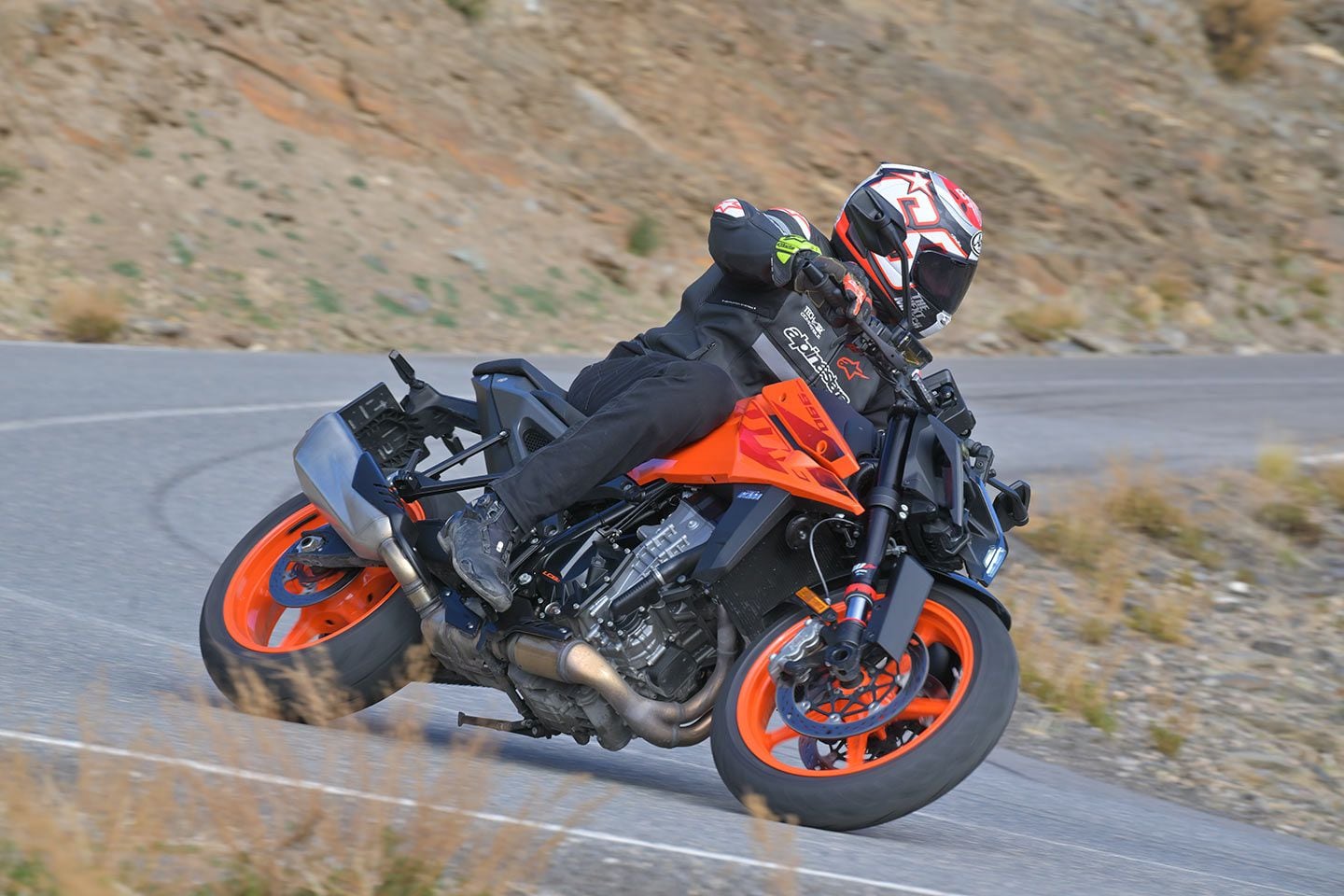
The 990 Duke is not a remake of the 890 Duke R, but an entirely new platform for KTM, who says the bike is 96 percent new compared to the 890. (KTM/)In introducing the 2024 990 Duke, KTM has almost removed itself from conversations on best middleweight naked bike and entered the debate over best naked bike, regardless of size. That is assuming you can live without the gut-punching, high-horsepower performance of the more sadistic super-nakeds, like Aprilia’s Tuono V4, BMW’s S 1000 R, Ducati’s Streetfighter V4, and KTM’s own 1390 Super Duke R Evo.
There’s a place for those bikes. But in riding the 990 Duke, we’re reminded that there are even more places for a bike like this—a bike that has enough power and performance to get your blood pumping, but not enough to be overkill in the real world.
It’s a Goldilocks bike, with a little extra up its sleeve.
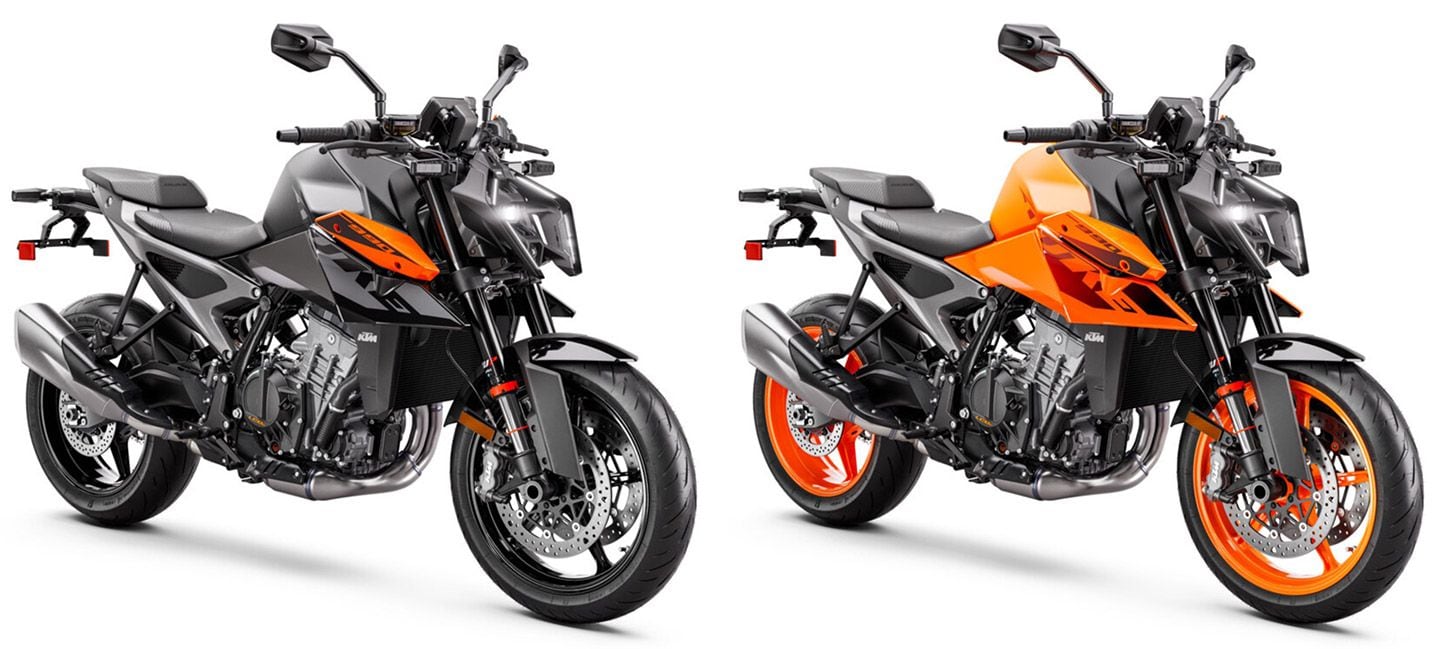
The 2024 990 Duke is available in two color options: KTM orange or black. Stickers are overcoated, which is a nice touch and highlights KTM’s attention to detail. (KTM/)Positioning
Large as the 990 Duke might be (it’s also physically larger than the 890 Duke), KTM still considers the bike a “middleweight.” We’ll call it middleweight-plus and think of it as competition for Triumph’s Street Triple 765, Yamaha’s MT-09, and Ducati’s Streetfighter V2. Others will look at the 990 Duke as a sportier, but still practical alternative to the less edgy middleweight nakeds like the Suzuki GSX-8S, Aprilia Tuono 660, and Yamaha MT-07.
Widely varying competition and use cases in mind, KTM decided to build an almost all-new bike for 2024. In fact, the 990 Duke is 96 percent new compared to the 890 Duke R. It’s physically larger, yes, but also has a more rigid chassis, expansive electronics package, and a more aggressive look.
Related: 2024 KTM 990 Duke First Look
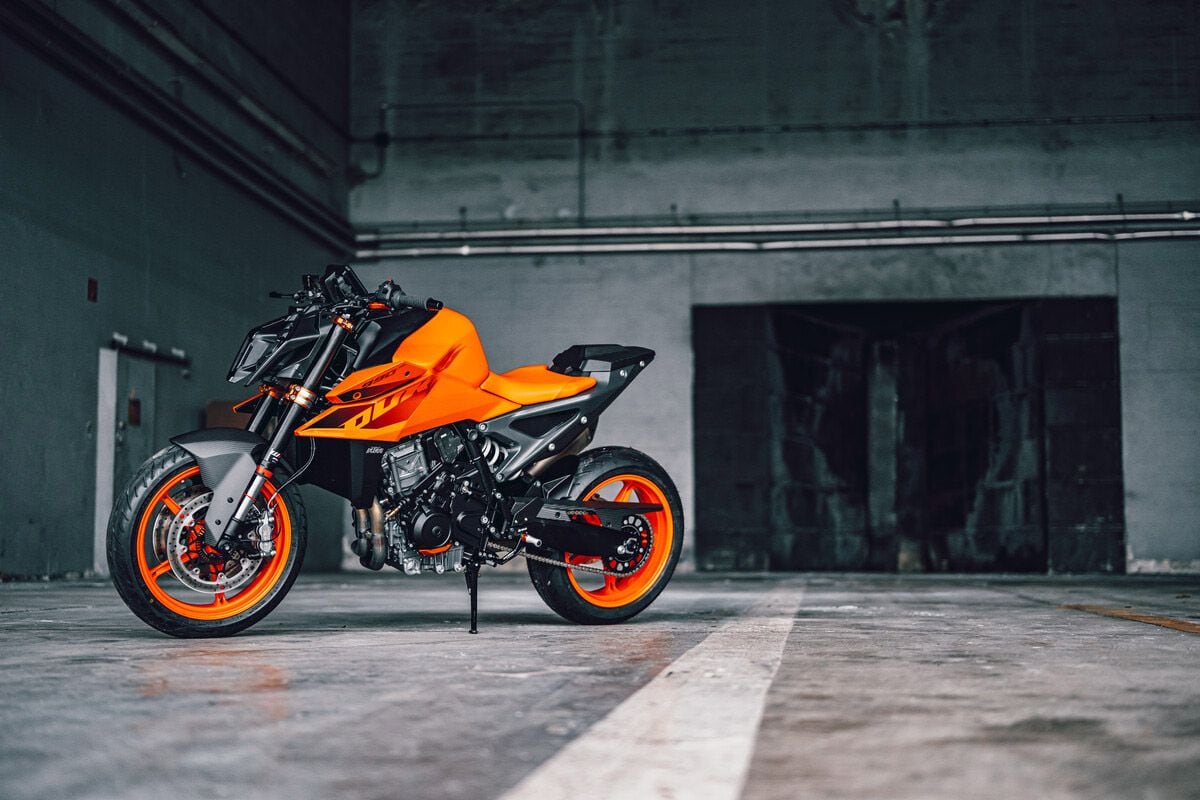
Available PowerParts spice up the 990 Duke look. Important to mention is that this bike is produced at KTM’s main plant in Mattighofen, Austria. That differs from the 790 Duke and 790 Adventure, which are built in China through KTM’s joint venture with CFMoto. (KTM/)That includes a new headlight, which is worth calling out not because of its polarizing shape, but because it was simultaneously developed for the 990 Duke and 1390 Super Duke R, highlighting the close relationship between those bikes.
This is a bike that KTM wants to compare to its big brother, rather than the 890 Duke R it replaces.
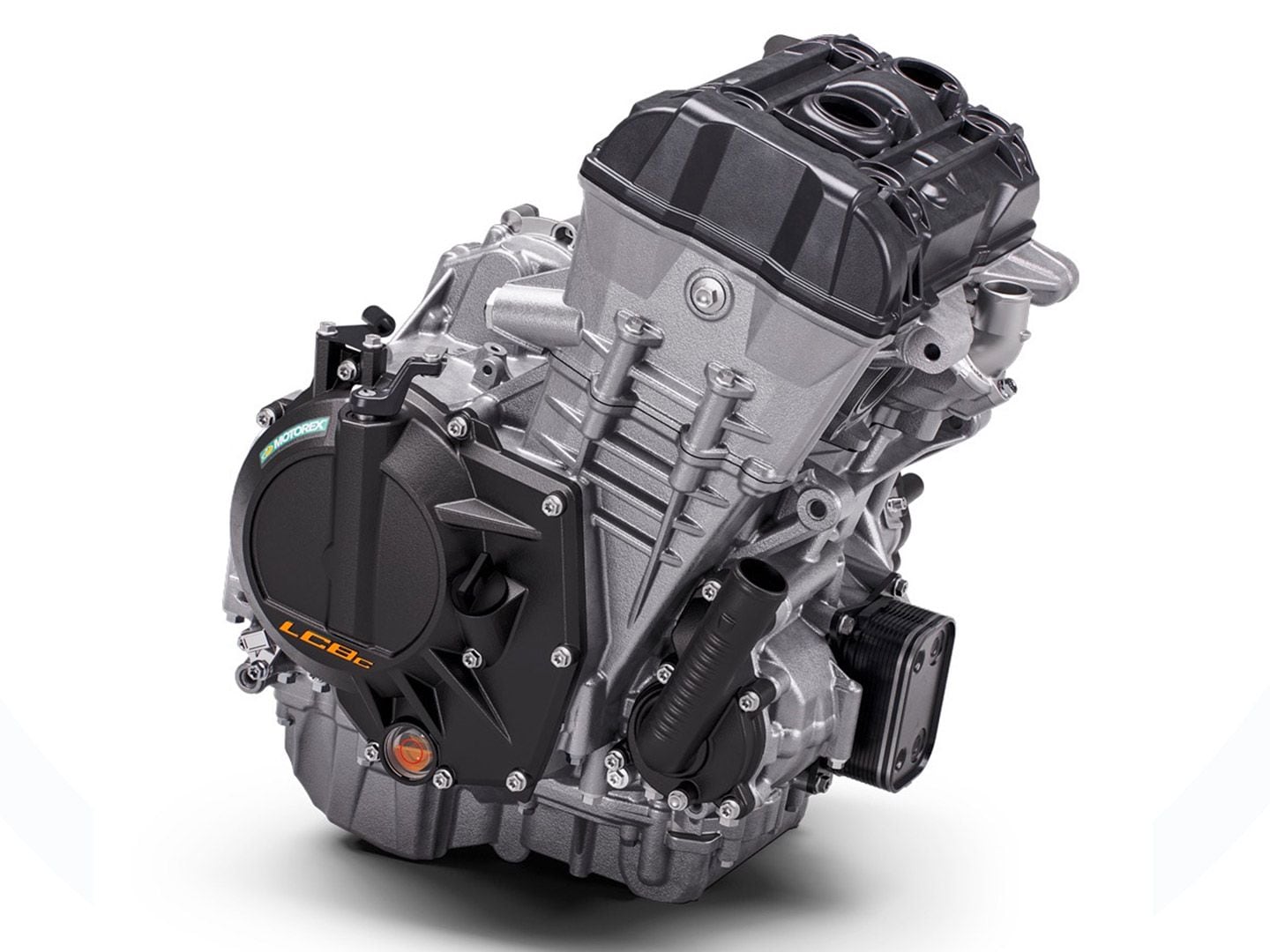
The new, 947cc parallel twin makes more power and torque, but also has improved rideability over the outgoing 889cc twin. The best part is the broad torque curve, which adds to the bike’s flexibility. It’s fast, but plenty smooth for casual riding. (KTM/)Engine
Much of the Duke’s newness comes from the LC8c (Liquid-Cooled, 8-valve, compact) engine that has grown from 889cc to 947cc thanks to a larger bore (92.5mm versus 90.7mm) and longer stroke (70.4mm versus 68.8mm). The pistons, rods, crank, exhaust, and cam timing are all new; KTM adding that rideability is improved due to the increased rotating mass, which knocks a little edge off the power delivery and adds to the bike’s street-friendly personality. Especially when compared to the 1390 Super Duke.
Power and torque numbers get a modest bump, the 990 producing a claimed 123 hp at 9,500 rpm and 76 lb.-ft. of torque at 6,750 rpm. Compare that to the 890′s 121 hp and 73 lb.-ft. of torque.
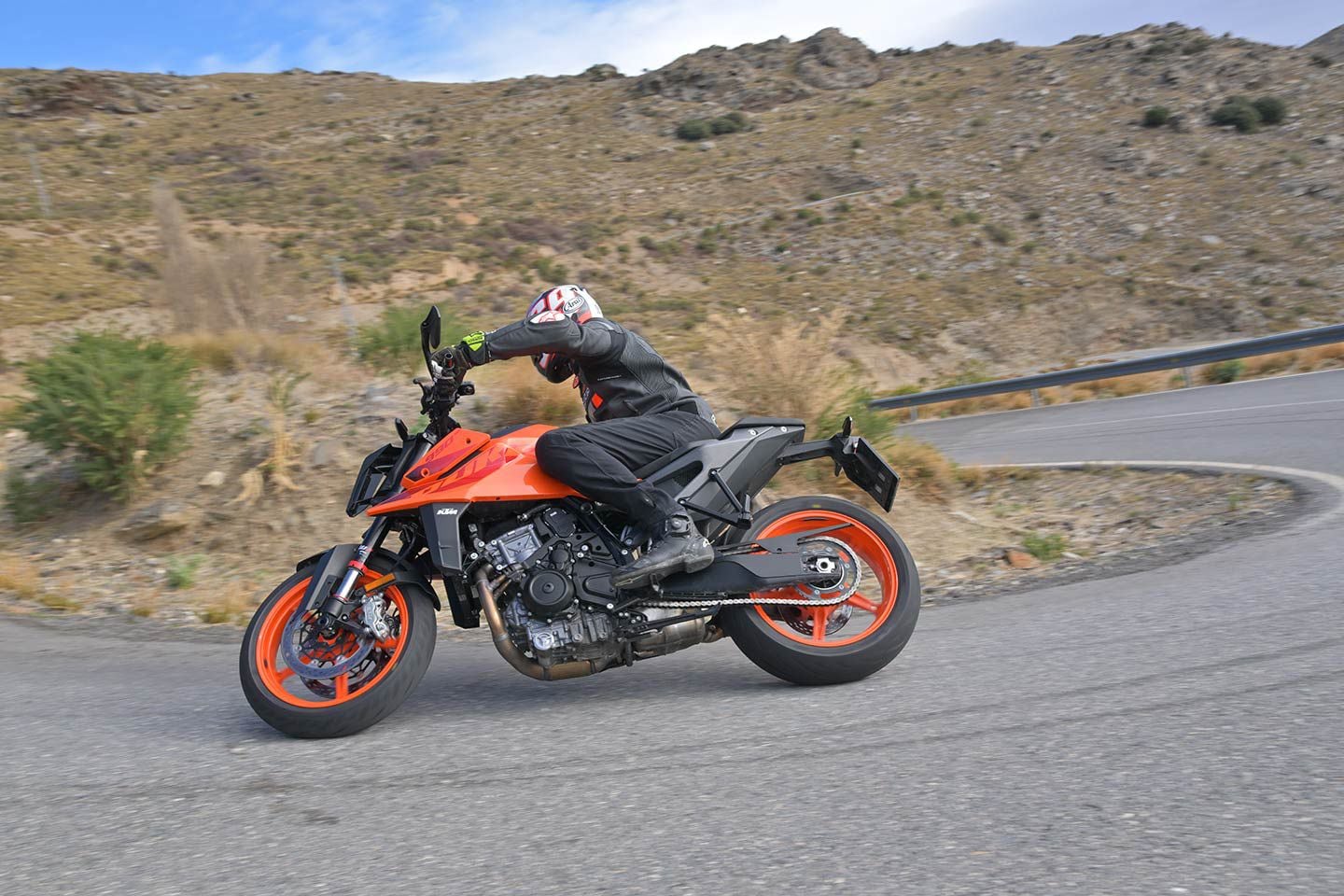
Engines are the focal point of any naked bike, and while that’s mostly the case here, KTM’s design team has done a good job of pulling your eyes away from the engine with clean lines throughout the rest of the bike. (KTM/)The focus on torque and a tractable power delivery are noticeable at around-town speeds or tearing up tight mountain roads. This is a rowdy, rule-breaking motorcycle that’s game for wheelies if that’s what you want, but more impressive is the engine’s flexibility. It’s as friendly as it is fun, with a surplus of usable torque that keeps you from having to constantly search for the right gear. That makes it a less busy motorcycle to ride.
Smooth power delivery and a good throttle connection put the alliance between engine and electronics on full display and add to the grown-up demeanor. The engine is quite smooth, but has enough vibration to blur the mirrors at maintained highway speeds.
Related: 2024 Triumph Street Triple 765 R Review
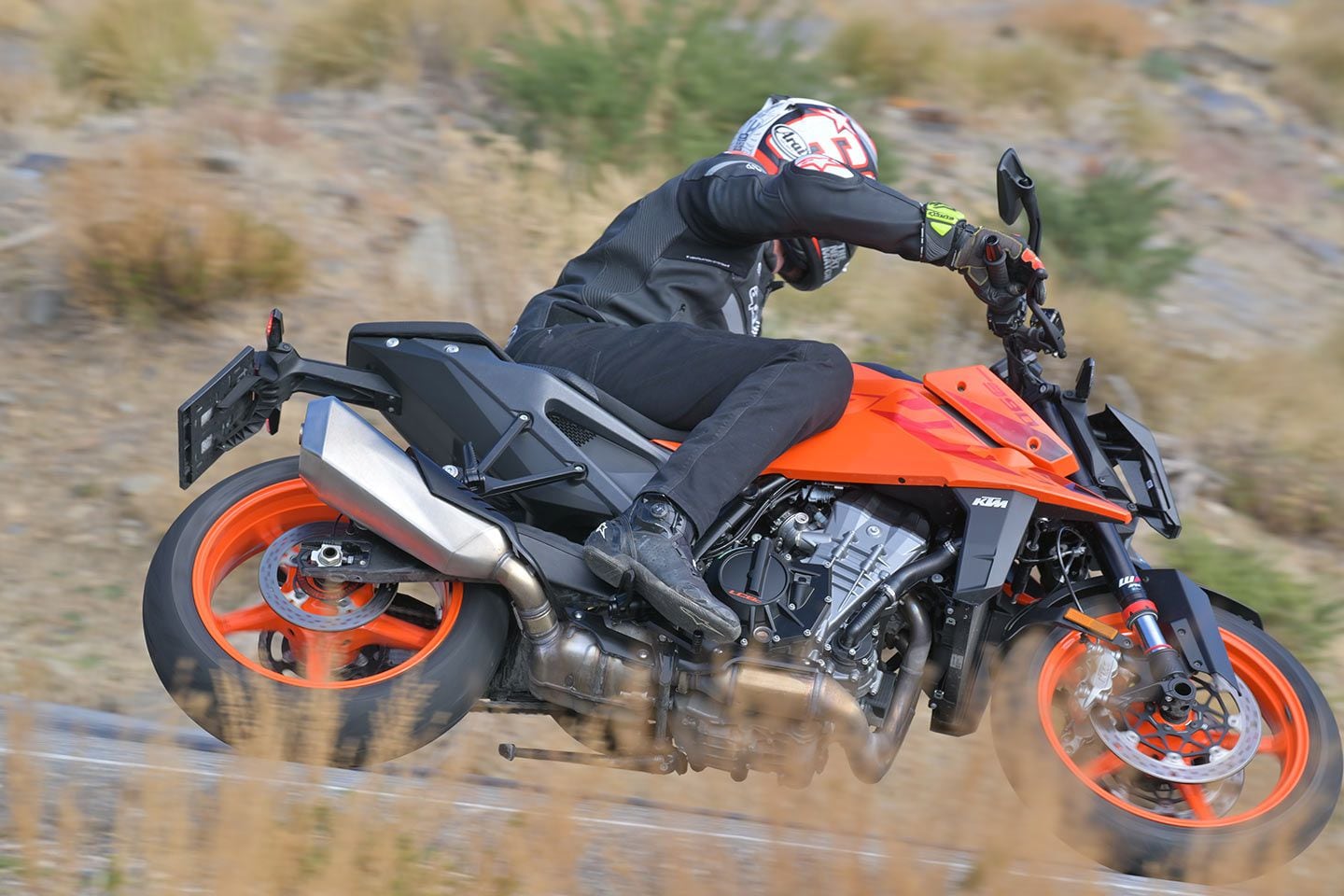
While the 990 Duke is physically bigger than the 890 Duke it replaces, it’s not excessively large. RIders over 6 feet tall will actually notice a decent bend at their knees, and often be sitting up against the passenger seat. This rider is 6-foot-3. (KTM/)Speaking of shifting, we’ve struggled with the transmission on a few KTM testbikes over the years, including a recently tested 890 Adventure R, but the transmission on the 990 Duke we rode felt great. Shifts were quick, precise, and overall seamless, aided by the optional bidirectional quickshifter that was installed.
Chassis
The 990 Duke’s frame has a completely different construction than the unit it replaces, the most obvious difference being that the main frame runs outside of the swingarm. The goal? Increased rigidity, for added stability under acceleration. “The 890 Duke was known for being agile, but stability was a missing point,” KTM says.
The frame has an 8 percent increase in side stiffness and 5 percent increase in torsional stiffness, with KTM suggesting that overall stiffness is up by roughly 15 percent. The swingarm, developed alongside the frame and die-cast aluminum subframe, goes a different direction and is actually less rigid than before, for better rear-wheel traction. More importantly, it’s 3.3 pounds lighter.
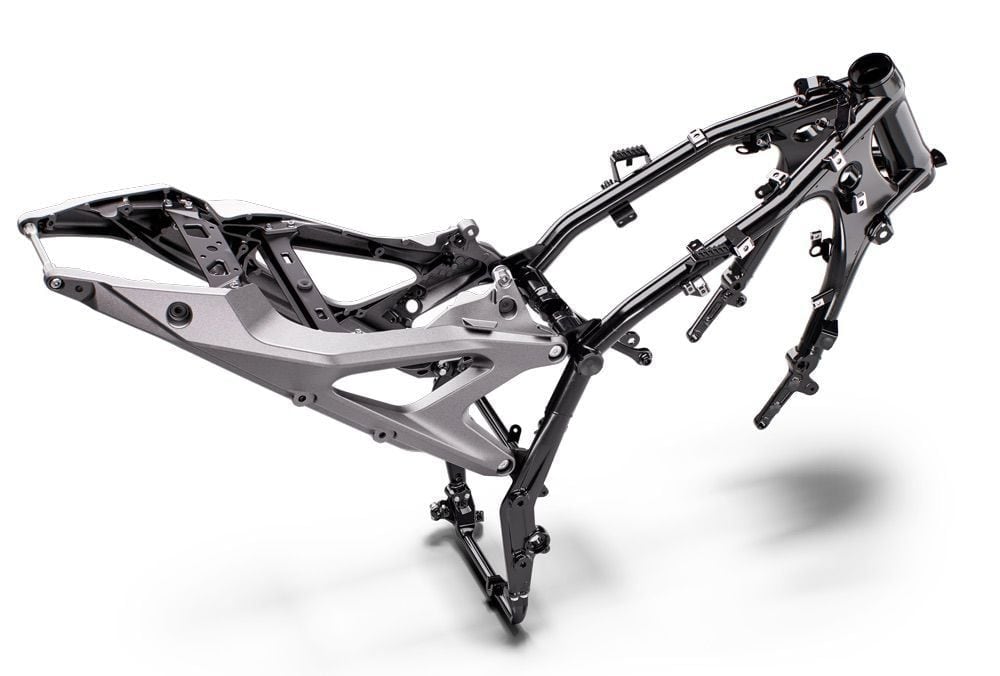
An all-new steel tube frame is stiffer than the 890 Duke’s frame, for increased stability. Big news here is the decision to mount the frame to the outside of the swingarm. (KTM/)More weight reduction comes in the form of new front brake disc mounts, which save 1.1 pounds per side. Wheels are from the 1390 Super Duke R.
WP Apex suspension is unique to the bike, and unique in that the damping difference between clicks is intended to be easier to feel. Total setup range includes five clicks of compression on the left fork leg, five clicks of rebound on the right fork leg, and five clicks of rebound at the shock.
None of this is to say that KTM has gone out of its way to lessen the 990 Duke’s blow. Comfort is kept in mind, but this bike is very much set up for fast, flowing roads, as evidenced by the wickedly entertaining street ride that KTM staff led us on during our first day with the 990, which included everything from tight switchbacks to open highway and everything in between.
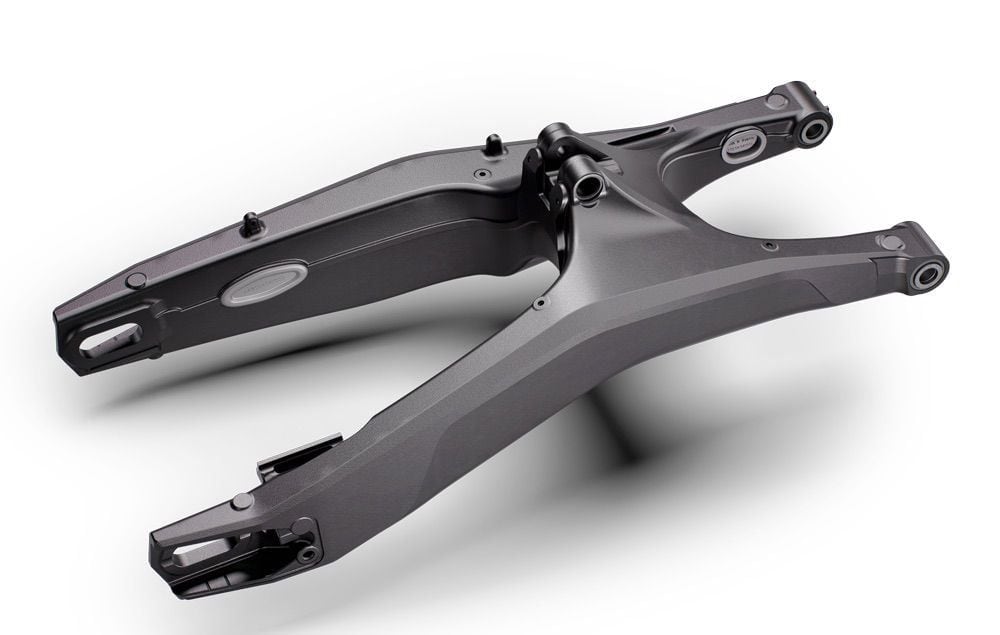
The 990 Duke’s swingarm is gravity die-cast, for less weight. It also has more flex, for better bump absorption. (KTM/)You can feel the added stability KTM has pumped in while ripping along more flowing sections of canyon road. This Duke is still relatively light on its toes, but a little extra effort is required to steer the bike into a corner or flick it from one side to the other, especially when compared to the middleweight Dukes of yesteryear. The benefit is that the bike feels stable and planted when banked into a corner, and in no way does the bike feel cumbersome at slower speeds. Think of it like an athlete who bulked up during the offseason and is overall stronger, but not quite as quick as before.
As for the frame, you can sense the high levels of rigidity, which keeps the bike from coming unwound as the pace picks up. There’s a sense of tightness to the bike that still says, “This is a KTM; it’s meant for being pushed.”
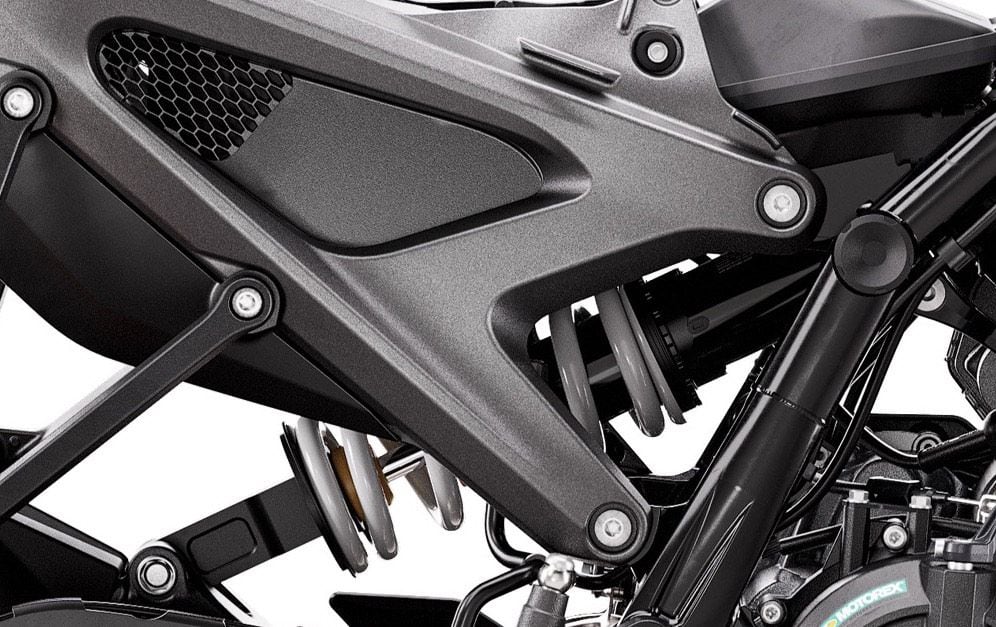
WP Apex suspension is used front and rear, with five clicks of rebound adjustment at the back and five clicks of compression/rebound adjustment at the front. KTM says the hope is to simplify the suspension adjustment process. Notice the aluminum die-cast subframe with integrated airbox and air intake under the seat. (KTM/)The only place where you don’t see that extra level of aggression is in the front brakes. There’s good stopping power but the system lacks consistency through the lever pull. KTM says it has tried different pads and small changes, meaning performance is likely down to the master cylinder.
Electronics
Keep in mind that there’s an expansive electronics package to support you as the pace picks up, or to help tailor the bike to the type of riding you’re doing. That includes three standard ride modes (Sport, Street, and Rain), as well as optional Performance and Track modes, which are available as part of a “demo program” for the first 1,500 kilometers (932 miles), but must be purchased once that number is exceeded.
Rider-aid settings are preset for Sport, Street, and Rain, limiting the amount of adjustability, but in switching over to the Performance and Track modes, you’re able to adjust settings for power delivery (three levels), traction control (nine levels plus off), wheelie control (five levels plus off), ABS (two levels), and KTM’s MTC/MSR engine-brake system.
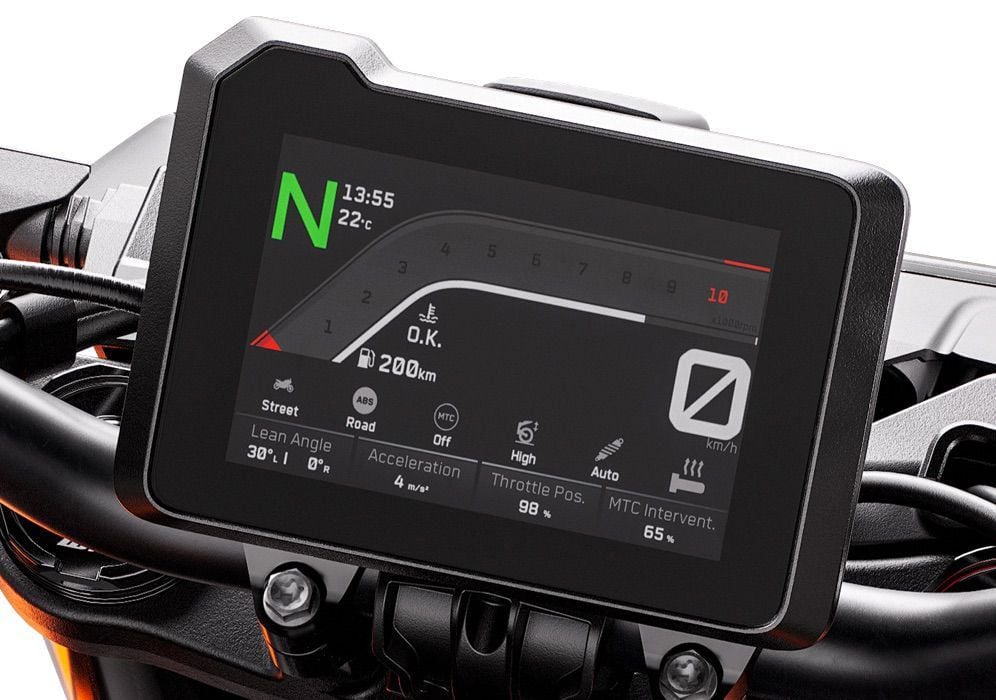
KTM isn’t alone in the push to make modern dashes look crisp and well-organized despite the continued evolution of rider aids, but it’s absolutely leading the charge. The dash is intuitive and easy to navigate. (KTM/)All of this is adjusted through an absolutely stunning 5-inch TFT display that uses illustrations that move with each setting change to show exactly what you can expect from the lower or higher setting you’re choosing. For example, the bike will be shown in an exaggerated wheelie when selecting the “Very High” wheelie control setting, but shows the front wheel almost on the ground when scrolling over to the “Very Low” option.
A new switch cube on the left side of the handlebar is one of the best in the game right now thanks to the added dimensions, which makes it easy to push the intended button with a gloved hand. It’s these small details where KTM is setting itself apart from the competition, and where its constant push to innovate can be seen. We can’t say enough about how well-designed the hardware is.
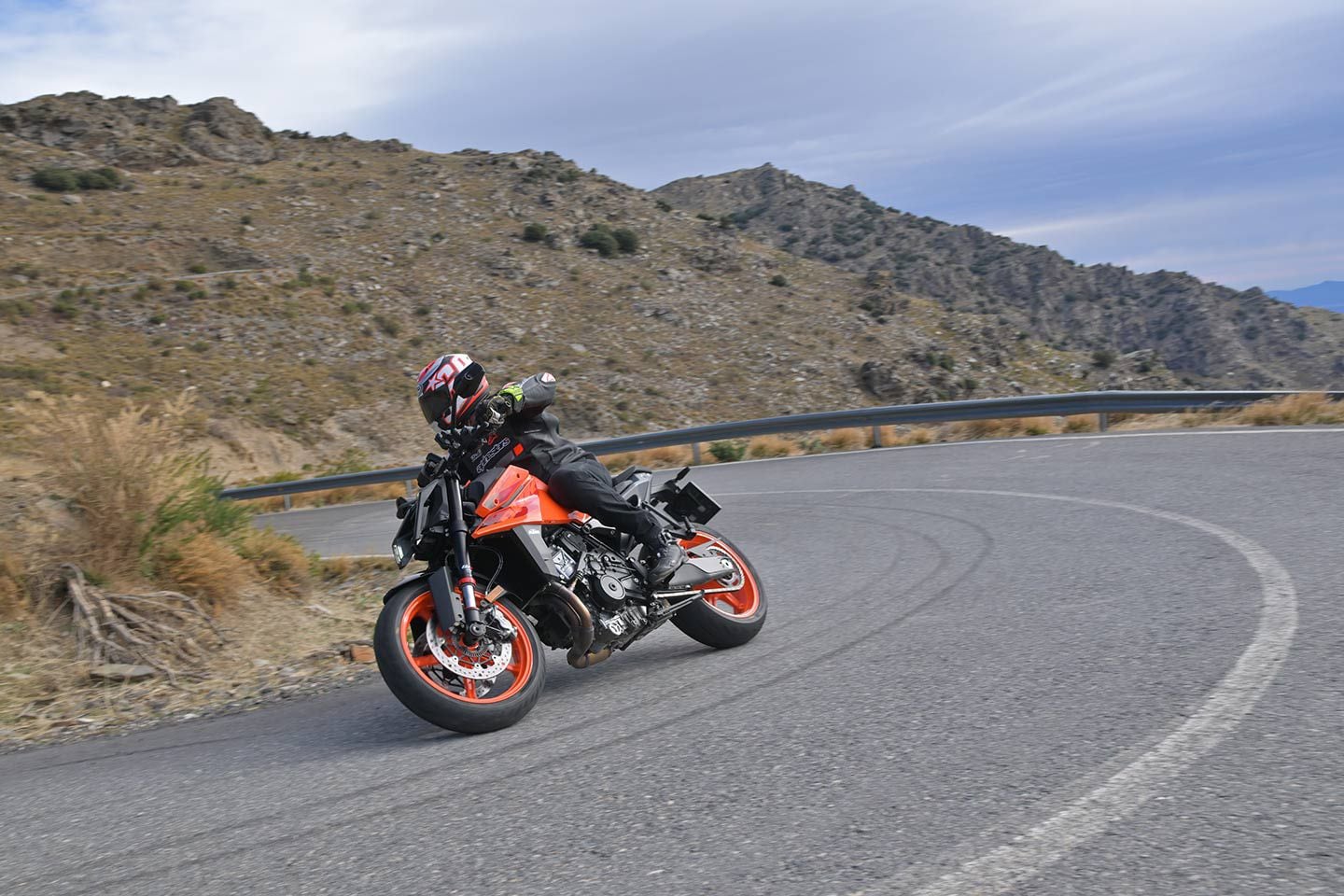
Someone was having fun on this road before we got there. Solid electronics help with that. (KTM/)The software is just as good, but can only be tested so much on cold foreign roads climbing snowcapped mountains. On drier, controlled roads earlier in the ride, we tested various wheelie-control settings and found the system accurately keeps the front wheel from rotating past an expected height given the setting you’ve selected. Power cuts aren’t aggressive, evidence of the overall refinement that KTM has achieved with its rider-aid intervention. This was not always the case.
Design and Fit and Finish
KTM’s attention to detail and high level of refinement can also be seen in the hardware sprinkled across the bike. Every touch point feels solid and has a quality finish to it. It doesn’t feel like any corners were cut or like anything is used because it was the cheaper option, the only real exception being the aforementioned brake master cylinder.
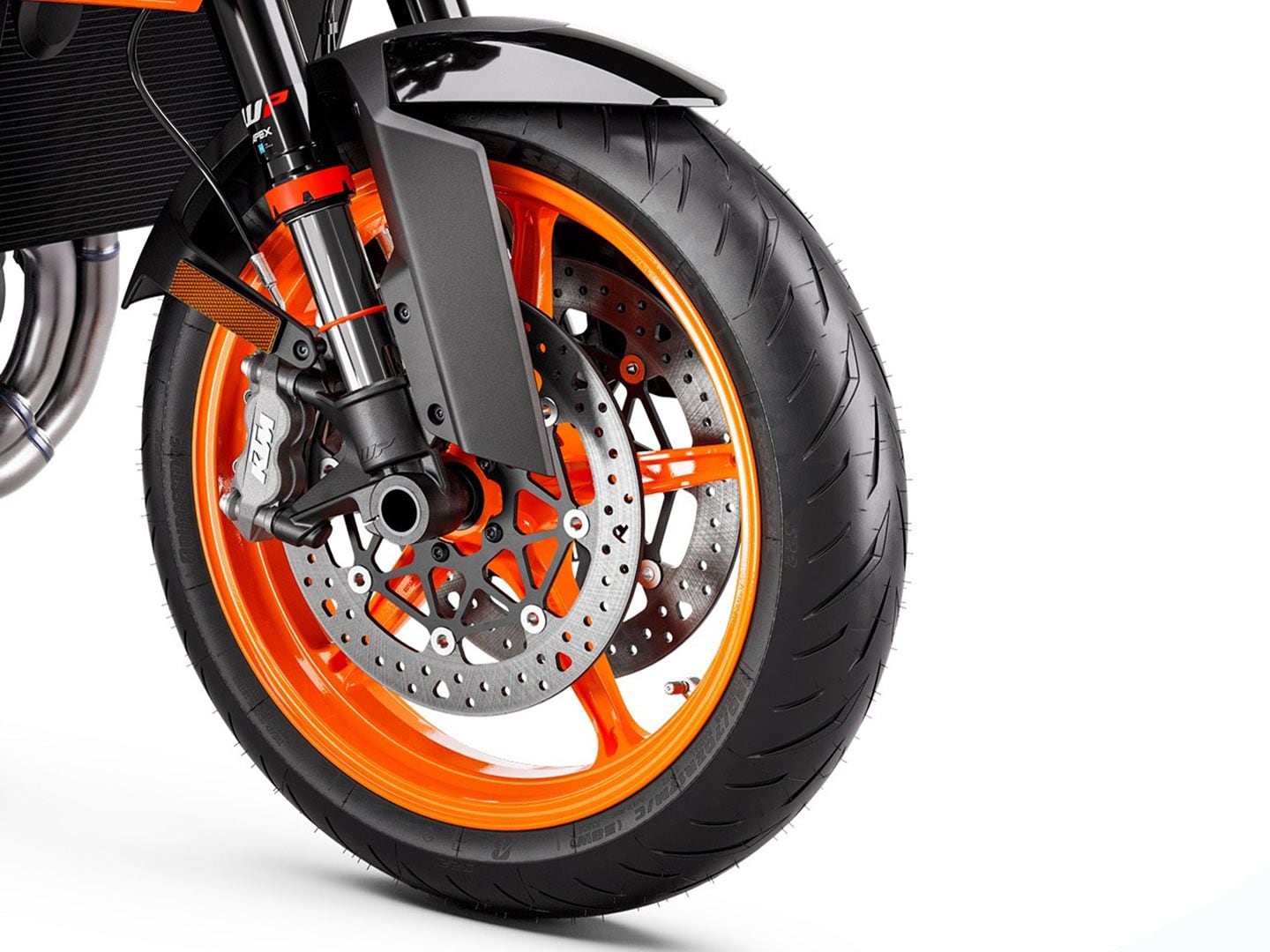
Front brake discs are updated for reduced weight (1.1 pounds per side). There’s good stopping power from this system, but lever pull isn’t consistent. That happens to be one of our few complaints around the 990 Duke. Front wheel is identical to the one on the 1390 Super Duke R Evo. (KTM/)More refinements come in the form of an updated seat with a flatter leading edge, which keeps you from sliding up into the 3.8-gallon tank.
Seat height is 32.5 inches, and thanks to a narrow tank/seat junction, the bike isn’t as big as its otherwise larger dimensions would lead you to believe. The Super Duke is more roomy, but physically larger and less ideal for around-town stuff.
Another thing to consider is that KTM’s naked bikes have never been known for stellar wind protection. That continues to be the case here; the angular headlight and large dash cause just enough turbulence to make this a bike you probably won’t want to do much touring on.
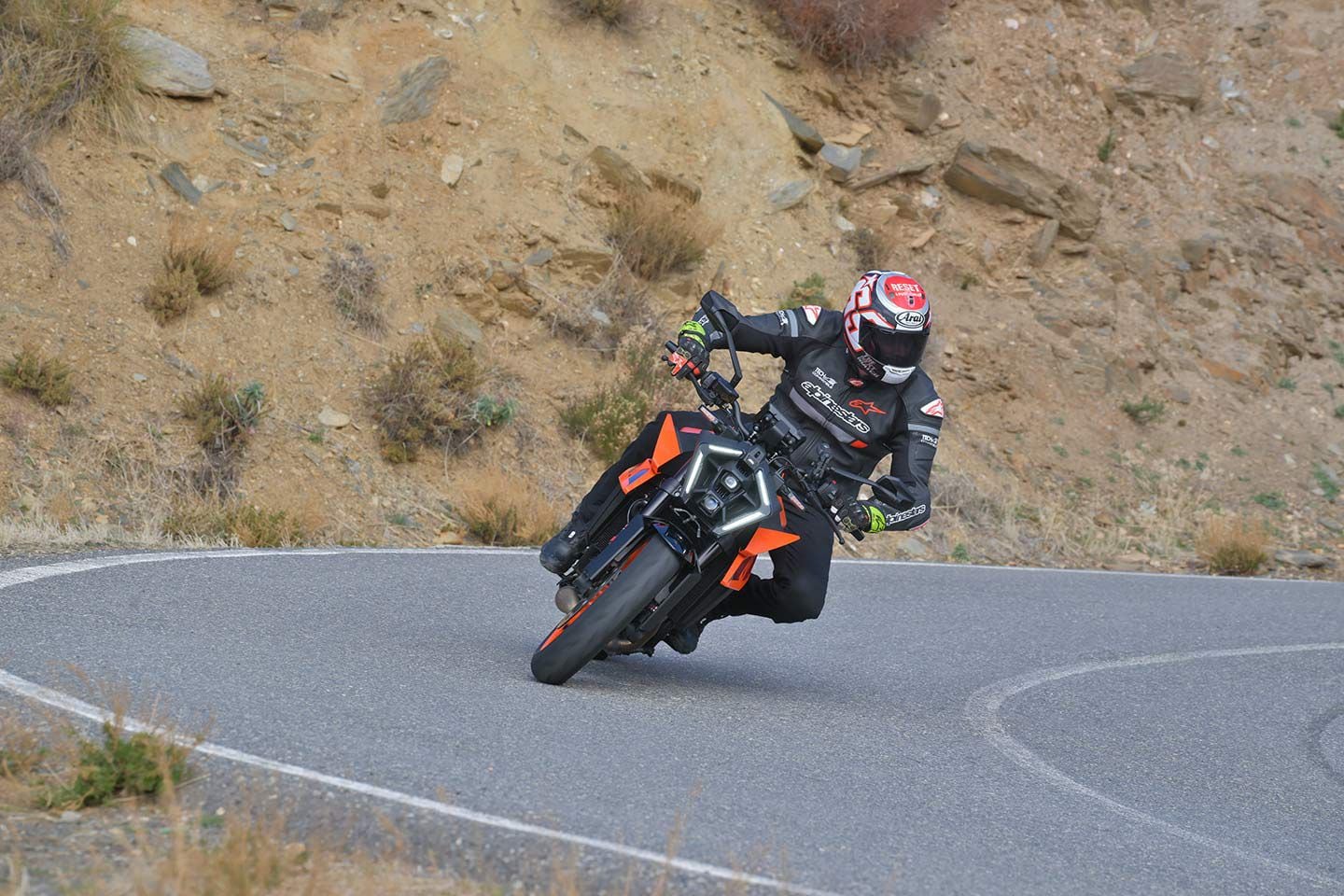
The 990’s headlight is shared with the 1390 Super Duke R and looks better in person than it does in pictures. An added benefit, according to KTM, is that it has a more consistent light spray. (KTM/)Final Thoughts
Mind you, touring is not what KTM had in mind when it brought the 990 Duke to life. The middleweight naked bike category is one of the most hotly contested in motorcycling right now, and the only way to really succeed here is to stand out from the competition. KTM is doing that by sticking to its “Ready to Race” roots, but pumping a little extra versatility into the 990 Duke through a deliciously tractable and user-friendly engine that’s capable of entertaining the experienced rider just as much as it is being a comfortable, around-town mount for the casual street rider.
The bike still has an edgy side to it, but that side is well-managed by electronics and small tweaks that make it more stable and more predictable. It’s very much a grown-up version of the middleweight Dukes that came before it.
Ironically, that takes the 990 Duke from being an interesting middleweight naked bike option to an interesting alternative to KTM’s own 1390 Super Duke R Evo, which seems to get rowdier and more advanced with every model year update.
Does that make this one of the most practical naked bikes, period? We’d certainly throw its name in the hat.
2024 KTM 990 Duke Claimed Specs
MSRP: N/A Engine: DOHC, liquid-cooled, 4-stroke parallel twin Displacement: 947cc Bore x Stroke: 92.5 x 70.4mm Compression Ratio: 13.5:1 Transmission/Final Drive: 6-speed/chain Claimed Horsepower: 123 hp @ 9,500 rpm Claimed Torque: 76 lb.-ft. @ 6,750 rpm Fuel System: Electronic fuel injection w/ ride-by-wire Clutch: PASC (Power Assisted Slipper Clutch); cable actuation Engine Management/Ignition: TCI Frame: Chromoly tubular steel Front Suspension: 43mm WP Apex USD fork, rebound and compression adjustable; 5.5 in. travel Rear Suspension: WP Apex shock, rebound and spring preload adjustable; 5.9 in. travel Front Brake: 4-piston calipers, 300mm discs (w/ ABS) Rear Brake: 2-piston caliper, 240mm disc (w/ ABS) Wheels, Front/Rear: Cast aluminum; 17 x 3.50 in. / 17 x 5.50 in. Tires, Front/Rear: 120/70-17 / 180/55-17 Rake/Trail: 24.2º /3.9 in. Wheelbase: 58.1 Ground Clearance: 7.7 in. Seat Height: 32.5 in. Fuel Capacity: 3.8 gal. Claimed Wet Weight: 395 lb. Contact: ktm.com 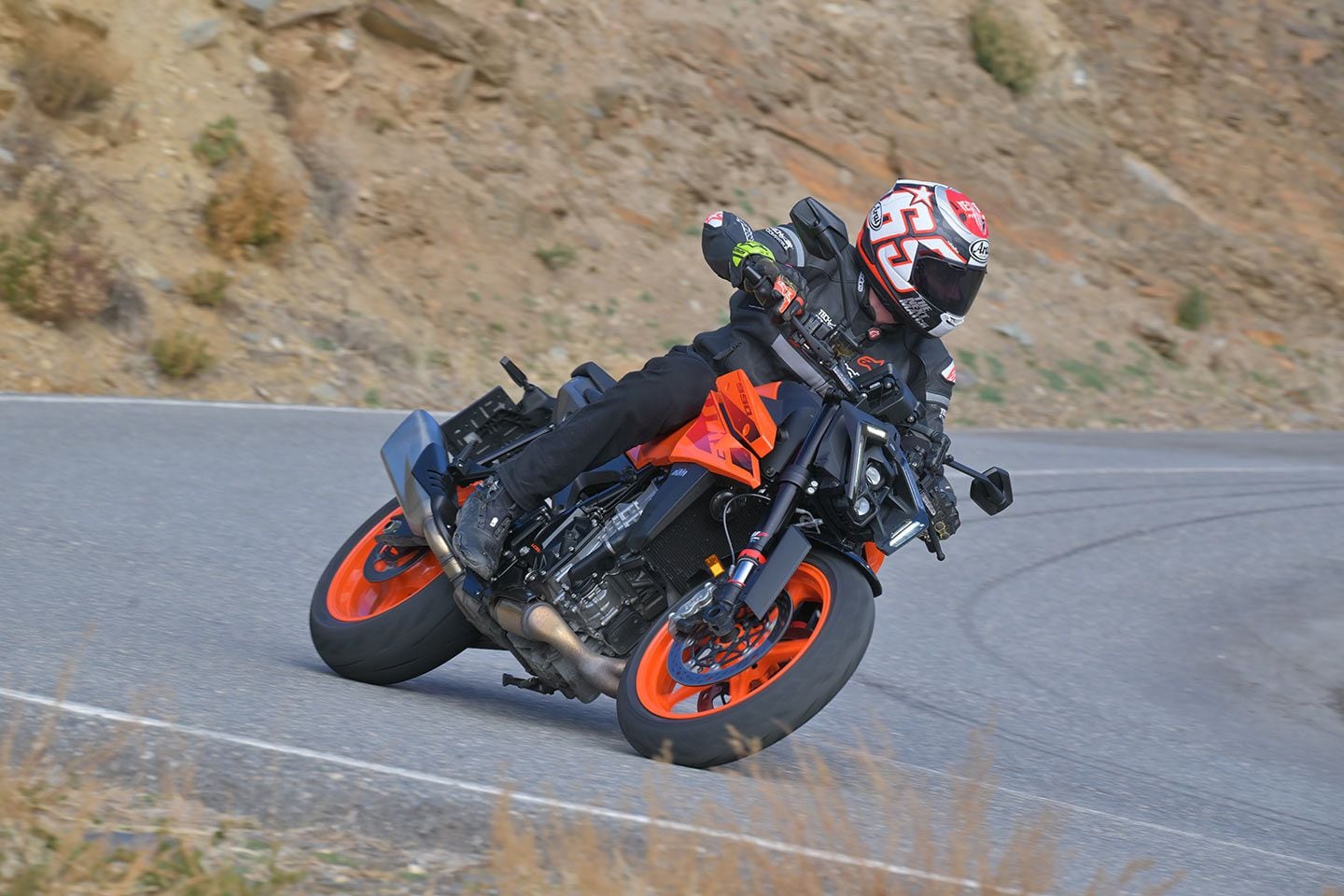
KTM doesn’t hide its intentions with the 990 Duke. Yes, there is an added level of stability and an emphasis on comfort, but the bike is still developed for fast, flowing roads. (KTM/)Gearbox
Helmet: Arai Corsair-X Nicky Reset
Jacket: Alpinestars Missile Ignition
Pants: Copper V3 Denim
Gloves: Alpinestars GP Tech V2 S
Boots: Alpinestars SP-2
-
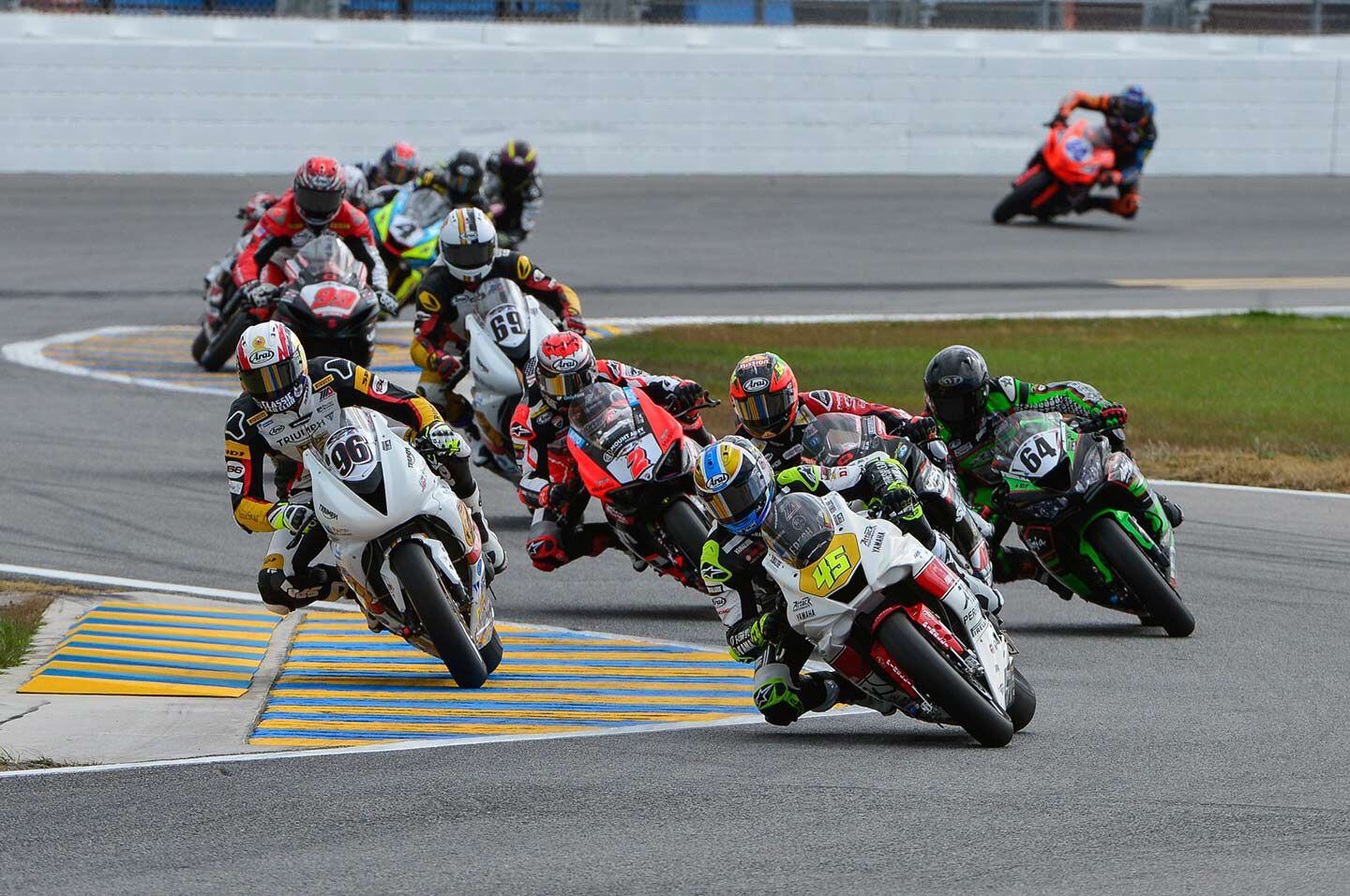
This year’s Daytona 200 will include 67 riders from 13 countries on five brands of motorcycles. (Brian J. Nelson/)As we rev up for another season of MotoAmerica competition, one thing is clear: For the 10th year in a row the series has continued to grow. There is no doubt that part of this stems from the fact that the series has embraced change, tried new classes, and modified others to ensure that the racing remains the star of the show. As buyers’ tastes have evolved over the years with the bikes they purchase, MotoAmerica has paid attention and made those adjustments.
In 2023, the series hosted more than 200,000 fans at its nine events, ran 103 individual races across all classes, while airing 673 broadcasts across its TV and digital-viewing platforms. In total MotoAmerica has nine different classes, with different combinations making up race weekends at the nine stand-alone events, in addition to special events like the Daytona 200 and support races at Circuit of The Americas MotoGP event. The classes include: Superbike, Supersport, Stock 1000, Junior Cup, Twins Cup, King of the Baggers, Royal Enfield Build. Train. Race., Super Hooligan, and Mini Cup.
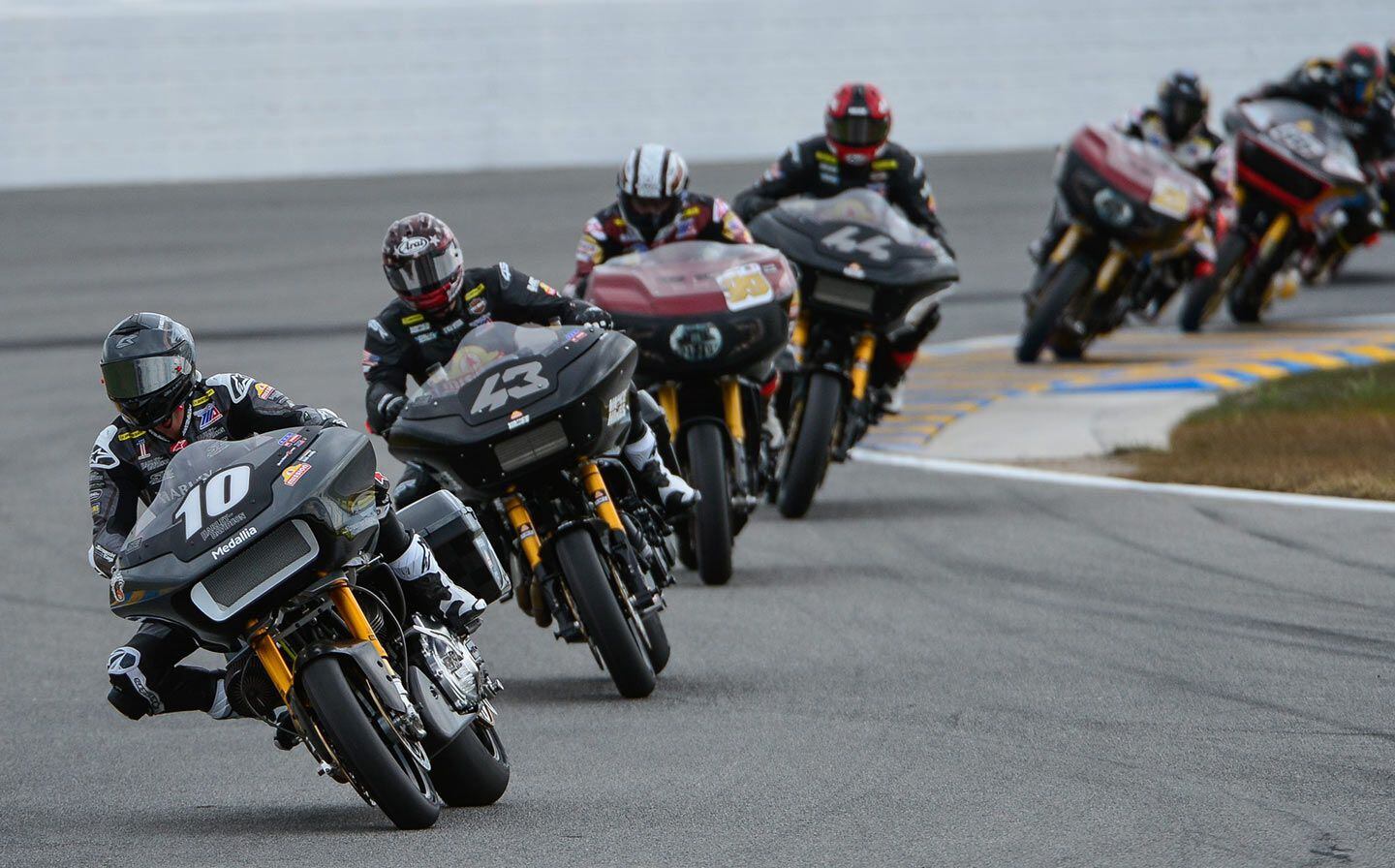
The Mission King of the Baggers series will kick off its season at Daytona. (Brian J. Nelson/)Perhaps one of the biggest pieces of news for 2024 is that the King of the Baggers class will run alongside MotoGP at Circuit of The Americas, putting this unique-to-America series on the world stage. Additionally, the class welcomes some exciting new racers like former WSBK factory rider Ruben Xaus and Australian Superbike champ Troy Herfoss joining the fray.
As is tradition, and for the second year in a row after rejoining the MotoAmerica fold, the Daytona 200 will kick off America’s roadracing season from Daytona International Speedway. This year marks the event’s 82nd running, and is once again a one-off event. Support races will include the first rounds of the 2024 Mission King of the Baggers Championship, the BellissiMoto Twins Cup Championship, and the Mission Super Hooligan National Championship.
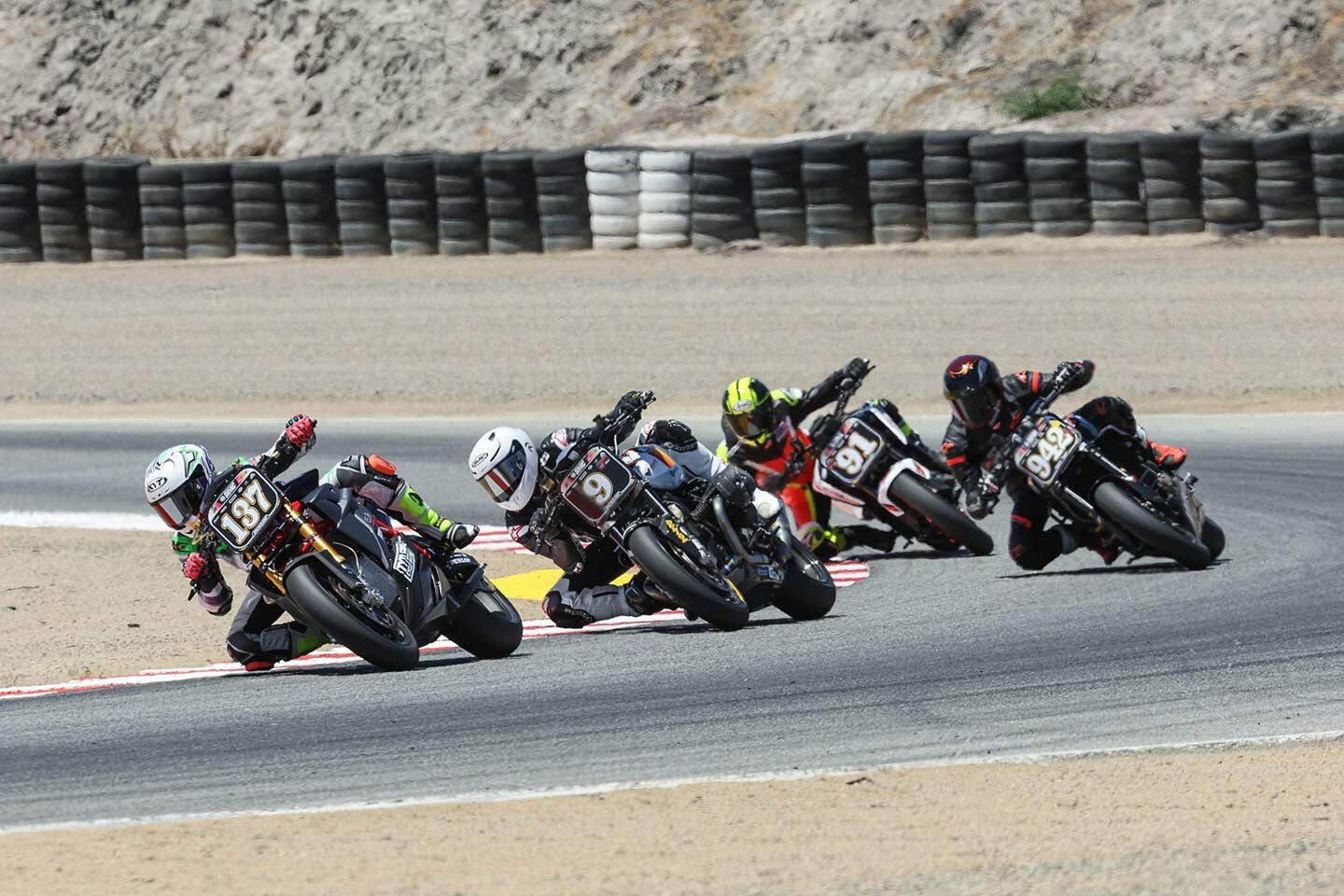
Mission Super Hooligans will kick off its season at Daytona. (Brian J. Nelson/)The MotoAmerica Medallia Superbike season will kick off at Road Atlanta April 19 to 21, with Supersport and Junior Cup also getting underway. The following round will host the first events of the season for the Royal Enfield Build. Train. Race. and Stock 1000 classes. In total, the meat of the MotoAmerica series will visit nine venues in 2024 including a return to Mid-Ohio and concluding with the New Jersey round in September.
Daytona 200: March 7 to 9, 2024
This stand-alone event will feature the unique format of the Daytona 200 with middleweight motorcycles from five different manufacturers tackling the speedway’s 3.51-mile, 12-turn road course and 31-degree banking for the coveted 82nd Daytona 200 title.
The 2024 entry list includes 67 riders from 13 different countries. Returning riders include last year’s Daytona 200 champion Josh Herrin to defend his title, joined by four-time AMA Superbike champion Josh Hayes, the Vision Wheel M4 Ecstar Suzuki team led by Richie Escalante and two-time Daytona 200 winner Brandon Paasch, and the new Rahal Ducati Moto team with PJ Jacobsen, Kayla Yaakov, and Corey Alexander. Some exciting international racers have committed this year as well, including 13-time Isle of Man winner Peter Hickman on a PHR Performance Team Triumph Street Triple 765 RS. He is joined by teammate Richard Cooper, who carded a top-five finish back in 2008. Others signed up are World Endurance Championship YART Yamaha team riders Marvin Fritz, Niccolò Canepa, and Karel Hanika, Canadian Superbike champ Ben Young, and so many more.
How To Watch: Daytona 200
MotoAmerica Live+
Thursday, March 7: Starting at 1:25 p.m. EST, MotoAmerica Live+
Friday, March 8: Starting at 9:00 a.m. EST, MotoAmerica Live+
Saturday, March 9: Starting at 8:45 p.m. EST, MotoAmerica Live+
MavTV
Daytona 200: Next day delay
Mission King of the Baggers, 3:10 p.m. Race 1 (8 laps): Live
Mission King of the Baggers, 4:05 p.m. Race 2 (8 laps): Live
ESPN Star+
Daytona 200, 1:10 p.m. EST (57 laps): Live
MTRSPT1
Mission King of the Baggers, 3:10 p.m. Race 1 (8 laps): Live
Mission King of the Baggers, 4:05 p.m. Race 2 (8 laps): Live
Roland Sands Mission Super Hooligans, 1:45 p.m. Race 1 (6 laps): Live
Roland Sands Mission Super Hooligans, 10:10 a.m. Race 2 (6 laps): Live
MotoAmerica TV
Roland Sands Mission Super Hooligans, 1:45 p.m. Race 1 (6 laps): Live
Roland Sands Mission Super Hooligans, 10:10 a.m. Race 2 (6 laps): Live
YouTube
Roland Sands Mission Super Hooligans, 1:45 p.m. Race 1 (6 laps): Live
Roland Sands Mission Super Hooligans, 10:10 a.m. Race 2 (6 laps): Live
For a complete Daytona 200 weekend schedule, go here.
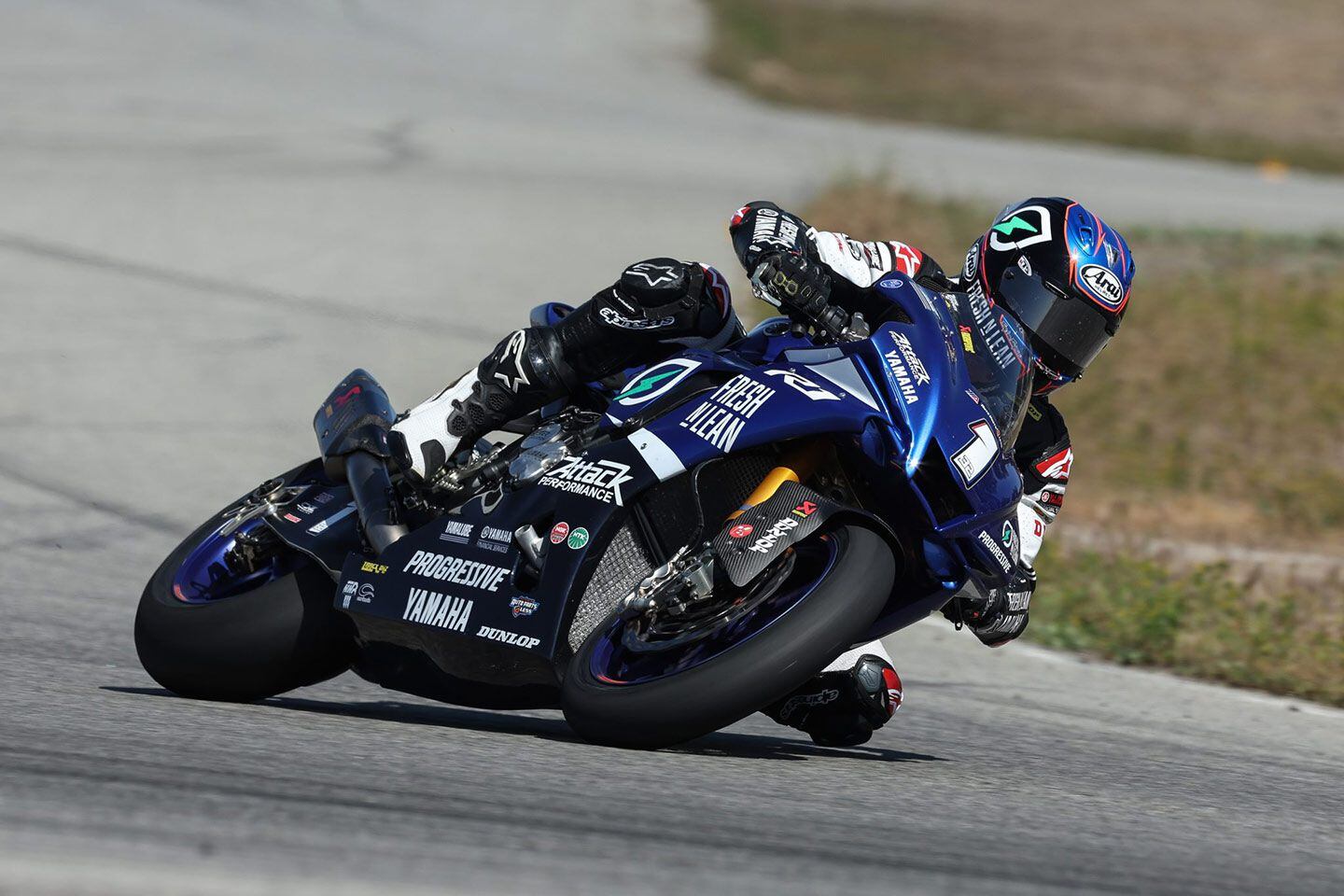
MotoAmerica’s Superbike class will kick off its seasons at Road Atlanta in April. (Brian J. Nelson/)How To Watch: MotoAmerica Medallia Superbike Season in 2024
As has been the case the past few seasons, there are multiple viewing options available for fans to watch the MotoAmerica series, from cable networks to streaming services and YouTube.
- The 2024 MotoAmerica Championship season can be streamed on <a href="https://www.motoamericaliveplus.com/?_gl=1*s9mixe*_ga*MTY0NTk4NTM5MC4xNzA3MjUwOTMy*_ga_3ZPEY74RJ8*MTcwODQ1NDg5NS45LjEuMTcwODQ1NDkxMy40Mi4wLjA.">MotoAmerica Live+</a>; all classes, all races can be viewed live and are also available for playback.
- Superbike and KOTB main events will be live on MotoAmerica <a href="https://www.youtube.com/channel/UCN2Pl_bflnLpy_cdv8lV1gQ">YouTube Live</a> starting with the Road Atlanta round.
- FS1/FS2 will run Medallia Superbike and Bagger races on a week delay on MotoAmerica Rewind.
- Medallia Superbike and Mission King of the Baggers will broadcast live on <a href="https://www.mavtv.com/">MavTV</a>.
- Medallia Superbike, Supersport, KOTB, and Super Hooligan can be viewed live on <a href="https://www.mtrspt1.com/en/">MTRSPT1</a>. Junior Cup will be delayed.
- Supersport, Stock 1000, Twins Cup can be viewed live on <a href="https://streamstak.com/motoamericatv/">MotoAmericaTV</a>, while Medallia Superbike, Junior Cup, and Mission King of the Bagger will be delayed.
2024 MotoAmerica Superbike Calendar
April 19–21: MotoAmerica Superbikes at Road Atlanta
May 17–19: MotoAmerica Superbikes at Barber
May 31–June 2: MotoAmerica Superbikes at Road America
June 14–16: MotoAmerica Superbikes at Brainerd
June 28–30: MotoAmerica Superbikes at The Ridge
July 12–14: MotoAmerica Superbikes Speedfest at Monterey
Aug.16–18: MotoAmerica Superbikes at Mid-Ohio
Sept. 13–15: MotoAmerica Superbikes at Texas
Sept. 27–29: MotoAmerica Superbikes at New Jersey
-
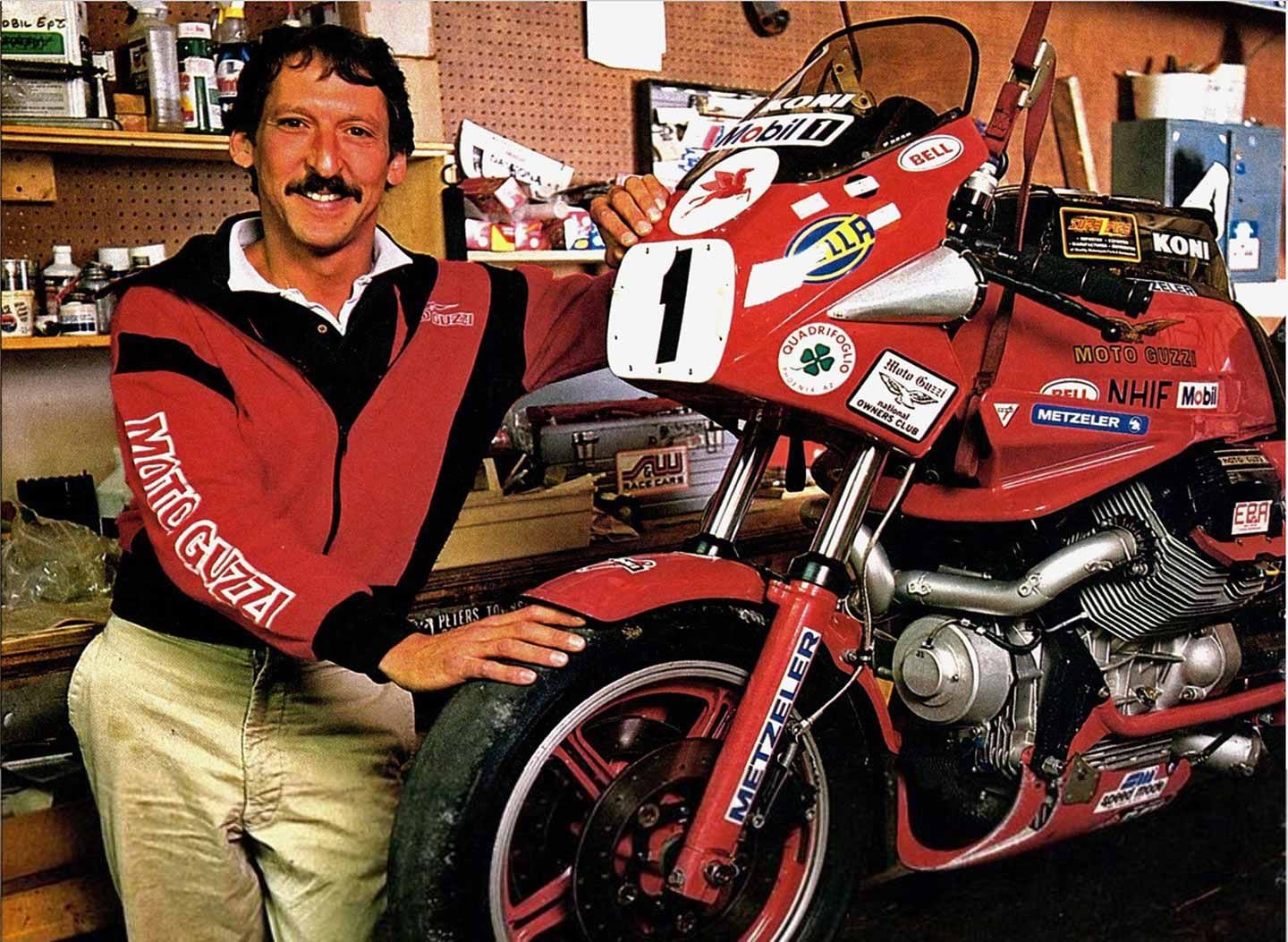
John Wittner, aka Dr. John, with his Moto Guzzi Le Mans. (Paul Eric Smith/Cycle World Archives/)In one of the first conversations I ever had with John Wittner, he told me about himself and his former aeronautical engineer dad, using a window fan and yarn tufts to learn something about how cooling air flowed around the projecting cylinders of his Battle of the Twins Moto Guzzi Le Mans. Small adjustments produced a useful improvement in cooling.
John was studious and meticulous. One evening at a Midwestern AMA event in 1988 I saw him still at work, measuring valve clearances on the new four-valve heads he’d designed, and which Guzzi in Mandello had produced.
“That’s good,” he said to the air. I asked what he’d found.
“I want to be sure the clearances aren’t moving,” he said. “These heads have no history, so if there is seat recession, then the clearance can disappear—maybe enough to hold an exhaust valve open. But it’s good, so I’m happy.”
He’d designed a special chassis for Battle of the Twins racing after seasons of Guzzi experience in endurance events. The stiffness of a backbone frame was easy to calculate, and more important, he wanted to eliminate the upsetting throttle jacking of the shaft drive. On the stock chassis, gear case torque was reacted to the swingarm, so when the engine was throttled up, the rear suspension jacked up as the pinion climbed the ring gear. To correct this he pivoted the gear case on the rear axle and reacted the torque through a strut to the chassis. By varying the height of the strut’s attachment to the chassis, any desired rear end behavior between jacking and squat could be chosen.
He and rider Doug Brauneck won the class in 1987.
Why did people call him “Dr. John”? He had been a dentist until his decision to become a “man in a van with a plan” and race nationally. The “Battle” class was created to continue the fan-pleasing thunderous sound of twins after Japanese four-cylinder Superbikes had eventually driven BMWs, Guzzis, and Ducatis (which had won so many early races) out of the class.
Wittner’s solid achievement of putting Guzzi in the public eye brought a relationship with Alejandro De Tomaso, then owner of Guzzi. Eventually John was invited to Italy as a Guzzi engineer, becoming part of the tradition. He became friends with Guzzi’s great “encyclopedia” Umberto Todero, who was made racing director in 1951, and worked under Guzzi V-8 designer Giulio Cesare Carcano. Guzzi’s ultralight 350 horizontal singles were about to win five consecutive championships 1953 to 1957.
John described telling Todero of a “bad day” at one of the US races, when nothing worked right. Todero replied gravely, “I will tell you what is a bad day at the races: It was when we once returned from Ireland with two destroyed motorcycles and two coffins in the truck.”
I admired John WIttner’s intense focus on racing problems, and his technique of conceiving and testing one idea after another until a solution was found. He changed the direction of his life to live by the force of his ideas.
-

QJMotor has filed patents for a single-cylinder engine that utilizes a second dummy cylinder as a counterbalancer. (QJMotor/)We normally define an engine by its number of cylinders: Singles, twins, triples, and fours are all commonplace. However, a new design by China’s QJMotor throws those definitions into chaos, as it has only one “active” cylinder, but it’s also a V-twin with a second cylinder and piston used purely as a counterbalancer.
The idea of converting a V-twin into a single isn’t new. Ducati famously created its 1990s Supermono racer by lopping the rear cylinder from its Desmoquattro V-twin. The Italian company stuck with the V-twin crankshaft and even kept the rear connecting rod, attaching it to a weighted rocking linkage that replicated the mass of the missing rear piston and gave the engine the balance it needed to rev higher and make more power.
Related: Suzuki’s Supermono Engine Design

Here you can see what Ducati’s solution to the same idea was. It called the design “Doppia Bielleta.” (Cycle World Archives/)During the Supermono’s development, Ducati considered keeping the rear cylinder and simply deactivating it by removing the cylinder head but decided that the additional friction of a spare piston moving in the bore would sap too much power. The final design turned out to reduce friction and made for a more compact engine. Now China’s QJMotor is exploring the original idea, filing patent applications for a single that has a second, inactive cylinder and piston mounted at 90 degrees to the main one.

A look at the crankshaft and a pair of connecting rods to which are attached a traditional piston on one journal and a dummy piston that is actually a counterweight with a hole in it so it won’t compress the air. (QJMotor/)But this isn’t just a V-twin with the rear cylinder head removed. In QJMotor’s designs, the second cylinder has a much smaller bore than the active one, with a weighted piston that’s designed specifically as a balancer. The piston itself has a large hole in its middle so it’s not unnecessarily compressing air, and the inactive rear cylinder is cast in a single piece with its head to keep the engine sealed.
Related: Motorcycle Engine Balancing Act

Ducati’s Supermono appeared on the pages of Cycle World in the September 1993 issue. (Cycle World Archives/)The benefit is the same as with the Ducati Supermono, as the engine’s balance is the same as a 90-degree V-twin, without the addition of balance shafts or other weights. QJMotor’s patent specifically says that the engine is intended to be used in motorcycles but doesn’t reveal its capacity or what sort of bike it’s intended to be used in. Whether it turns out to be a clever solution or an engineering dead end remains to be seen, but if nothing else the patent shows that China’s motorcycle industry, with its reputation for copying rather than innovating, is expanding its R&D capabilities.
-
Pierer Mobility has dominated the large-displacement supermoto segment for years with the KTM 690 SMC R and Husqvarna 701 Supermoto. Now the GasGas SM 700 (also under the company’s umbrella) has joined the party and is powered by the same 693cc thumper. All three bikes are nearly identical; they utilize the same engine, frame, suspension, and braking components. The biggest differences are the brand color and graphics. Over the years, KTM’s large single-cylinder engine (LC4) has benefited from cross-platform sharing in models other than supermotos. The KTM 690 Duke and 690 Enduro R as well as the Husqvarna Svartpilen 701, Vitpilen 701, and 701 Enduro all utilize the LC4 engine.
The 693cc SOHC liquid-cooled single-cylinder engine has 105mm x 80mm bore and stroke dimensions. A 50mm Keihin throttle body delivers the air and fuel mixture. Rider aids include lean-sensitive traction control and ABS. Two ride modes are present (mode 1: Street; mode 2: Supermoto). Street mode provides smooth throttle response with the safety nets of traction control and ABS. Supermoto mode is more aggressive with direct throttle response and Supermoto traction control that allows the rider to drift, slide, and lift the front wheel. Both traction control and ABS can be fully disabled in either mode.
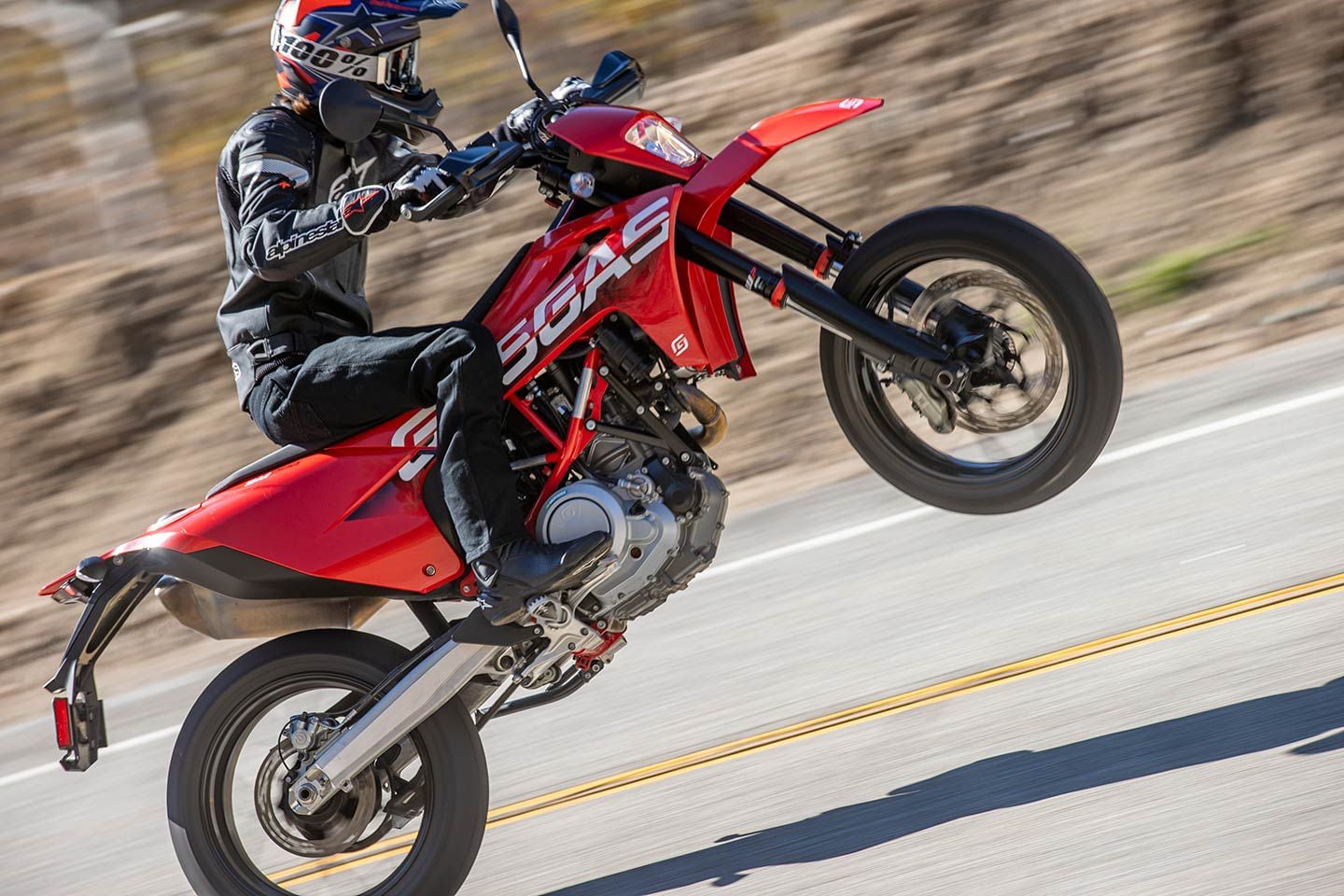
The SM 700 is the only supermoto in the GasGas product lineup. (Jeff Allen/)Increasing the SM’s functionality are a slipper clutch and bidirectional quickshifter. The chassis consist of a chromium-molybdenum steel-trellis frame with a self-supporting polyamide subframe housing a 3.6-gallon fuel tank. Damping is achieved via a 48mm WP Apex fork with compression and rebound adjustment. A WP Apex shock with compression, rebound, and preload adjustment is fitted at the rear. The braking system utilizes Brembo calipers at both ends. Up front is a single four-piston CNC-machined Brembo caliper with a 320mm floating front rotor. Wheel sizes are pretty standard for a supermoto with 17s at each end and mounted with Continental ContiAttack SM EVO tires as standard.
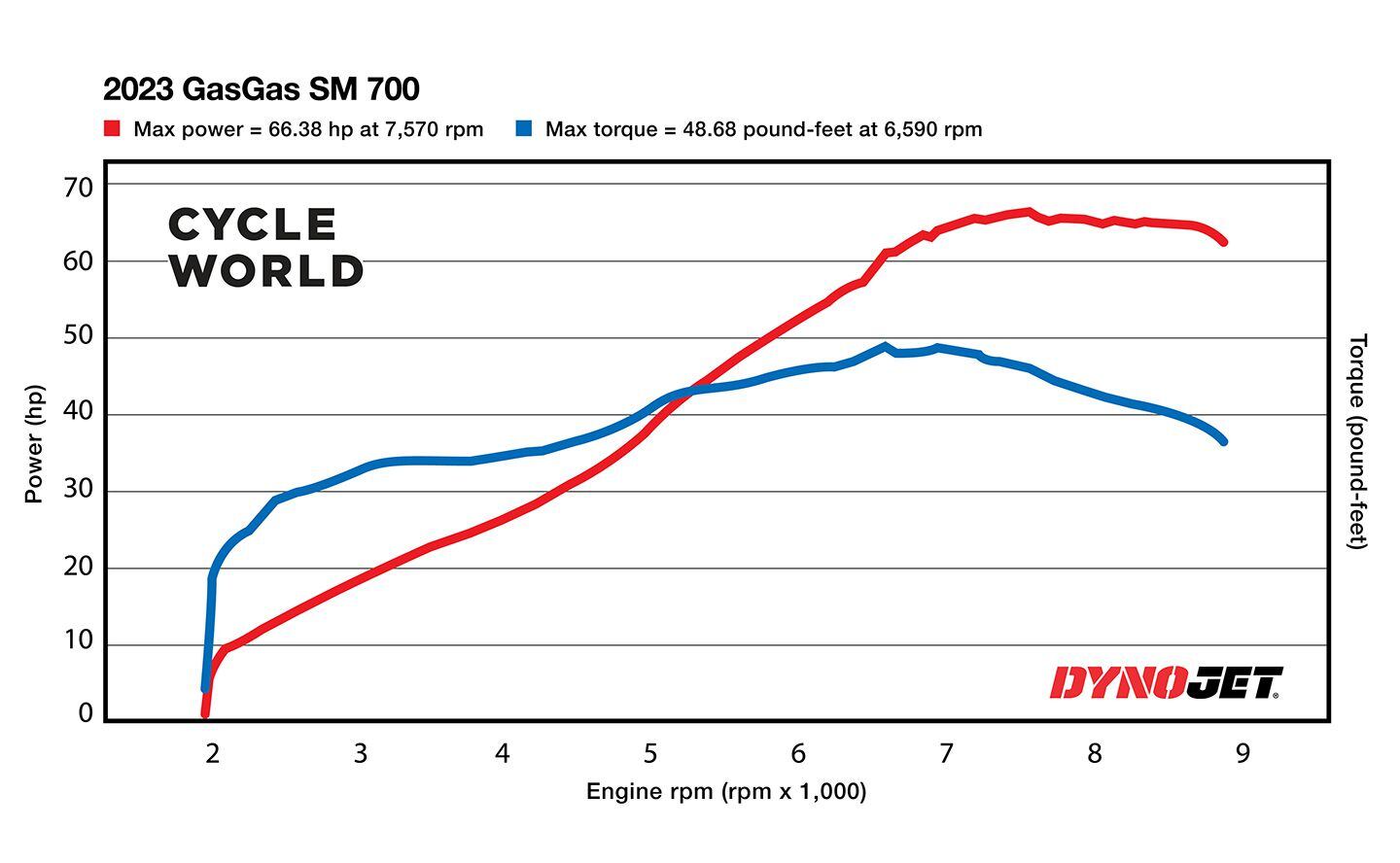
2023 GasGas SM 700 Dyno Chart. (Robert Martin/)Before hitting our Dynojet 250i dynamometer, we put the big-bore supermoto on our automotive scales, which registered 349 pounds with a full tank of fuel. On the Cycle World dyno, the 2023 GasGas SM 700 produced 66.4 hp at 7,600 rpm and 48.7 lb.-ft. of peak torque at 6,600 rpm. For reference, the 2019 KTM 690 Enduro R (with a similar engine) produced 59.2 hp at 8,250 rpm and 43.4 lb.-ft. of peak torque at 6,800 rpm on the Cycle World dyno. The LC4 engine is one of the most entertaining in motorcycling. Its acceleration and torque from the midrange to its roughly 9,000 rpm redline are awesome. We’d love a little bit more performance from the bottom-end, but the engine’s large displacement and dual counterbalancers give it the legs to run comfortably at highway speeds.
Will Ducati’s all-new Hypermotard 698 steal the spotlight and become the new benchmark for big-bore supermotos? At least on paper, The Italian contender seems up to the task, but we will need to conduct an official comparison test before any titles are granted.
-
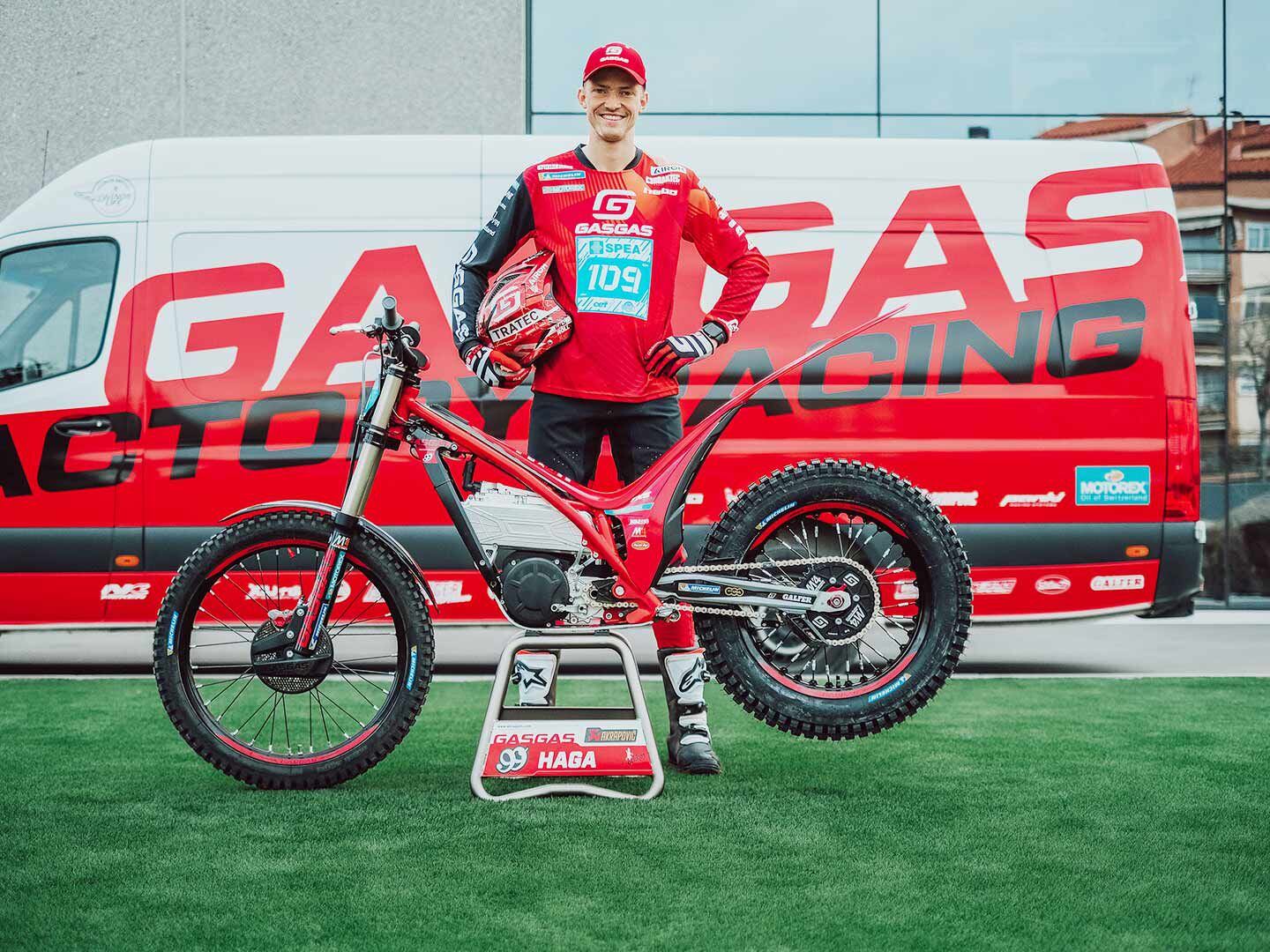
GasGas to Showcase New Electric-Powered Prototype Trial Bike in Spain (GasGas/)GasGas Press Release:
As a world leader in trial bike manufacturing, GASGAS has been evolving its own electric-powered trial bike – the TXE – for several years. Fast forward to 2024 and up next on the development program for the exciting new model is to bring it back to competition, which is where GASGAS Factory Racing star, Sondre Haga, steps in. This weekend, the former Trial2 World Champion will compete at the Spanish Trial Championship aboard the TXE and we’re excited to see how he gets on. Good luck, Sondre!
- GASGAS returns to action with its electric powered trial bike – the TXE
- Latest version of our prototype model to be ridden at Spanish Trial Championship
- Sondre Haga to collect valuable data for the GASGAS engineers developing the TXE
By rolling out on our prototype TXE trial bike this weekend in Spain, Sondre Haga will use the event to further develop the prototype in a true competitive environment. Being a TrialGP World Championship rider, Haga will naturally be eager to deliver a strong result. However, his main reason for competing is to help develop the bike and provide feedback to our engineers as they continue to refine this exciting new model.
-

Triumph Street Triple 765 RS to Race in Daytona 200 (Triumph/)Triumph Press Release:
The PHR (Peter Hickman Racing) Performance Team, supported by FreedomRoad Financial, will head to the USA in March this year to tackle the Daytona 200, with racers Peter Hickman and Richard Cooper setting their sights on clinching another victory aboard a Triumph Street Triple 765 RS.
Hickman’s PHR Performance Team will be preparing two Street Triple 765 RS bikes in the UK, with the official support of Triumph. Now in its 82nd year, the Daytona 200 runs on March 9th at the famed Daytona International Speedway with a race start time of 1pm ET.
The 2024 event presents an exciting opportunity for Hickman in particular, to compete at the race he’s long desired to tackle, while also serving as a valuable chance for more track time piloting the Triumph machine that he’ll race at the 2024 Isle of Man TT.
Steve Sargent, Triumph’s Chief Product Officer:
“Triumph is pleased to support Peter Hickman and Richard Cooper in their efforts to bring the Daytona 200 crown back to the UK with the PHR Performance Team. This iconic race holds a special place in the history of Triumph Racing. In fact, Brandon Paasch won on the Street Triple 765 in its first outing at Daytona in 2022, and he credits the engine with making the difference when he powered to his dramatic victory. It’s the same three cylinder 765 that forms the basis of the bikes Hickman and Cooper are racing this year. This race, along with our entries into Supercross and Motocross and a strong commitment in Supersport, mean that 2024 should be a very exciting year for Triumph Racing.”
Peter Hickman, PHR Performance Team Owner and Rider:
“The Daytona 200 is a race that I’ve not only watched for many years, but also always wanted to compete in. To finally get everything in place to run not only myself but also “Coopes” as the official Triumph entry is absolutely amazing and I cannot wait! We’re running are the same bikes we’ll be running at the Isle of Man TT this year, so it gives us a good platform for extra testing.
I need to thank a few teams for helping to make all this happen. Triumph Racing, FreedomRoad Financial, Faye Ho and the FHO Racing team for not only allowing me to bring my own team to race here but also for supporting us, and of course David Robinson of Bathgate Group. Everyone has made a substantial input to get us ready. I can’t wait to get on track and experience Daytona for the first time. To say I’m excited is an understatement and I know that with the package we have, we will be strong contenders.”
Richard Cooper, PHR Performance Team Rider:
“I am mega excited to be returning to the Daytona 200! The last time I raced here was back in 2008 where I finished fifth in the main race. This year, I’m returning with Triumph and the PHR Performance Team on the Street Triple 765 RS I believe that with this team and this bike, we are capable of achieving top honors!
It’s a huge effort from everyone in the team to get the bikes, equipment, and personnel over from the UK but with the team we have, I’m confident we’ll be right at the sharp end from the first practice. Looking at the previous results, the Triumph Street Triple has been a great package, winning in ‘22 and delivering a strong pace in ‘23. I’m looking forward to meeting and putting on a good show for the fans in March.”
Tom Collins – Managing Director, FreedomRoad Financial:
“We enjoyed back-to-back years of strong performance on the grid while supporting Triumph in the Daytona 200. We’ve been a retail finance partner of Triumph since 2008, making them our longest tenured OEM relationship, so we’re honored to support their racing effort once again at the prestigious Daytona 200. We look forward to seeing how Peter and Richard will perform on what we already know is a Championship bike.”
Triumph has a long association with Daytona, tracing its roots back to the factory team victories in 1966 and 1967 for Buddy Elmore and Gary Nixon respectively. Sensationally, Brandon Paasch won in 2022 on the debut of the Street Triple 765 under the Supersport regulations, using the triple’s superior torque to power out of the last corner and judge his victory dash to perfection, taking the flag by 0.007 seconds.
-

Benelli is a name steeped in motorcycle history going back to 1911 when a mother bought a workshop for her six sons. I love the history of this company and when I had the opportunity to have one of their bikes on loan, I didn’t hesitate to say yes.
Take a look at my review to see what I think of the Leoncino:
https://www.webbikeworld.com/2023-benelli-leoncino-800-review/
Here’s a link to my YouTube video review of the Leoncino:
The post Benelli Leoncino 800 Review appeared first on BikerKaz.
-
Ergonomically designed to keep your butt nice and comfy.
-
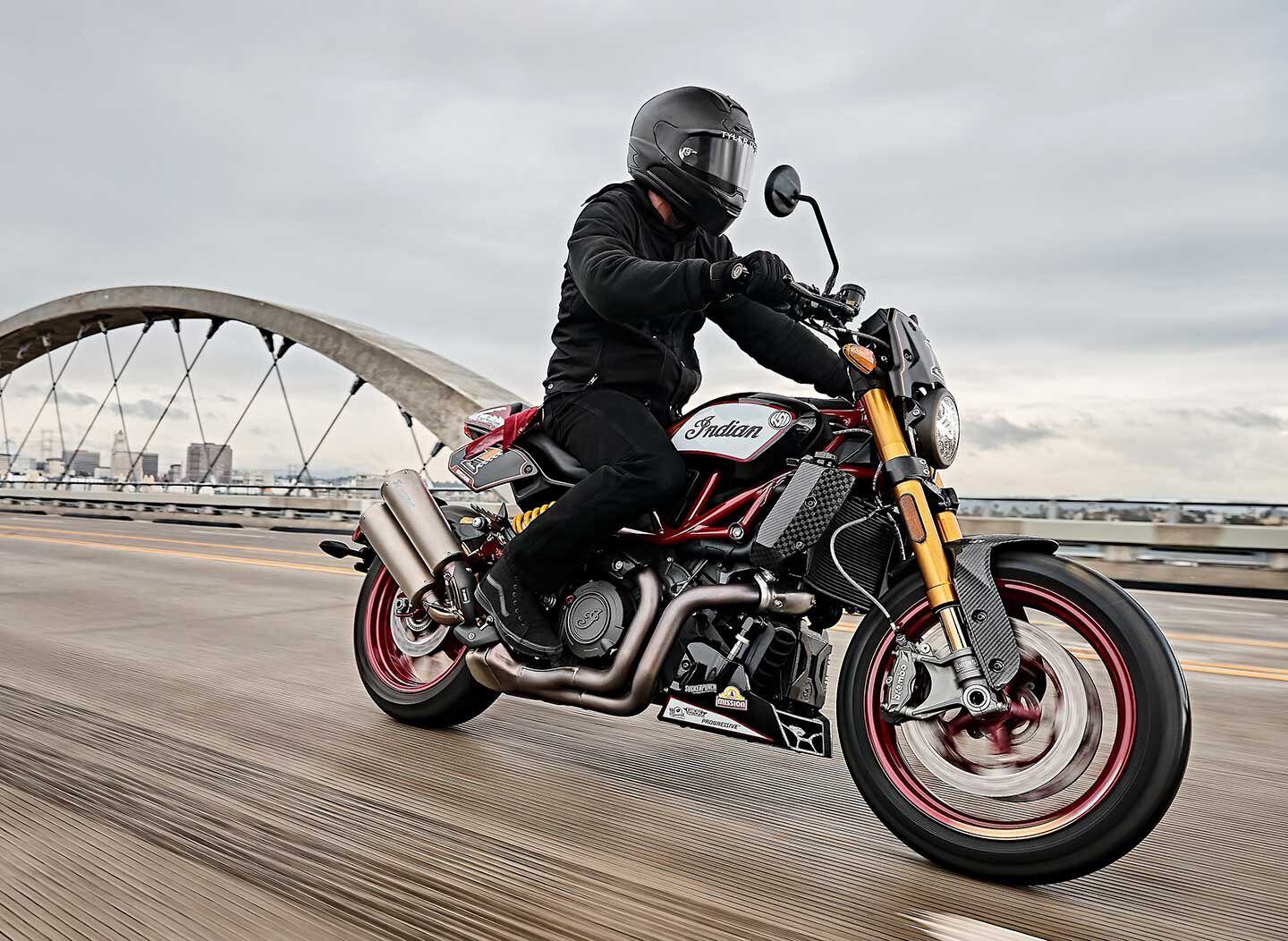
Indian’s new 2024 FTR x RSD Super Hooligan pays tribute to the brand’s 2023 SHNC series crown. (Indian Motorcycle/)Last year, Indian announced a limited-edition FTR bike that was tricked out by the action-sports brand 100% for the 2024 model year. That bike was a legitimately striking, carbon fiber–clad machine, but it also led us to wonder, hey, where’s the collaboration with Roland Sands? After all, the dude basically created the Super Hooligan category (welcoming the FTR750 in the process), which Indian is currently the main sponsor of. And the fact that Tyler O’Hara aboard an Indian FTR 1200 won MotoAmerica’s 2023 Super Hooligan National Championship crown seemed like there was a turn-key partnership waiting in the wings.
Well, it looks like we didn’t have to wait long for the obvious to unfold: Here’s the new FTR x RSD Super Hooligan, available now, but in limited quantities.
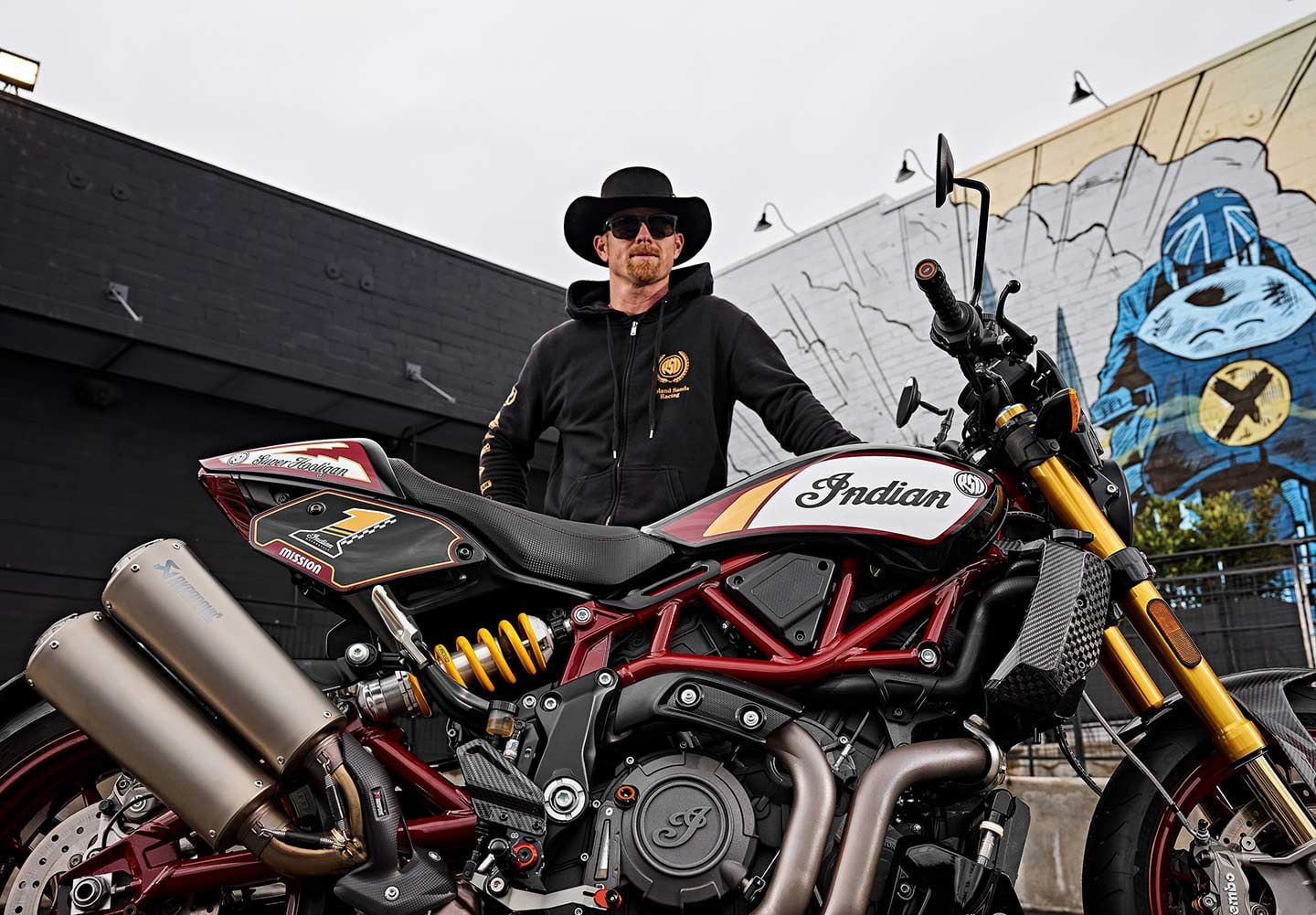
The limited-edition FTR x RSD Super Hooligan model should be in dealers now, but only 300 units will be available worldwide. (Indian Motorcycle/)If the term “hooligan” conjures up images of older air-cooled V-twins banging bars around a dirt track, well, we’ll have you know it has since evolved into a professional series, complete with rules and regulations. To its credit, Indian has managed to stay in the thick of things, and it was looking to celebrate last season’s SHNC victory with a bike that put a spotlight on that crown. That bike is the 2024 FTR x RSD Super Hooligan you see here, designed in concert with longtime collaborator Roland Sands and his merry band of motoheads.
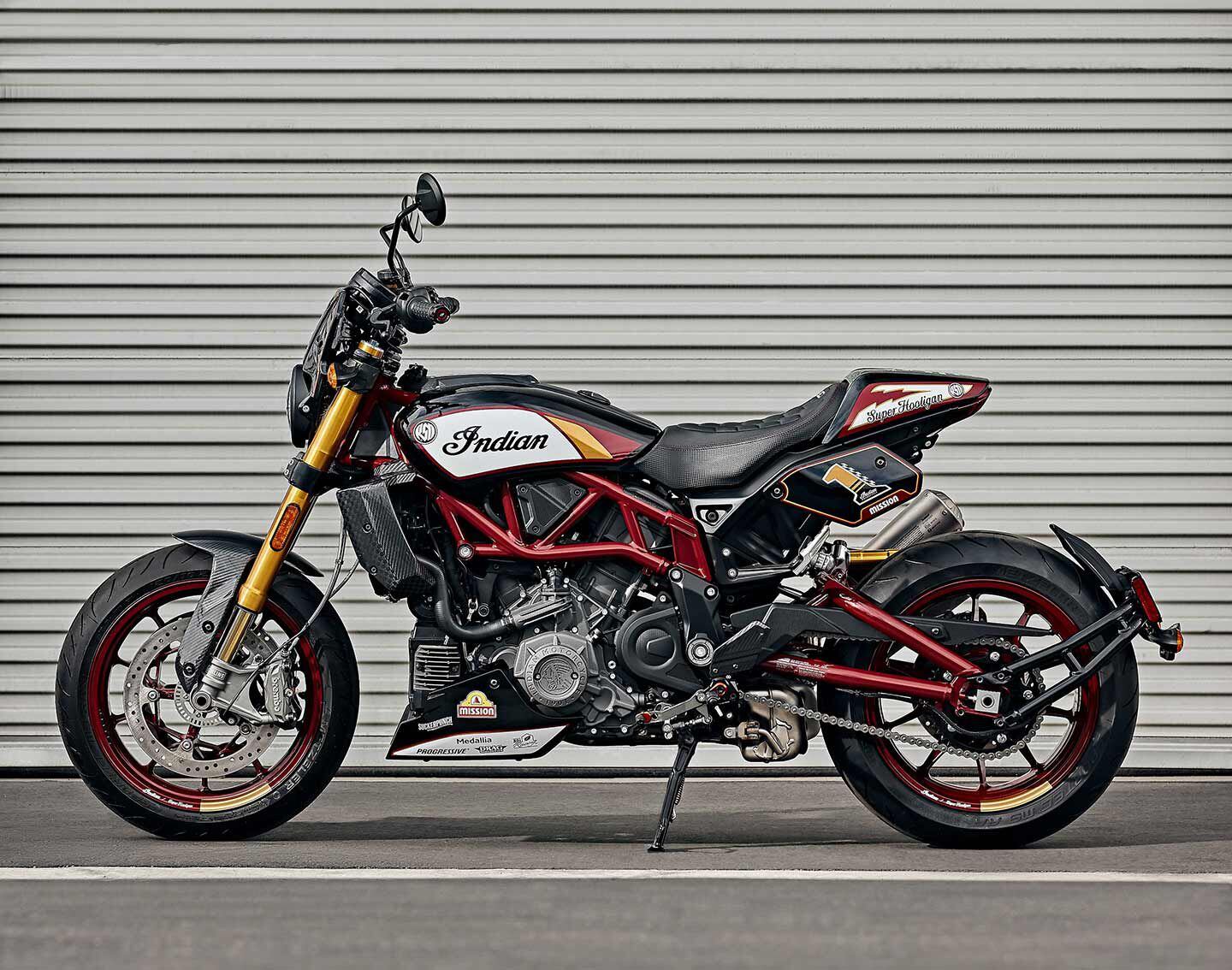
An Indian Red frame and special Black Metallic bodywork plastered with the No. 1 plate, and race sponsor and Roland Sand logos tell you this is the FTR x RSD model. (Indian Motorcycle/)Indian calls it “all-new,” but let’s dispense with that notion pronto; this one (like the 100% bike) is also based on the premium FTR R Carbon model, which already rocks 17-inch wheels with sport tires and fully adjustable suspension.
The carryover parts continue under the new colors and engine covers, with the same 120 hp, liquid-cooled 1,203cc V-twin engine and steel trellis frame, fully adjustable Öhlins front fork and rear piggyback shock, radially mounted dual disc Brembo brakes, and a 4-inch touchscreen display powered by Indian’s Ride Command system which also allows access to three selectable ride modes. An assist/slip clutch eases shifting duties, and as before, Metzeler Sportec rubber rolls below. Like the R Carbon (but unlike the 100% model), the RSD’s shock sports bright yellow coils, and a dual Akrapovič muffler setup shores up the right side.
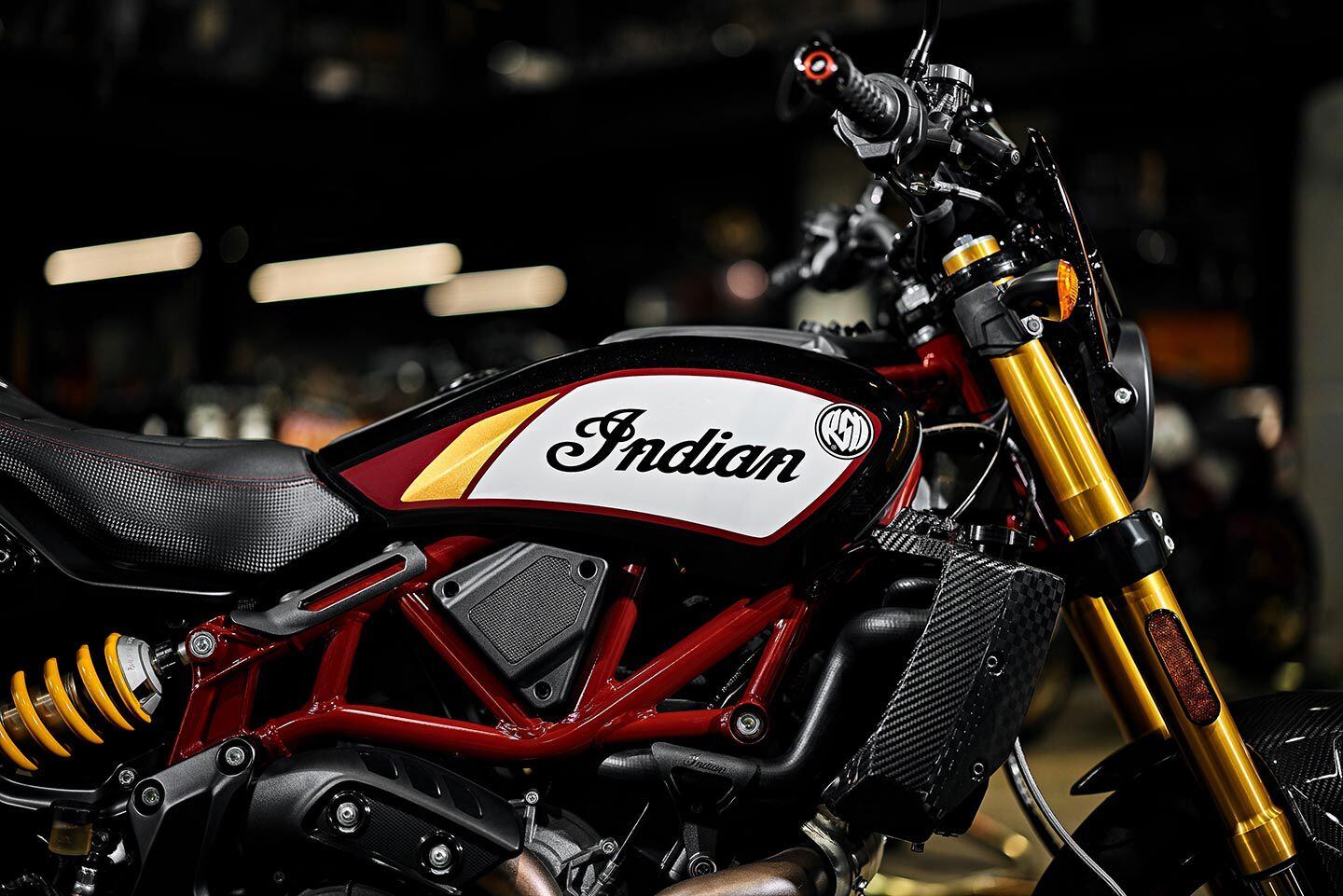
The FTR x RSD’s tank gets the Indian race team colors and is set off by carbon-fiber-ish accents. (Indian Motorcycle/)So let’s get into what separates the FTR x RSD Super Hooligan from its lesser stablemates.
For one, there’s the unique paint and graphic treatment, with killer Black Metallic bodywork pieces covered in real-deal Indian team colors and Super Hooligan race graphics. The underlying frame is dipped in classic Indian Red for contrast, and the matching red cast wheels feature gold accents. Since that SHNC No. 1 plate is a big deal, Indian pushes the team’s recent victory via championship logos and the number on the front and side plates. Continuing the replica racer theme, the FTR x RSD Super Hooligan sports race team sponsor logos on the rear seat cowl; owners will also receive additional graphics for the radiator shroud, front fender, and front fork if they want to really sell the look.
The team also added premium Gilles Tooling parts, including adjustable rearsets, oil cap, radiator cap, and bar-end weights, to give that extra veneer of exclusivity. And because this is a limited-edition bike, each one is individually numbered with a commemorative tank console.
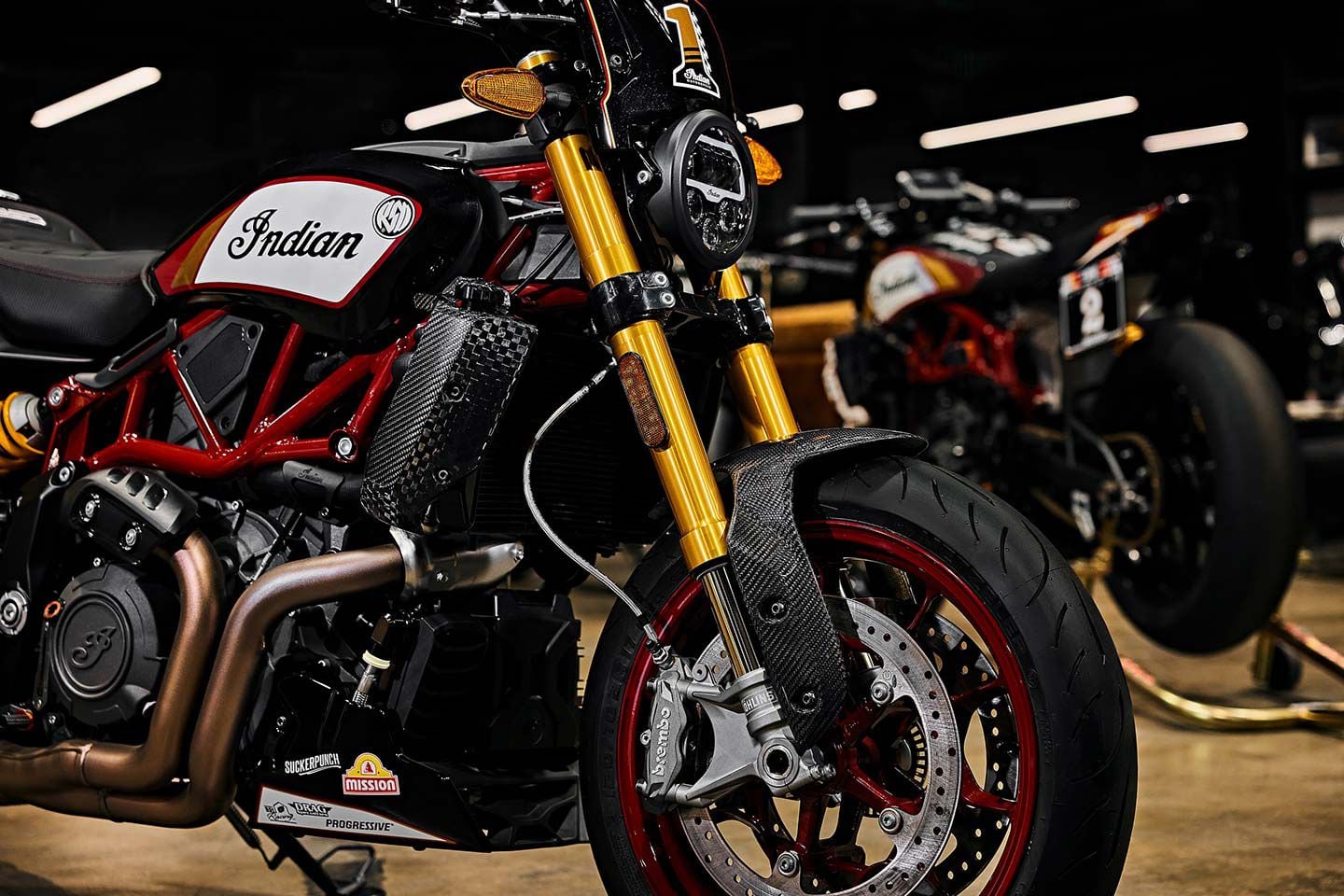
As on the R Carbon trim, you get dual disc Brembo brakes up front; Öhlins USD fork and rear IFP shock are also fully adjustable. (Indian Motorcycle/)Indian says the FTR x RSD Super Hooligan bike is now shipping to dealers throughout the US and Canada, and has a starting MSRP of $18,499. Just 300 units will be available globally. For more info see indianmotorcycle.com.
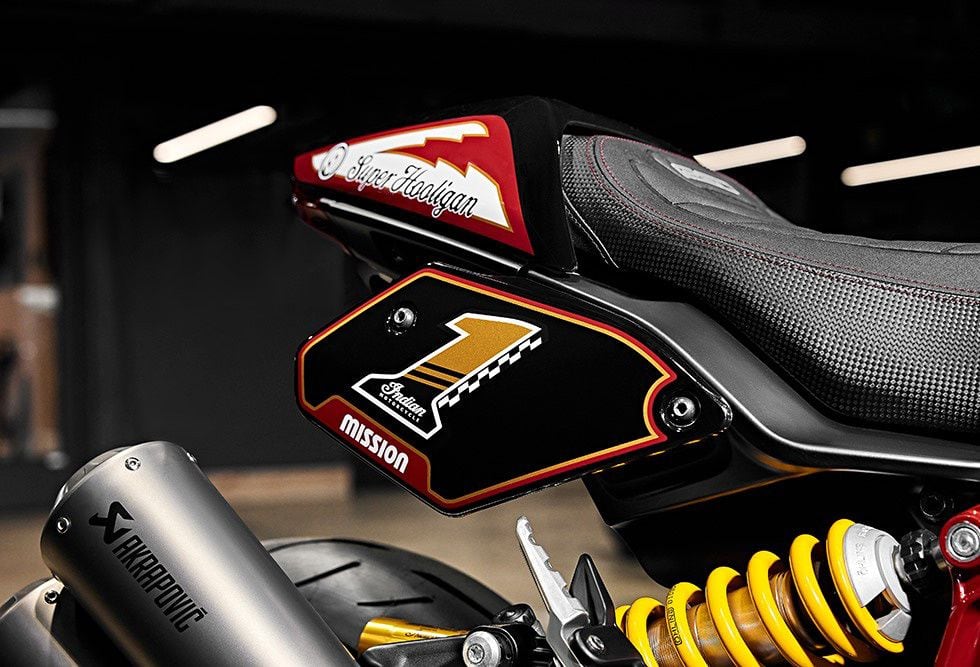
In case you forgot, Indian snagged the 2023 Super Hooligan National Championship. Special seat gets contrast red stitching. (Indian Motorcycle/)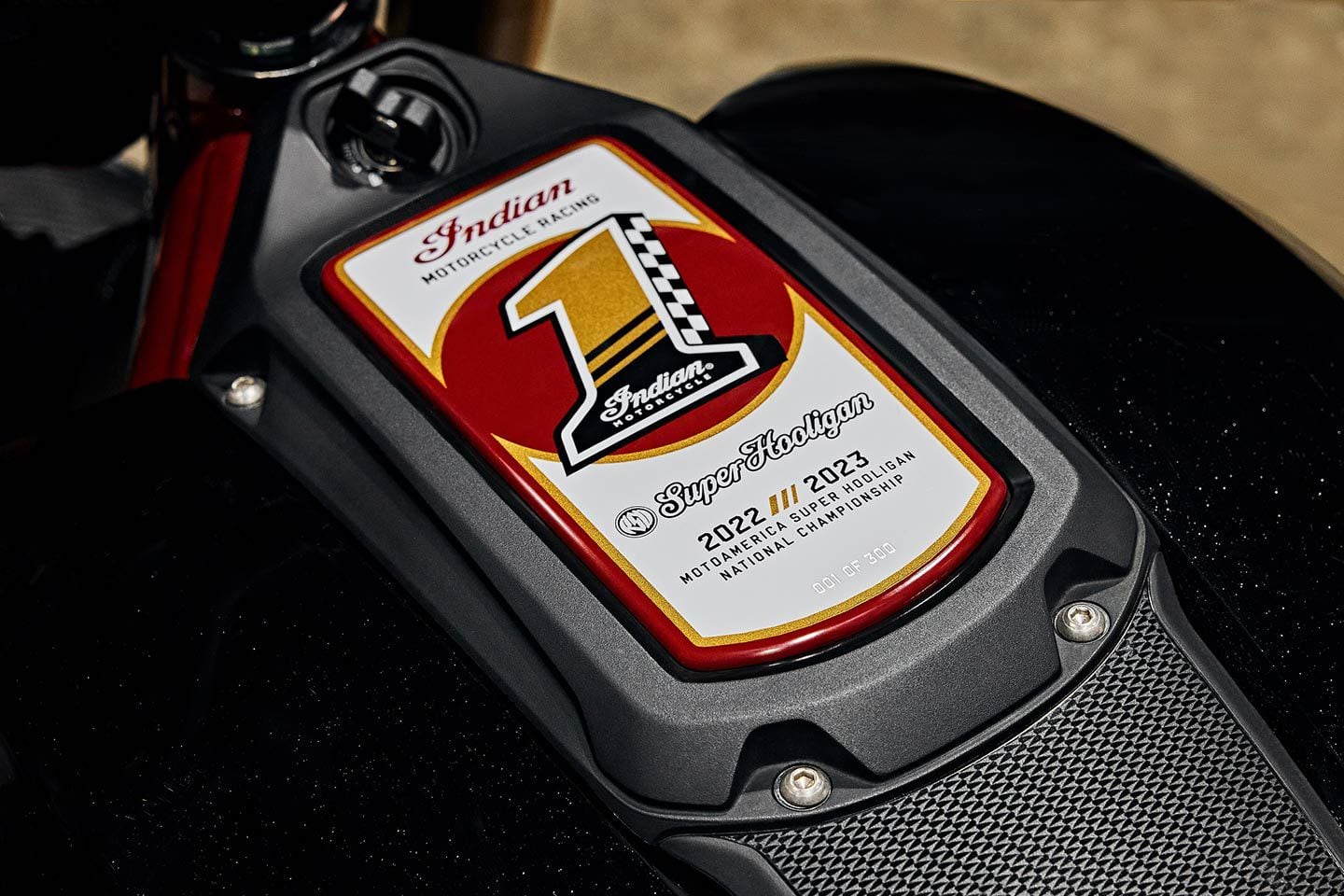
Commemorative badge on the tank console indicates unit number and RSD/Super Hooligan provenance. (Indian Motorcycle/)2024 Indian FTR x RSD Super Hooligan Specs
MSRP: $18,499 Engine: 1,203cc, liquid-cooled, 60-degree V-twin Bore x Stroke: 102.0 x 73.6mm Compression Ratio: 12.5:1 Claimed Horsepower: 120 hp @ 7,750 rpm Claimed Torque: 87 lb.-ft. @ 6,000 rpm Transmission/Final Drive: 6-speed/chain Fuel Delivery: Closed-loop electronic fuel injection w/ 60mm throttle body Clutch: Wet, multiplate slipper/assist Front Suspension: 43mm Öhlins inverted telescopic fork, fully adjustable; 4.7 in. travel Rear Suspension: Öhlins piggyback IFP shock, fully adjustable; 4.7 in. travel Front Brake: 4-piston calipers, dual Brembo 320mm discs w/ ABS Rear Brake: 2-piston caliper, Brembo 260mm disc w/ ABS Wheels, Front/Rear: Cast; 17 x 3.5 in. / 17 x 5.5 in. Tires, Front/Rear: Metzeler Sportec M9 RR; 120/70ZR-17 / 180/55ZR-17 Rake/Trail: 25.3°/3.9 in. Wheelbase: 60.0 in. Ground Clearance: 6.5 in. Seat Height: 32.3 in. Fuel Capacity: 3.4 gal. Claimed Dry Weight: 491 lb. Contact: indianmotorcycle.com

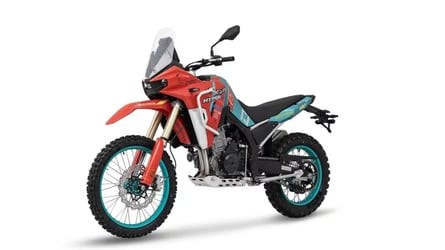
2024 KTM 1390 Super Duke R Evo First Ride Review
in Motorbike news
Posted
KTM refers to the 1390 Super Duke R Evo as “The Beast”—a fitting nickname. (KTM/)
The beautiful thing about the Super Duke platform is that it wasn’t built around a rule book. Whereas most nakeds and hyper-nakeds trace their roots back to engines, chassis, and electronics developed for race-bred sportbikes, the modern Super Duke was built on hooligan bones. It is not a sportbike with fairings peeled off—it’s a purpose-built troublemaker with enough performance to camouflage itself as something more than that.
If the rest of the Duke lineup is KTM being practical and business savvy, then the Super Duke is the company cutting loose and having a little fun. The question then becomes, is there such a thing as too much fun?
Two color options for the 1390 Super Duke R Evo—KTM orange or black. Starting price is $21,499, but you’ll probably want to add the KTM’s optional electronic and suspension packages. (KTM/)
About the Bike
KTM laughs at that question, but acknowledges that this is a streetbike, and that rideability matters, given that you can’t always ride at a flat-out, tire-smoking pace. The 2024 1390 Super Duke R Evo addresses that elephant in the room while building on KTM’s “more is more” philosophy. It’s an increasingly potent and more sophisticated motorcycle than the 1290 it replaces, but with tech that’s intended to give it a polished finish.
The 1390′s shift in personality starts with the 1,350cc V-twin, which has a 2mm larger bore than the 1290′s mill (108mm versus 110mm) for an added 49cc. KTM claims 190 hp at 10,000 rpm and 107 lb.-ft. of torque at 8,000 rpm—a healthy bump over the 1290′s claimed 177 hp and 103 lb.-ft. of torque.
The 1,350cc V-twin might not match up with the 1390 name, but it does make more power than the 1,301cc LC8 used in the 1290. KTM claims 13 more horsepower and an additional 4 lb.-ft. of torque. (KTM/)
For reference, consider that our 2023 1290 Super Duke R Evo testbike made 157 hp and 92.8 lb.-ft. of torque at the rear wheel when strapped to our in-house dyno. That’s less horsepower than the Ducati Streetfighter V4 SP2 (172.8 hp) and BMW M 1000 R (185.1 hp), sure, but the 1290 made roughly 17 more pound-feet of torque than those bikes on the same dyno (76.2 lb.-ft. for the BMW and 75.2 lb.-ft for the Ducati). Now, there’s even more of that good stuff.
Why? Because KTM can, and because torque is what makes the bike fun to ride according to KTM development rider and motorcycling legend Jeremy McWilliams, who talked us through the package. “The horsepower is pretty insignificant. It’s how the bike produces its midrange that makes it fun,” McWilliams says.
Related: KTM Goes Big With the 1390 Super Duke R Evo for 2024
KTM’s camshaft technology works on the intake side. The electronically actuated system switches from a mild cam lobe to a more aggressive lobe just below 6,000 rpm. (KTM/)
There’s more to the story though, as the 1390 is equipped with an electronically actuated cam-shift technology that adjusts intake valve timing (duration and lift) between 5,750 and 6,000 rpm. A similar solution to what BMW uses across various engine platforms, the system consists of an electronic actuator atop each cylinder, pins, and a sliding sleeve on the intake cam. Dropping the pin engages a switching gate on the sliding piece, engaging different cam profiles.
KTM’s variable valve timing technology enables the engine to have good low-rpm torque and throttle response without sacrificing top-end performance. It also allows KTM to meet strict Euro 5+ emissions standards without losing the thing that has always made the Duke, a Duke—personality.
Power is further manipulated through shorter, but larger-diameter throttle bodies (60mm versus 56mm on the 1290 Super Duke R) and repositioned injectors. The airbox is shorter to accommodate the 1390′s larger tank, but has more volume. A redesigned ram-air system allows for more direct airflow too.
Service intervals and valve clearance checks are increased to 60,000 kilometers, or right around 37,000 miles, which is a massive bump over the 30,000 kilometers (~18,641 miles) recommendation for previous-gen Super Dukes.
The 1390’s larger-volume air box is wider and longer, but shorter to accommodate the 1390’s larger fuel tank. (KTM/)
The chassis is the same as it was in 2023, with small revisions made to accommodate the reshaped airbox. When asked the reason for not making any changes, McWilliams said that KTM made necessary chassis changes during the previous Super Duke update.
“Going back to 2016/2017, on the street [the bike] was really awesome; very forgiving, nimble, and agile,” McWilliams says. “But when we took the bike on track and put supersticky tires on it, we could make the chassis do some things—move around a little bit. The technology of the motor was moving forward, and we felt that we needed to address the chassis, to make it stiffer.”
The 5-inch TFT display is crystal clear, easy to navigate, and has illustrations to better understand the difference in options. Notice the expansive options within the new WP Apex electronic suspension, as well as the older switch cube on the left side of the handlebar, which is used to scroll through those options. (KTM/)
KTM tested a modified chassis ahead of the 2020 launch and McWilliams went a full second quicker at the track. “That number went back to the factory, the factory measured it, found out what it was, and produced this chassis,” McWilliams says. “We put a 30 percent stiffer swingarm on it at the same time, and all of a sudden we’ve got what we feel is the best chassis for this torque output. We didn’t need to change that for this bike.”
Suspension is new, KTM moving to WP’s latest-generation Semi-Active Technology (SAT), which continues to feature electronic rear spring preload and is managed through five standard damping modes (Auto, Comfort, Rain, Street, and Sport).
Closer look at the Super Duke’s display. (KTM/)
Moving up to KTM’s optional Suspension Pro package opens the door to customizable Track and Pro suspension modes. It also adds three preload auto-leveling settings (Low, Standard, and High), and an anti-dive setting that keeps the front end up under braking. The other new feature? Factory Start, which lowers the rear of the bike when launch control is activated. Yes, we know we said this was a streetbike first.
More electronics come in the form of a very traditional rider-aid package, complete with three preset, nonadjustable rider modes: Rain, Street, and Sport. KTM’s optional tech pack opens the door to Performance and Track modes, which can be modified to your liking, with adjustments for traction control, engine-brake control, and wheelie control. “Anti-Wheelie Mode” is revised for 2024 and can now be set to one of five levels, plus off. Levels include: Very low (0.36 degree), Low (2.0 degrees), Medium (11.1 degrees), High (15.5 degrees), and Very high (22.25 degrees).
Related: Aprilia Tuono V4 Factory vs. KTM 1290 Super Duke R Evo vs. Yamaha MT-10 SP: Hyper-naked Comparison
The 2024 Super Duke has a 0.4-gallon-larger fuel tank and a few new styling touches, like winglets (just below the tank spoiler). Yes, this is a bike made for wheelies, but with winglets that are intended to keep the front down. You could say the same thing about traction control too. (KTM/)
Electronic settings (and other important information) are relayed via a 5-inch TFT display with crisp, clear image and user-friendly layout. Unfortunately, the switch gear found on KTM’s new 990 Duke hasn’t been carried over—a shame considering how well we liked the button layout on the new 990.
There are some similarities to the 990, mind you, the biggest being the new, adaptive LED headlight that’s 1.5 pounds lighter than the previous headlight and has a more even light spray. Tank spoilers and winglets add an extra dimension in addition to “increased downforce,” KTM says. That’s not a huge thing for the casual street rider, who will be happier to hear that the fuel tank is roughly 0.4 gallon larger.
The Super Duke isn’t short on sharp lines. Notice the low handlebar, which KTM transitioned to years back for a more aggressive riding position. Despite the low bar, this is still a very comfortable motorcycle. (KTM/)
Riding Impressions
The 1390 is physically larger than the 990 Duke that sits below it and has a more spacious cockpit, which is nice if you’re over 6 feet tall. It’s a very comfortable motorcycle, with parts that hint at its aggressive side (a low, narrow handlebar), while others demonstrate its more relaxed side (a wide, flat seat). In this case, we’d be making the most of that more aggressive side, as KTM scheduled for us to ride the bike at the fast-but-technical Almeria Circuit in southern Spain.
Despite all the talk of this being a streetbike, it has to be said that the Super Duke R still looks decidedly racy sitting with its mirrors off, prepped for track duty. There might be a few less fairings, and ergos that are more street-focused, but don’t write this bike off as a commuter.
KTM doesn’t have a full-fairing sportbike in its lineup, making the 1390 Super Duke R the go-to option if you want to experience that big LC8 twin at the track. Lots of testing, with legendary rider Jeremy McWilliams, has led to a bike that doesn’t feel out of place banked into a corner. (KTM/)
The engine plays into that, offering more laughs per throttle turn than almost anything else out there. This is a bike that excites you with its angry drive off every turn, versus an ability to start blurring objects on the backside of the straightaway with quick-revving, high-rpm velocity. The Ducati and BMW still feel more apt at that.
There’s still literbike power, McWilliams joking that during testing, they dressed up the 1390 prototype as a 1290 and went to the track. “The guys on the Panigales started asking us questions because now you’re passing bikes that we weren’t passing on 1290s.”
The Super Duke steers quite quickly when ridden at a track pace, making it easy to flick into a corner or even change your line, midcorner. (KTM/)
Earlier tests weren’t as smooth, McWilliams admitting that torque delivery needed to be smoothed out as the valve timing changed. “When the cam-shift came in, it was like another level. I’d liken it to riding a 500cc MotoGP bike back in the days on two-strokes when we had that powerband. We had this huge step of torque. I was loving it, but I came back and said this is crazy, we’ve got to control this a little bit. We need to make this less aggressive when the camshaft comes in.”
In final form, the cam-shift function is so smooth that—at least on the track—you can’t feel or hear the shift. All you recognize is the seamless throttle transition and abundance of torque as you tear through the midrange. The shock and awe lasts for as long as it takes to get the bike stood up straight and for you to catch your breath. This feels like being strapped into an F-18 and launched from the catapult system of an aircraft carrier.
This is what the 1390 Super Duke R Evo is all about—wheelies! Not used here is a new anti-wheelie system that can be adjusted when the optional electronics package is added. Given the performance of the bike and how it’ll be used a majority of the time, we wish that package came standard. It’s hard to picture riding the Duke without being able to fine-tune settings. (KTM/)
Things ease up at a more mellow pace, proving that the Super Duke can be enjoyed even when not being hustled around a track at speed. Hopefully this rings true in street riding too. We’ve never had qualms with the Super Duke’s throttle response or power delivery, any extra gains here will be icing on the cake.
Chassis-wise, the Super Duke is still a handful. It’s nimble and flicks into corners with ease, but is on edge when ridden aggressively. It shakes its head and pumps to tell you that you weren’t as smooth as you should have been with throttle inputs, while also giving a very rigid sensation when the front tire is loaded at corner entry. It’s got intentions of going fast, but always makes you feel like it’s a bit angry it has to do so. It would rather do wheelies and have fun.
That said, our day was impacted by rain and a tight testing schedule. With more time to focus on the WP Apex suspension, we’d likely have found a better setting and talked the Super Duke into playing nice.
Despite the addition of variable valve timing, the Super Duke is still quite rowdy. Credit the massive amounts of torque that KTM continues to dump into this package. (KTM/)
The shortened schedule didn’t provide enough time to test the full range of electronics, but a few things did stand out in our time with the bike. First, this is a very intuitive system that was clearly designed by engineers who ride. Submenus are easy to navigate and everything is right where you’d expect it to be. The bike uses KTM’s older-generation, joystick-style switch cube that’s less user-friendly than the newer, four-button cube on the 390 and 990 Duke, but the setup gets the job done and will work until the Super Duke gets upgraded.
Electronic intervention is smooth, without any long, choppy cuts that hurt forward momentum. KTM might not have any production-level racebikes to pull rider aids from, but that hasn’t stopped it from building a package that’s essentially on par with the competition.
The 2024 Super Duke was launched as part of KTM’s “30 Years of Duke” celebration. The first Duke was built in 1994. (KTM/)
Final Thoughts
There are many more comparisons to draw between the Super Duke R Evo and the high-strung hyper-naked bikes like the Streetfighter V4 SP2, BMW M 1000 R, and Aprilia Tuono V4 Factory, not to mention the handful of other legitimate high-performance nakeds, like the Yamaha MT-10 SP. The Super Duke R sets itself apart though with a sense of hooligan-ness that can only come from a bike that was born without fairings. And only a bike with KTM badges on its tank.
Yes, there are better options for chasing fast, consistent lap times at the track, but very few (if any) will make you feel the way that the Super Duke does. This is a bike you’d take to ride with your friends and have fun, knowing that there’s more than enough performance to push the limits if and when you desire. It’s proof that there’s no such thing as too much fun—something KTM has known all along.
2024 KTM 1390 Super Duke R Evo Specs
More wheelie! (KTM/)
Gearbox
Helmet: Arai Corsair-X Nicky Reset
Racing Suit: Alpinestars Racing Absolute V2
Gloves: Alpinestars GP Tech V2 S
Boots: Alpinestars Supertech R
View the full article